Nyah Smith and Jules Jefferson elected as Student Body President and Vice President
LUKE MACY ASST. CAMPUS & COMMUNITY EDITOR
On Dec. 12 and 13, 2022, Ginny Boehme, along with some of her Miami University colleagues, traveled to Columbus, Ohio, to testify before the State Employment Relations Board (SERB).
Boehme and her colleagues were there with the Faculty Alliance of Miami (FAM) advocating for teaching clinical professors and lecturers (TCPLs), instructors, visiting assistant professors (VAPs) and librarians to be included in FAM’s proposed collective bargaining unit.
Boehme, a science librarian at Miami, testified to SERB about responsibilities, promotion and the continuing contracts system within Miami’s libraries, arguing that these shared similarities with full-time faculty.
So when SERB announced on March 9 that librarians, along with VAPs, would not be allowed to participate in the proposed union, Boehme was disappointed.
MEGAN MCCONNELL ASST. CAMPUS & COMMUNITY EDITOR
Nyah Smith and Jules Jefferson have been elected Miami University’s Student Body President (SBP) and Vice President for the 2023-2024 academic year, making Miami history as the first elected all-Black ticket.
The pair won against Cameron Tiefenthaler and Grace Payne with 68% of the vote. After the announcement, Smith and Jefferson were applauded by friends and supporters in Armstrong Student Center. The two said they were at a loss for words.
“Grateful. Honored,” Smith said.
“Blessed,” Jefferson interjected.
Several of Jefferson’s family members attended Miami, including her mother, sister and cousin. But as a Black, female biochemistry and nutrition double major, Jefferson said the idea of being elected Vice President was wild. Smith agreed and said she was told by a college planner in
high school to expect a denial letter from Miami.
Now, the two sit as Miami’s president and vice president elect.
Smith said the support from student organizations around campus was overwhelming, with 18 total endorsements including those from the Asian American Association, The Miami Student and Black Student Action Association.

“As a SEAL [Student Engagement and Leadership], that just meant the world to me because I’ve spent my whole time at Miami loving student organizations,” Smith said. “To get that support back means a lot to me.”
Smith and Jefferson’s campaign was based on three pillars: sustainability and infrastructure, unity and student empowerment.
The pair also focused on reaching out to groups that weren’t normally targeted by the Associate Student Government (ASG), such as international students and athletes. In their campaign video, the pair had a sign
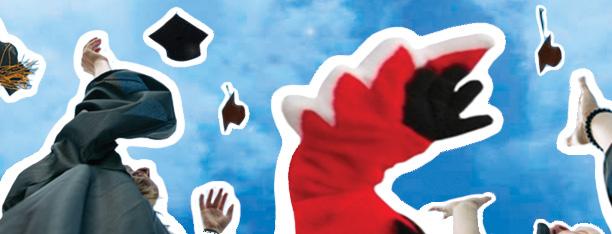
language interpreter and various foreign languages available — Vietnamese, Russian, Italian, Spanish and Fulani — to remain accessible.
“Everyone deserves to have a seat at the table, and I think that’s what we’ve been trying to say for the past three weeks,” Smith said.
Looking back on the last several weeks, Smith said she was especially proud of their commitment to a natural-hair campaign.
“Going to a PWI [predominately white institution] as a Black woman is hard,” Smith said. “And so, to have a big dream of running for Student Body President and Vice President, we did it. Natural and all.”
After returning from spring break, Smith and Jefferson are excited to begin working and collaborating with administration and students across campus and to begin “building the table,” which was outlined in their campaign.
The pair hopes to create a semesterly campus-wide service project, an


ASG open forum, a career clothing closet and green event funds and resources. Smith and Jefferson also plan on implementing semesterly mental health screenings and community service opportunities to help students pay off parking tickets.
“I’m excited to have more voices at the table because I think that’s possible,” Smith said. “I know that’s possible. I’m excited to represent the various communities at Miami. I’m excited to bridge the gap between resources and to provide more resources for students because I think that’s one of the things that we really focused on.”
For now, Smith and Jefferson said they appreciate the voters, and hope to see even more students vote in future elections.
“Thank you to the voters,” Smith said with Jefferson nodding in agreement.
mcconnmn@miamioh.edu
connected so well:’ First-year student joins band
“It just felt like all of the work that we had done to get to this point was basically all for nothing,” Boehme said. “It was really, really disappointing and then to actually read through the decision and the reasoning behind it was just another slap in the face.”
SERB’s decision included points such as librarians’ 12-month contracts as opposed to faculty members’ nine-month contracts and librarians’ similarities to unclassified administrative staff.
However, Boehme said the judge for the decision included some inaccurate points, such as librarians being paid hourly — Boehme said librarians are salaried employees — and others that demonstrated a lack of knowledge for what librarians do.
“There seemed to be a fundamental misunderstanding of what we do and how our teaching is compared to the faculty teaching. I mean, it is different, but it is still teaching,” Boehme said. “It really seemed like he didn't understand most of the similarities that we share with the faculty.”
In an email to The Miami Student, Jessica Rivinius, vice president and chief marketing communications officer, wrote that Miami agreed with SERB’s decision, saying the university doesn’t believe faculty, librarians and VAPs share enough similarities to make up a single collective bargaining unit.
“While each of these positions plays a critical part in furthering our University mission and delivering academic excellence to our students,” Rivinius wrote, “Miami believes the experiences across these various groups vary drastically and would not allow for an effective collective bargaining agreement to be reached if a faculty union was established.”
SERB’s decision excludes around 30 university librarians from being part of FAM’s proposed union. Boehme was not the only librarian disappointed with SERB’s ruling.
Rachel Makarowski, a special collections librarian, although sad about the decision, didn’t let it keep her down.
“At first I was a little disappointed,” Makarowski said. “After that feeling of disappointment, when that passed, I was like, ‘Okay, I guess we're organizing the librarians under our own contract with FAM.’”
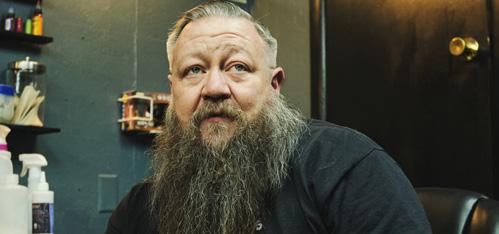
Makarowski has been helping FAM for more than a year. Although she can no longer be included in the proposed union, she still continues volunteering.
EMILY SIDERITS

THE MIAMI STUDENT
While most students join clubs and organizations their first few weeks of school, first-year finance and business analytics major Umaansh Parashar joined a band.
Parashar knew he wanted to be a part of Bananarchy from his first rehearsal performance with them. He showed up for the first performance at guitar club having only met the lead singer.
“I get there on a Monday night at Kumler chapel,” Parashar said. “I meet the members for the first time. We've never played together. There's songs I've never played before. [The first song] was ‘Begging’ by Måneskin, and I know that song by heart, so I was able to get in with it, but it was right when we started playing. Everything just connected so well.”
Parashar got connected to Bananarchy through Rocktober Fest organized by High Street Records, where he learned they had an opening for a drummer.
Bananarchy formed in the fall of 2021 when guitarist Jack Weber and bassist Cory O’Brien joined forces to create a group for Battle of the Bands, organized by the guitar club. The two had met in class, and Weber introduced O’Brien to Miami's guitar club.
The current members consist of guitarists Weber and Luke Thorne, bassist Cory O’Brien, lead singer Jordan Mtui and drummer Parashar.
Joining a band that was established a year ago may seem daunting, but Parashar felt confident in his musical background. In addition to playing drums for the past decade, Parashar also had experience performing in front of live audiences.
“In high school, I played for this thing called the School of Rock Cincinnati,” Parashar said. “I used to take lessons there and play with their house band. We used to have gigs in all parts of Cincinnati in different venues, different bars. So that really helped me build that performance skill.”
Bananarchy received the runner-up title for best performance

band and won best dressed as they dawned all yellow at the Battle of the Bands last semester. The band performs once a week for the guitar club and plays rock covers from artists like Arctic Monkeys and Jet. Although they don’t currently have any original songs, they’ve expressed interest in creating original music.
In addition to their weekly performances at guitar club, the band is looking to book more shows at local bars.

“There's been other bands, like I know there's one called the Thumbtack Mechanics that recently just played at Brick, so there's definitely a lot of uptake and they did sell out, so that means there's definitely an audience for us,” Parashar said.
All the members involved have majors outside of music, so playing for them is a fun hobby that brings the group together.
“We just had this special connection,” Parashar said. “We just clicked, and the chemistry just hit different.”
siderie@miamioh.edu
“Even though the TCPL and tenure-track folks are the only people who are in the determined unit, that still doesn't detract from the fact we’re still one union,” Makarowski said. “So to me, continuing with volunteering just really helps to cement that the fight isn't over.”
Rivinius wrote in the same email that the university will still work with those not recognized in the collective bargaining unit.
“While the election moves forward with tenured and tenure-track and TCPL faculty only, we will continue to support and work openly with all faculty, Librarians, and those in Multiple Appointments through our model of shared governance,” Rivinius wrote.
For librarians like Boehme, though, the SERB hearing made some at the university feel as if they do not have the same recognition from the university as others.
“It's always been described in a really, really horrible tongue-incheek sort of way as separate but equal and that's what it feels like,” Boehme said. “We are second class citizens to the university when we still have all the same responsibilities and processes as true faculty.”
Librarians disappointed by SERB decision for unionization
macylj@miamioh.edu Volume 151 No. 12 ESTABLISHED 1826 OLDEST COLLEGE NEWSPAPER WEST OF THE ALLEGHENIES Miami university — Oxford, Ohio FRIDAY, MARCH 17, 2023 In this issue HUMOR St. Patrick’s Day as a Patrick - page 8 OPINION Saying good-bye to our seniors: graduating seniors' personal columns - page 13 PHOTO A day in the life of Maggie Murphy - page 16 STYLE The expressive art of tattoos - page 9 ENTERTAINMENT The evolution of listening to music in college - page 6 CAMPUS & COMMUNITY ‘Very stressful, very difficult and expensive”: Navigating the Oxford housing market as a student - page 5
NYAH SMITH AND JULES JEFFERSON CELEBRATED WITH FRIENDS AND SUPPORTERS AFTER WINNING STUDENT BODY PRESIDENT AND VICE PRESIDENT, RESPECTIVELY. PHOTO BY JAKE RUFFER
‘Everything just
LEAD SINGER JORDAN MTUI PERFORMS WITH HIS BAND BANANARCHY. PHOTO BY EMILY SIDERITS
Coming Up...

ASG meeting covers understaffing at fire department, shooting at MSU and classes on Election Day
KASEY TURMAN
THE MIAMI STUDENT
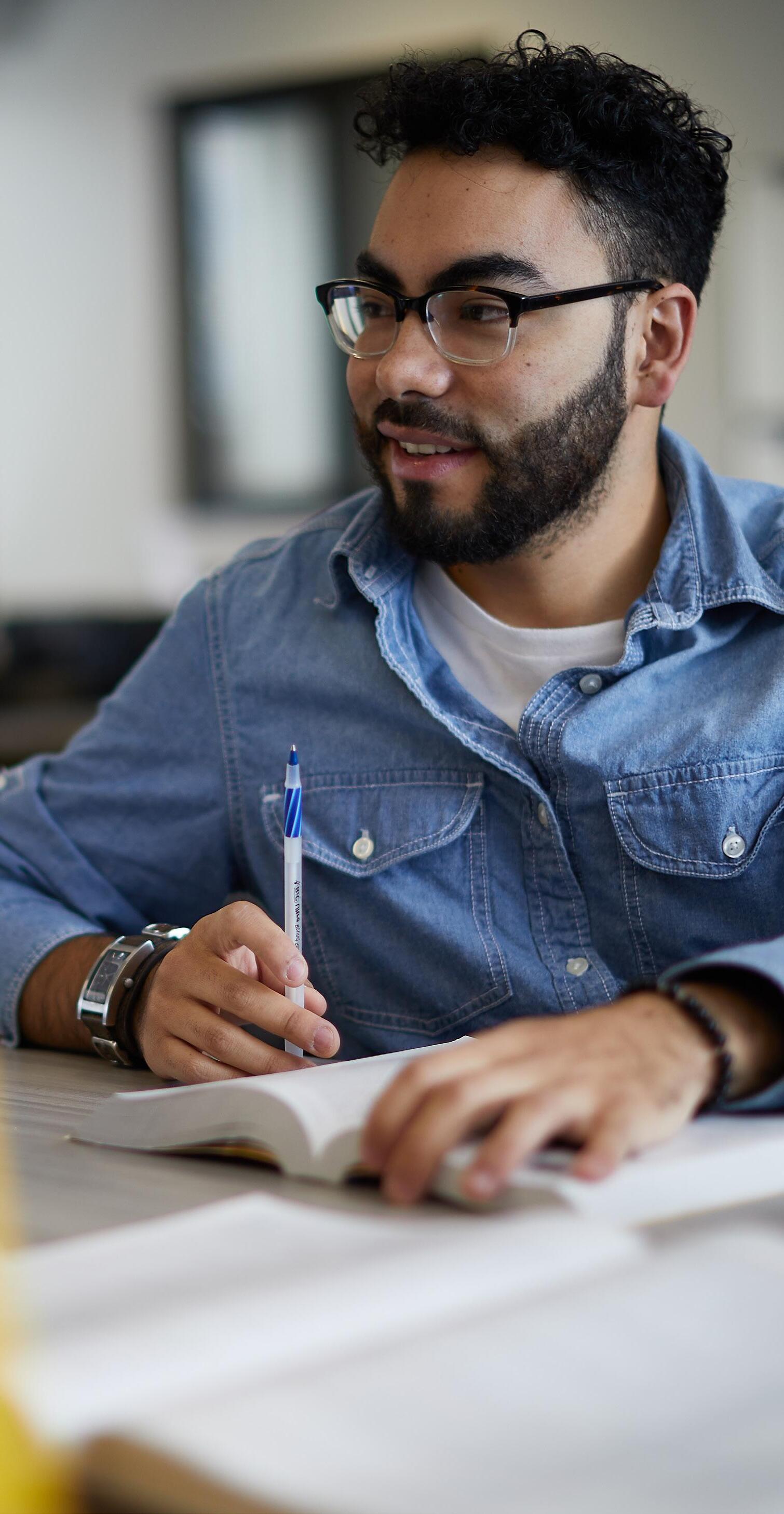
The March 14 meeting for Miami University’s Associated Student Government (ASG) included presentations from both Mayor William Snavely and Oxford City Councilor Jason Bracken about the funding issues facing the Oxford Fire Department.
“The fire department is currently down six firefighters and EMS (emergency medical services) responders,” Snavely said. “We have what’s needed for minimal community service.” Snavely said the Oxford Fire Department covers not only Oxford but the neighboring townships as well. These townships are then billed by the fire department for the percentage of responses that go to those areas. This is calculated based on the total number of calls.
Miami is not included in this percentage-paying system because the university falls under Oxford city limits. With the mass amount of calls sent to campus, the fire department does not see compensation for those runs. This lack of revenue also stems from Miami being a state school. By being a state school, Miami does not pay property tax on any of its lands. Bracken said Miami-owned land makes up approximately 60% of all land in Oxford city limits.
“What I would like to see, if it’s possible, is for Miami to contribute to the fire and EMS services,” Bracken said. “If you divide up the taxes to everyone that lives here permanently, it’s much larger than if you divide it up against the entire Miami population.”
The issue of income tax also affects the revenue going to the fire department. Students make up a large amount of the citizens within the city limits, but they are less likely to contribute to the city’s income through property and income taxes. With the students unable to contribute to income, the weight falls on Miami’s shoulders.
“If Miami is unable to contribute to our fire and EMS, we may come to a point where we say that our fire and EMS will only go outside of the university boundaries,” Snavely said. “That’s a drastic step. I don’t think it’s one that we want [or] the university wants to go through, but we may have no choice.”
City Council has put thought into an alternative to contributions from the university. This problem is not exclusive to Oxford; other
college towns have had to deal with this issue as well, Bracken said.
“I’m currently reaching out to other cities about how they handle this when they have big college communities,” Bracken said. “There are schools, definitely not a majority, that do have their own fire department. That is something being considered.”
After the presentations from Snavely and Bracken, ASG senators approved a resolution to send a video to Michigan State University to share condolences and resources. The resolution passed unanimously.
“The Associated Student Government offers its support to the students of MSU, residents of East Lansing, the surrounding community and the families of the victims,” the resolution says.

With the resolution, ASG will also post mental health resources on its website and social media accounts.
ASG also passed a resolution encouraging Miami to establish Election Day as a campus holiday. The resolution was presented in cooperation with data collected through the Wilks Institute for Leadership and Service, and it passed with 27 yeses and six nos.
Ninety percent of the students that responded to the survey either strongly or somewhat support having Election Day as a campus holiday.
“This opens up the campus for a broader democratic engagement,” said Annable DeChant, a Wilks civic engagement fellow.
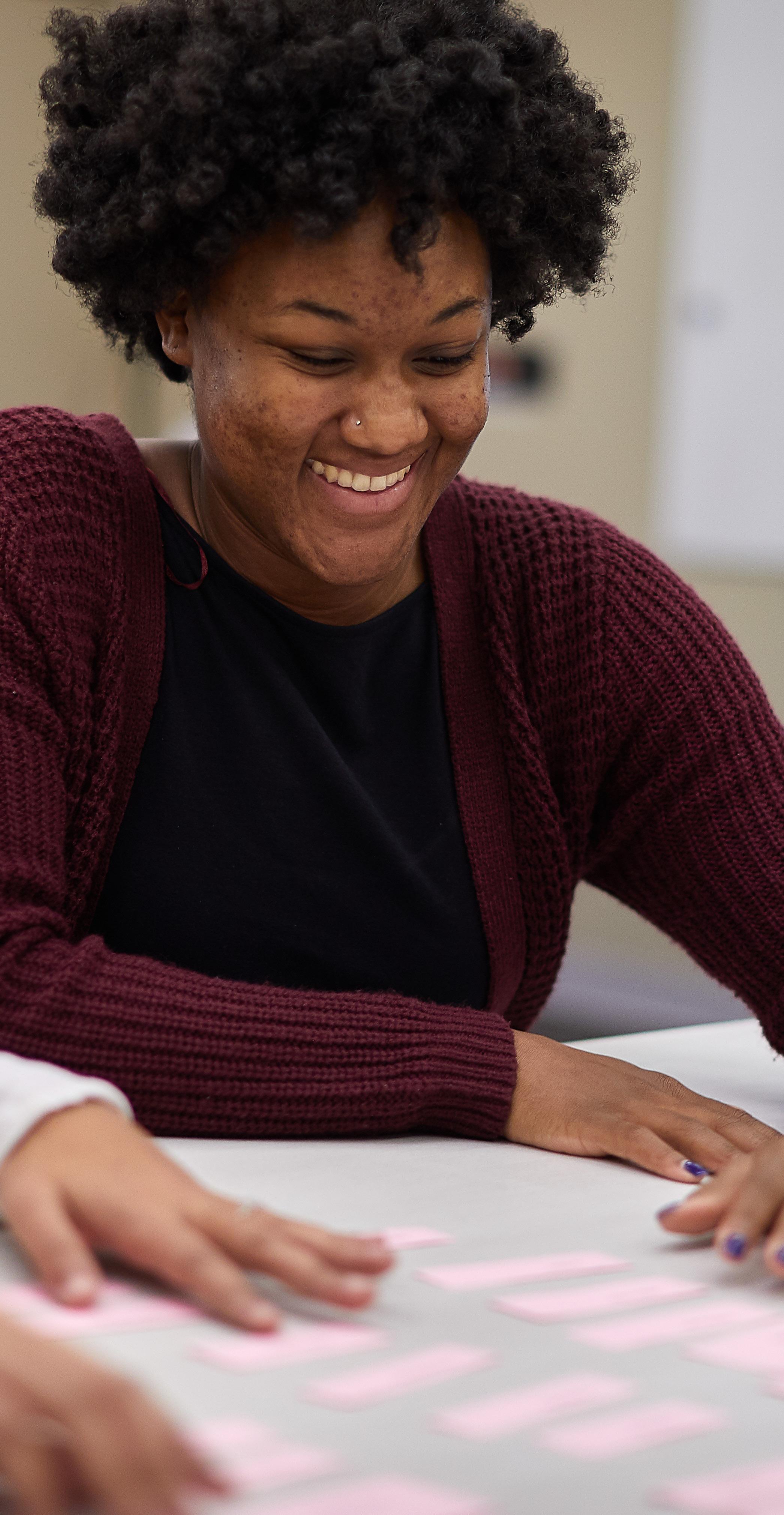
ASG will hold its next meeting at 6 p.m. on March 28 in the Joslin Senate Chamber in Armstrong Student Center.
turmankd@miamioh.edu

SAVE MONEY. GRADUATE FASTER. Take summer classes at Columbus State. cscc.edu/summerguest Most awarded college newspaper in Ohio at the 2020 Regional Mark of Excellence Awards by the Society of Professional Journalists. COSETTE GUNTER-STRATTON EDITOR-IN-CHIEF Advertising information: ankenedw@miamioh.edu Send us a letter? eic.miamistudent@gmail.com The Miami Student is published biweekly during the school year by the students of Miami University in Oxford, Ohio. The content of The Miami Student is the sole responsibility of The Miami Student staff. Opinions expressed in The Miami Student are not necessarily those of Miami University, its students or staff. CORRECTIONS POLICY The Miami Student is committed to providing the Miami University community with the most accurate information possible. Corrections may be submitted up to seven calendar days after publication. Abby Bammerlin Managing Editor Macey Chamberlin Soren Melbye Design Editors Lexi Whitehead Senior Campus & Community Editor Sean Scott Alice Momany Reagan Rude Campus & Community Editors Jack Schmelzinger Sports Editor Ames Radwan Opinion Editor Devin Ankeney Asst. Opinion Editor Luke Macy Maggie Peña Megan McConnell Chloe McKinney Asst. Campus & Community Editors Erin McGovern Hannah Potts Asst. Design Editors Emily Hogan Caitlin Dominski Danielle Silver Designers Teddy Johnson Patrick Sullivan Humor Editors Maggie Peña Sean Scott Entertainment Editors Reece Hollowell Asst. Entertainment Editor Claudia Erne Social Media Editor Ames Radwan Food Editor Jake Ruffer Photo Editor Jessica Monahan Asst. Photo Editor Sarah Grace Hays Audio Editor Hannah Horsington Video Editor Skyler Perry Magazine Editor Devin Ankeney Business Manager Fred Reeder Jr. Faculty Adviser Sacha Bellman Business Adviser Aim Media Indiana Printer Things
E. E. McClellen Lecture 5 p.m.6 p.m. Upham Hall 001 Gregory Ablavsky from Stanford University discusses native sovereignty and federal law. 3/27 Mon Coffee & Conversations 6 p.m.7:30 p.m. McGuffey Hall 128 Give survivors an opportunity to learn and think about healthy relationships after an assault. 3/28 Tue A Night with Marcus Samuelsson 6 p.m.7 p.m. Harry T. Wilks Theater Samuelsson, an acclaimed chef, will participate in a presentation and Q&A sesison. 3/29 Wed Words Are Also Migrants 3 p.m.4 p.m. Shideler Hall 032 A creative writing workshop led by Manuel Iris. 3/30 Thu MAP Movie 9 p.m.11 p.m. Central Quad Join MAP to watch “Don’t Worry Darling.” 3/31 Fri Music at the Museum 1 p.m.2 p.m. Richard and Carole Cocks Art Museum Listen to student musicians perform in an informal afternoon of music. 4/1 Sat FRIDAY, MARCH 17, 2023
to do
2
Sean Scott elected
Editor-in-Chief of The Miami Student
ABBY BAMMERLIN MANAGING EDITOR
Sean Scott, junior journalism and urban and regional planning double major, has been elected as the next Editor-in-Chief of The Miami Student.
Scott has been a constant presence at The Student since he first started writing his first year at Miami University. While at the paper, he has worked as a Campus & Community Editor as well as Entertainment Editor. He’s garnered more than 130 bylines – the most of any active member on staff.
Among his goals for his tenure as Editor-in-Chief, Scott hopes to continue to foster an inclusive community at The Student.
“I want [The Student] to be a very fun and open environment where everyone feels like they can come into the newsroom at any point and see other people and feel comfortable
talking across the staff,” Scott said.
Another one of his goals is expanding multimedia sections like video, photography and audio in the paper. By focusing on multimedia elements, Scott believes he’ll be able to connect to a wider audience and tell stories in a new way.
For Scott, The Student is the voice for Oxford as one of the only publications in the area.
“[The Student] is pretty essential to the community in the sense that we report on a lot of issues that I don’t think the broader student body or even faculty sometimes are aware of or that they aren’t fully informed of,” Scott said.
Fred Reeder Jr., the faculty adviser for The Student, has had Scott in class before. He hopes Scott will continue the work his predecessors have done.
“I mean, there’s no denying he’s an extraordinarily talented journalist who is highly ethical … ” Reeder
said. “And just his modeling of that will carry him a long way as leader.”
Current Editor-in-Chief Cosette Gunter-Stratton has known Scott for three years and was ecstatic to learn he had been elected.
“I know he has what it takes to lead this organization with intelligence, care and professionalism,” Gunter-Stratton said.
For Scott, The Student has been a huge part of his life at Miami. He credits the organization with teaching him everything he knows as well as being where he’s met most of his friends on campus. “I think that looking back on my college experience 15 or 20 years from now,” Scott said, “it’s going to be looking back at my experience at [The Student].”
@abbybammerlin bammerj@miamioh.edu
ineligible
ABBY BAMMERLIN MANAGING EDITOR LUKE MACY ASST. CAMPUS & COMMUNITY EDITOR
The State Employment Relations Board (SERB) has reached its decision on who can be included in Miami University’s proposed faculty union. As it stands, tenure and tenure-track faculty and non-tenuretrack teaching, clinical professors and lecturers (TCPL) faculty are eligible to participate in the union.
The decision means that librarians and visiting assistant professors (VAPs) will not be included in the proposed collective bargaining unit brought forth by the Faculty Alliance of Miami (FAM), as the group had previously advocated for.
The date of the election has not yet been set by SERB. However, according to Miami’s Informed Choice website, the university anticipates more information on the election process within a few weeks.
“In the coming weeks, we expect SERB to issue a Notice for Representation Election,” the website reads. “This notice will provide a description of the proposed bargaining unit, the election period, the employment date used to determine voter eligibility, a sample ballot, and the tallying date for ballots.”
Miami Provost Liz Mullenix informed faculty members of the decision made by SERB in an email sent on March 9.
“Though the Miami administration favors an independent faculty
and does not support unionization, it recognizes that faculty have a right to organize and that this decision rests solely in the hands of those within the proposed [collective bargaining unit],” Mullenix wrote.
Mullenix wrote that Miami expects the election to take place via mail-in ballot and eligible voters will have 14 days to mail their ballot once the polling period opens.
On March 10, FAM shared a post on its website disagreeing with the decision.
“It’s unfair and disappointing that our colleagues who contribute so much to the academic mission of the university are being excluded,” the post read. “Rather than trying to divide us, the administration could have chosen to listen to faculty’s desire to unionize together.”
The road to unionization so far
In February 2022, Miami University’s American Association of University Professors (AAUP) announced it would seek unionization for full-time tenured and non-tenured track (NTT) faculty members and librarians in its bargaining unit.

Daniel Hall, a professor of justice and community studies and political science, spoke at a Board of Trustees meeting on March 3 to speak for FAM. He, along with many FAM supporters, went to the meeting advocating for the university to allow faculty members to vote on the proposed unit as it was.
“The great majority of faculty are motivated by their love of teaching, mentoring, and research. Unionization will not impact that reality,” Hall
said. “The faculty have spoken. We want to unionize and we want tenure-track faculty, TCPLs, and librarians to be in a single unit.”
FAM had been acquiring authorization cards from faculty who supported the union before the university filed an objection with SERB to oppose the inclusion of non-tenured track faculty and librarians in the proposed bargaining unit. SERB scheduled the hearings for December 2022.
Part of the hearing focused on whether or not VAPs could be considered seasonal employees. Seasonal employees are defined as a group where only 60% returns each year.
Miami and FAM didn’t agree on how to classify if a VAP returned. Miami only considered VAPs returning if they stayed in the VAP position, placing them below the 60% figure. FAM, on the other hand, calculated that more than 60% of VAPs are retained at Miami each year, if VAPs who change positions are included in the statistic.
FAM and the university have been waiting for SERB’s decision since the conclusion of the hearings in late December. Faculty members were not allowed to vote on the proposed unit until SERB reached its decision.
@abby_bammerlin
bammeraj@miamioh.edu
@lukejmacy macylj@miamioh.edu
MEGAN MCCONNELL ASST. CAMPUS & COMMUNITY EDITOR
Prospective students, parents and siblings skip over puddles and rushing water through the streets. A tour guide leads the herd, cloaked in raincoats and armed with umbrellas, into Armstrong Student Center. They sigh with relief and shake off their coats, chatting while they climb upstairs to the next event. A campus living and housing presentation is about to begin. The room is already full, so the last minute stragglers line the back and side walls. They’re covered in rain, their jackets and umbrellas soaked with the cold.
Stella Powers, a high school senior from Wooster, Ohio, discusses the day’s events with her father away from the crowded presentation. Friday, March 13 was her first time on Miami University’s campus, and despite the heavy downpour that left her brown corduroy pants soaked down the front, she said her experience was great.
“I’ve learned a lot,” Powers said. “Believe me, I like it a lot.”
Over the last 12 years, Miami’s Office of Admission has hosted eight to 10 Make It Miami events every spring. It serves as day-long open houses where prospective students and their families can meet faculty and current students. The Office of Admission hosts various informational sessions about financial aid, housing and honors programs. Prospective students can also tour academic and residential facilities, rain or shine.
Ethan Wigal, a junior political science and global intercultural studies co-major, still remembers attending Make It Miami as a high school senior and accepting his admission. He has been a campus tour guide since his first year at Miami and was promoted to manager at the beginning of last semester.
Although tours are available year-round, student workers can sign up for special shifts at Make It Miami. Because of his experience at Make It Miami, Wigal said he loves getting to work with prospective students. Sometimes, students will even come up to Wigal around campus and tell him he’s the reason they
committed.
“Getting to be a part of that process for other students and helping them fall in love with Miami is such a rewarding experience,” Wigal said.
Bethany Perkins, assistant vice president and director of admission, wrote in an email to The Miami Student that these events often play a big factor in helping students make their final college decision.
“The students have many opportunities throughout the day to interact with our faculty and current students within their major to gain insight on the student experience,” Perkins wrote. “This event gives students the opportunity to really picture themselves on campus and as part of our community.”
At the event, students are even able to accept their offer of admission. For each student that commits, the staff rings a bell. Although it differs from year to year, Perkins wrote that six to 10 students typically accept their offer before leaving campus and many others accept theirs shortly after. Last year, more than 60% of prospective students who attended a Make It Miami event accepted Miami’s offer, according to Perkins.
Powers has yet to commit to Miami. She applied to about 20 different schools, and so far she’s only visited two: Miami and Ohio State University. The national deadline to accept is May 1.
Although Powers hasn’t made her decision yet, the prospective journalism and performing arts major said Make It Miami allowed her to explore and learn about both of her academic interests.
“I’m really happy with all the opportunities that there [are] to offer,” Powers said. “My path won’t be exclusively journalism. As much as I love it, I also love the performing arts, so there’s opportunities for that, which I think is great.”
mcconnmn@miamioh.edu
March Board of Trustees meeting includes talks about unionization, mental health and tenure
LUKE MACY ASST. CAMPUS & COMMUNITY EDITOR
On March 3, after two days of committee meetings, Miami University’s Board of Trustees gathered in Marcum Conference Center to meet with chief administrators and receive updates on the university’s big news.
The meeting was filled with various audience members, some of whom had to stand against the wall just to fit. However, not all of the audience was there just to listen to the board — some were there in support of the Faculty Alliance of Miami (FAM).
Faculty show up in support of union
FAM members spoke at the start of the meeting during a public comment session, advocating for Miami faculty to be allowed to vote on a proposed collective bargaining unit.
At the time, FAM was waiting on an announcement from the State Employment Relations Board (SERB) to determine who could be included in the unit. On March 9, the university shared SERB’s announcement that only tenure and tenure-track faculty and non-tenure track teaching, clinical professors and lecturers faculty would be included (librarians and visiting assistant professors excluded).
Deborah Lyons, a professor of French, Italian and Classical Studies, said to the board that the union would help improve professors’ ability to teach.
“We are creating education, a public good. I know that everyone in this room shares the goal of providing an excellent learning environment for our students,” Lyons said. “There is
no reason for this to be an adversarial relationship.”
Daniel Hall, a professor of justice and community studies and political science, spoke about his experience with unions at previous universities, citing Miami’s problems for a push to unionize.
“Presently, faculty morale is the lowest I have ever witnessed, at any university, in my 33 years in higher education,” Hall said. “A lack of transparency, unfair processes and draconian rules and disciplinary procedures are contributors to this problem.”
After the public session, Miami’s Provost Liz Mullenix presented the board with 38 people to be granted tenure by the board.
Mullenix said 26 were given tenure with promotion to associate professor and 10 were given tenure with promotion to full professor. One librarian was given tenure and an associate professor also received tenure.
University Senate puts focus on mental health
Thomas Poetter, chair of University Senate, presented news about Miami’s senate during the 2023 spring semester. Poetter began by highlighting the presentations at the senate’s most recent retreat, which focused primarily on mental health and well-being.
“These presentations generated substantive conversations and understanding regarding the work ahead and the issues facing the entire campus, students, faculty and staff regarding mental health,” Poetter said.
Mental health was brought up at other times during the meeting.
The board announced that the Ohio
Department of Mental Health and Addiction Services awarded Miami
with $1.2 million for Project AWARE (Advancing Wellness and Resiliency in Education).
The funds are for increasing awareness of mental health issues and providing services to combat them.
“We are at a crucial moment with mental health on our campus,” said John Fazio, one of the board’s student members. “Our students now, and the ones who will come to us in the future, need our help.”
Poetter said that although the senate hadn’t passed any 2023 resolutions at the time of the trustees meeting, the senate would be voting on pending resolutions at the March 6 meeting. The senate was focusing time on hearing presentations from university leaders.
One of these presentations was the budget symposium on Feb. 6, where Mullenix and David Creamer, senior vice president for finance and business services and university treasurer, went over Miami’s budget deficit.
“We are all concerned with the budget from all of our own unique perspectives, and this annual event and presentation, in my opinion, helps to frame and interpret the challenges we face as a community altogether,” Poetter said. “The extension of the information to at least the college level by leadership is a strong example of multiple layers of our system working together as per our mission to share governance.”
Student Body President highlights progress of the past year
Amitoj Kaur, outgoing student body president, also spoke at the trustees meeting, reflecting on her year as president.
Kaur highlighted her recent efforts to provide free menstrual products on Miami’s Oxford campus.
“This past month we announced to the entire Miami community that this semester all women’s and gender neutral restrooms will have free menstrual products,” Kaur said. “You’ll be happy to hear we’re working with the regional student government right now to get the same program implemented on your campuses as well.”
Kaur also shared her personal struggles with mental health to the board as indicative of larger problems throughout campus.
“When we look at the job of a student body president, oftentimes we hear them when they achieve high successes, when they come to public speaking engagements, when they’re on social media,” Kaur said. “But rarely do we reach out to them when things aren’t going well, when things are quiet, when perhaps they may be struggling.”
President Crawford shares successes in research and sustainability
Miami President Greg Crawford then spoke to the board, highlighting many professors for their successful research and achievements. Crawford also shared that the university’s sustainability efforts led to an invitation to the White House with nine other schools.
“Our work has been recognized because of all the geothermal [energy], and that resulted in more [than] a 50% cut in our equipment over the past decade,” Crawford said. “We’re very excited about that.”
Crawford also highlighted the Amtrak station that will begin construction in Oxford in 2026 and discussed the recently opened Fisher
Innovation College@Elm Center.
“You can go from your idea stage all the way through manufacturing, which I think is really unique for us situated in such a small town,” Crawford said. “But another thing that’s really attractive about [the center] is that it’s about art as well.”
Senior student member gives farewell
Despite the highlights and recognition, the meeting did not go without a few tears.
The meeting was the last for Dawson Cosgrove, the senior student member, with his two-year term coming to an end. Cosgrove fought tears as he delivered a closing speech to the board.
“Today is kind of a bittersweet day for me. It marks the beginning of the end of this particular chapter in my life,” Cosgrove said. “It is the people who make Miami University special and … it has been the honor of a lifetime to be able to be a representative of the student body and a representative of Miami University.”
Fazio will take over Cosgrove’s position as senior student member. In a speech to Cosgrove, Fazio promised to carry on his legacy.
“As we move forward, I will facilitate open discussion and collaboration across Miami to guide deliberate, impactful and lasting change,” Fazio said. “So many of these goals and skills are things that Dawson has shown me.”
The board concluded the meeting by presenting Cosgrove with parting gifts, including a special stole to represent Cosgrove’s work for the Miami community. @lukejmacy
macylj@miamioh.edu
FRIDAY, MARCH 17, 2023 3
FOR THE PAST 12 YEARS, MIAMI HAS HOSTED EIGHT TO 10 MAKE IT MIAMI EVENTS EVERY SPRNG. PHOTO BY JAKE RUFFER The making of Make It Miami
TCPL faculty will be included in the vote for unionization, librarians and VAPs
Campus and Community
‘Living laboratories for climate change’: Miami participates in inaugural White House campus sustainability forum

SHR-HUA MOORE SENIOR STAFF WRITER
When Miami University started making its campus more energy efficient in 2012, it was to save money in the wake of the 2008 financial crisis.
Ten years later, these measures have evolved into an organized strategy for decarbonization that has established Miami as a leader in campus sustainability.
In light of Miami’s sustainability achievements, two staff members and two students were invited to represent Miami in the White House forum on campus and community-scale climate change solutions on March 8.
The conference took place over two days in Washington, D.C. It included speakers from organizations like the National Science Foundation (NSF), the Department of Energy and the White House Office of Science and Technology Policy.
Sara Linder is the director of federal relations at Miami’s Office of Advancing Strategies, Partnerships, Institutional Relations and Economy (ASPIRE), an institution that connects public officials with the university. Linder was one of the staff members to attend the conference, and she explained that it was formed through a collaboration between the federal government and several universities.
“We formed an informal working group of half a dozen universities engaged in conversations with the White House,” Linder said. “We put together a proposal to the NSF, and
we got approval for the conference to happen.”
Linder said the purpose of the conference was to give colleges across the country a chance to connect and share sustainability techniques with each other. The conference invited one college from each U.S. state and territory, with Miami chosen to represent Ohio.
“This conference is bringing universities from across the country to see what they’re doing on their campuses, and learning about the role the government can play in supporting universities,” Linder said. “We are learning from one another through this workshop to create a network of campuses that can rely on each other for future climate solutions.”
One of the reasons Miami was chosen for the conference was because of its track record in improving energy efficiency and reducing emissions.
Olivia Herron, director of sustainability at Miami, said Miami’s sustainability development was initially to save money but ended up turning the university into an unwitting sustainability pioneer.
“Back in 2012 we were coming out of the recession, and higher education wasn’t in a good place, so the university was originally saying, ‘OK, if we’re using less electricity, we’re saving money,’” Herron said. “This was over 10 years ago — at that time it was about finances, but now Miami is really good at being energy efficient and one of the leaders in the country
[in sustainability].” Herron said the combination of focusing on energy efficiency and moving to renewable energy sources such as geothermal over the past decade has helped significantly reduce greenhouse gas emissions from campus facilities, setting Miami apart from other colleges.
“If we put all sources of energy together, we have reduced the greenhouse gas emissions from our energy system by 55% since 2008,” Herron said. “A lot of universities have interim goals of 30% [greenhouse gas reduction] by 2030, so we have definitely surpassed them in that area.”
Teryn Scott, a junior majoring in diplomacy and global politics and geography & sustainable development, was one of the two Miami students that attended the conference. She said Miami’s position as a college campus also gave it unique opportunities to test out sustainability solutions.
“Universities are like living laboratories — colleges provide a test bed and proof points for climate action,” Scott said. “Many campuses are like small cities, and have similar challenges for mitigation, adaptation and resilience. At Miami, we’re testing out new and innovative technologies to see where they work, how they work and what benefits they provide.”
Scott also said it was inspiring to listen to the speakers at the conference and participate in breakout discussions.
“It was great to be in the room where all these great minds come
together and talk about problems that affect not only our generation but generations to come,” Scott said.
“It’s good as a student to discuss areas where we can improve communities and improve global society as a whole, and I felt empowered as a student participating in this conference.”
Randi Thomas, vice president of ASPIRE and a panelist at the conference, said the engagement of Scott and Evelyn Morrison, the other student that went, with sustainability leaders was his favorite part of the conference.
“I was so proud of our students and their participation — they rocked it,” Thomas said. “[Sustainability] is
such an important issue and to have our students involved and engaged at that level is very fulfilling.”
Thomas said the conference was a great experience that gave him hope for college sustainability in the future.
“We learned a lot, and we’re very proud of the work that Miami is doing under [President Crawford’s] leadership,” Thomas said. “To have all those great minds in the room — not just on campus, not just in the U.S., but globally — gives me great hope and solace in respect to climate change.”
moorese6@miamioh.edu
Talawanda’s budget: what happened and how did the district get here?
SHR-HUA MOORE SENIOR STAFF WRITER
Last November, a proposed levy failed to pass, leading Talawanda School District (TSD) to announce a series of budget cuts that are meant to make up a $5.4 million deficit over the next four years.
There have been discussions about cutting extracurriculars like art and music, making sports pay-toplay, grade-banding and only providing busing to elementary and middle school students who live more than two miles away from their assigned school.
In light of these developments, the question remains: how did Talawanda end up in this situation?
The state funding formula
While the current problems TSD is facing have risen to public attention this year, it has been dealing with another problem for the past two decades — the state funding formula.
The funding formula that the state uses was originally deemed unconstitutional by the Ohio State Supreme Court in 1997 for relying too much on property taxes. Two and a half decades later, property taxes are still a large part of school funding.
Holli Hansel, director of communications for TSD, said the district is on a state guarantee that provides $2,500 per student but relies on local taxes to raise the rest of the money. Statewide, the average state funding per student is more than $11,000.
CHLOE MCKINNEY
ASSISTANT CAMPUS & COMMUNITY EDITOR

It’s the end of your sophomore year at Miami University. Finally, you can leave those cramped residence halls and start looking at off-campus housing for junior year.
Maybe you’ll rent a house; take part in Miami traditions and nickname it something like The Byrdcage house on West Chestnut Street. Or maybe you’ll rent an apartment
“Local taxpayers are providing the lion’s share of expenses … Funding is coming in, but this is a very complicated formula,” Hansel said.
Miami University poses a unique problem with this reliance on local taxpayers.
Because the university is a state institution that doesn’t have to pay taxes, any revenue for TSD that could be generated from property owned by Miami is nonexistent.
In an email to The Miami Student, Kathleen Knight-Abowitz, a member of Talawanda’s Board of Education (BOE), wrote that this inflates Talawanda’s wealth while decreasing tax revenue.
“Because of lots of factors, our district’s citizens shoulder a lot of the tax revenue compared to citizens of other school districts,” Knight-Abowitz wrote. “We are considered a wealthy district by the state but also cannot collect tax revenue on any [Miami] property, so that’s a lot of property that we are unable to levy taxes on.”
According to Hansel, another factor that has affected TSD under the state funding formula is it’s district land mass rank. TSD is ranked 61st out of 615 Ohio districts in terms of land mass, 136.78 square miles, but a majority of the included land total is farmland within the district. Hansel explained that this means the district is expected to get more funding from taxes under the formula than it does in reality.
“In Ohio, valuable land is used as
an indicator of wealth, however the land itself doesn’t necessarily generate income to demonstrate that and the owners of that land may not be wealthy,” Hansel wrote in an email to The Miami Student. “We have a little town, with a major state university, surrounded by a [rural] area.”
Reductions in state support
Over the past 10 years, public schools have faced decreased state funding as the legislature made changes to allocate more funding to private and charter schools.
Rebecca Howard, vice president of Talawanda’s BOE, said state funding for TSD has either stagnated or decreased since the early 2010s.
“Up until 2012, there was a significant amount of funding support from the state … we were building a surplus,” Howard said. “Some decisions by Talawanda, like removing pay-to-play, were made at a time when funding was fairly robust. As time has gone on, funding in all areas from the state has either pulled back or remained flat.”
The Fair School Funding plan in 2021 sought to remedy the problems with funding public education by giving additional funding to schools with high poverty rates and numbers of minority students, but TSD does not meet either qualifying metric.
Carla Blackmar-Rice, a mother of two TSD students, has looked deeply into TSD’s funding issues and said the plan would be too slow to work, even if Talawanda did qualify.
“Even if we were to benefit, the problem is that Ohio is phasing in the plan over six years and doing nothing to speed up the process,” Blackmar-Rice said.
Blackmar-Rice believes the decisions by the Ohio legislature reflect a larger trend of defunding education nationwide.
“Ohio is part of a nationwide movement to erode education by providing vouchers and supporting private schools and homeschools, which is linked to corruption from people who stand to make a profit from privatization of schools,” Blackmar-Rice said. “Since public education is the cornerstone of our democracy, this cycle of divestment makes you wonder how [the Ohio legislature] feels about democracy if they’re allocating funds to pay for things like private and religious education.”
The Levy House bill 920, which passed in 1976, dictates that any funding from a levy must remain at a fixed rate regardless of inflation. This legislation, meant to help taxpayers, means the money collected from TSD’s 2004 levy remained fixed despite rising inflation rates in the following years.
“Inflation is going up, but the money we are collecting right now is staying the same,” Hansel said. “There was no way to increase revenue other than to put an operating levy on the ballot and let taxpayers vote on that.”
Hansel added that proposing a
levy during a time of inflation made it a harder sell than it would otherwise be.
“Individual households and families are also experiencing difficulties with food and gas prices,” Hansel said. “It makes it a really difficult decision for people — especially people who are just ‘making it’ — to vote to increase their taxes because costs are already going up [for them].”
Blackmar-Rice said that while it’s always hard to communicate the benefits of tax policy, TSD could have more effectively outlined the issues at hand.
“The history of our area would suggest that in 2004, it [had taken TSD] 10-20 years to pass the last levy, so I think they could have had a more organized communications campaign,” Blackmar-Rice said. “In order to pass a levy you need to run a very sophisticated campaign, and that takes people and financing.”
Howard said that during this time of uncertainty it’s best to take action through actively educating oneself about Talawanda’s budget issues.
“I appreciate the people who are trying to get actual facts and not speculating, and I encourage people who have questions to contact board members and find out who can answer these questions,” Howard said. “Everyone is making decisions with the best information we have.”
moorese6@miamioh.edu
in Uptown; pick a place somewhere near Bagel & Deli for that hangover cure after a night out.
There is just one problem. To get a nice off-campus place in Oxford, many students feel they have to sign a lease months, even years, in advance.
Fortunately for Alaina Kapturasky, a sophomore political science and journalism major, she knew about Oxford’s competitive housing market. Kapturasky and her sorority sisters from Zeta Tau Alpha started looking for off-campus housing in the
spring semester of her first year. After two months of searching, the group decided on a duplex close to Uptown for junior year.
Kapturasky said even though she hasn’t moved out of the residence hall yet, they are already looking for a place for her senior year.
“Genuinely, we feel extremely behind because when you are looking at these realtor places online, one day something is available, and then the next day it’s signed … it’s gone,” Kapturasky said.
Searching for housing as a college student can be nerve-racking for other reasons as well. According to a 2017 survey on the Miami off-campus outreach page, many off-campus options charge a semesterly rate instead of monthly. The survey says prices for houses range from $1,880 to $4,880 per semester (per person) and apartments range from $1,200 to $5,600 per semester (per person). However, many students struggle to afford bulk payments.
Kapturasky described the process of searching for off-campus housing as “very stressful, very difficult and expensive.” She said pricing by semester makes housing “unattainable” for many students.
Not only does the market in Oxford make finding affordable housing difficult, but the tradition of fraternities and sororities pass-
ing down houses only adds to the issue, Kapturasky said. Many fraternities and sororities like hers have houses that members cycle through each year.

“It’s like half of your picks are taken because there are just so many pass-downs,” Kapturasky said.
Kayla Wood also got an early start when looking for housing. Wood, a junior middle childhood education major, and her three roommates started looking at houses in the fall semester of her first year. Already, she said, the group felt like they were behind.
It didn’t take them long to decide, Wood said. The same day they toured the property in 2020, the group signed a lease for the 20222023 school year. After one month of searching, Wood said they felt pressured to commit in a hurry because they started looking so late and worried it would lose availability.
“If we hadn’t waited so long, we would have waited to sign,” Wood said.
Neal Schuett is a visiting assistant professor in the political science department at Miami and a criminal defense attorney at Rittegers & Rittgers Nakajima law firm. Despite any worry students may feel while looking for housing, Schuett said they should always consider multiple options.
Wood also remembers being surprised at how quickly her landlord ex-
pected to have a lease signed for the same house her senior year.
“They wanted us to renew before we had even lived in the house our first year,” Wood said. “They already wanted us to sign for our second year.”
Schuett’s advice to students on how to handle the pressure of signing leases quickly is to not be afraid to negotiate and educate yourself on your rights.
“There is probably no panacea here to fix everything,” Schuett said. “But being informed, being willing to negotiate, being willing to stand up for yourself and ask questions is probably the first step … Then, I think you will start to see a little bit of a change because [landlords] are going to have to meet the demand and knowledge base of the students.”
Kapturasky suggested this education should also come from the university.
“I think educating students [on] how to go through the off-campus housing process … it’d be beneficial to people,” Kapturasky said. “Some people don’t even know that they should be signing right now, and then they’re left in the dust.” mckinn15@miamioh.edu
FRIDAY, MARCH 17, 2023
4
RANDI THOMAS, VICE PRESIDENT OF ASPIRE AT MIAMI UNIVERSITY, PARTICIPATED IN A PANEL AT A WHITE HOUSE FORUM ON SUSTAINABILITY. PROVIDED BY TERYN SCOTT
‘Very stressful, very difficult and expensive”:
TO GET A NICE OFF-CAMPUS PLACE IN OXFORD, MANY STUDDENTS FEEL THEY HAVE TO SIGN A LEASE MONTHS, EVEN YEARS, IN ADVANCE. PHOTO BY COSETTE GUNTER-STRATTON
Navigating the Oxford housing market as a student
Rebecca Nagle speaks on tribal sovereignty, importance of Native representation
REAGAN RUDE CAMPUS & COMMUNITY EDITOR
Attendees of Rebecca Nagle’s lecture on March 8 left with more than just knowledge about tribal sovereignty — they learned why they should care.
The lecture, hosted by Miami University’s Western Center for Social Impact and Innovation in collaboration with the Myaamia Center invited Nagle to speak on tribal sovereignty in the modern age.

Nagle, an award-winning podcaster and citizen of the Cherokee Nation, spoke to a full audience in Shideler Hall about what it means to be a federally recognized tribe, how U.S. policy impacts the rights of tribes and their citizens and the underrepresentation of Native Americans in the media.
Kara Strass, director of the Miami Tribe Relations Office, and Jackie Daugherty, director of the Western Center for Social Impact and Innovation, each gave introductions discussing the work of the Myaamia Center and Nagle’s recent advocacy work to end violence against Native women.
“Rebecca’s work aligns well with our university’s current focus theme of tribal sovereignty and the Western Center’s current work on reparative justice efforts,” Daugherty said.
Nagle began her lecture by discussing the lack of Native representation in the media. She said Native people make up 2% of the U.S. population, yet less than 0.1% of people in movies, television and music are Native.
“If you think about that, every time there’s a Billboard Top 100, two of those should be by a Native person, right? When you’re scrolling through Netflix, one out of every 50 shows should be centered on a Native story,” Nagle said. “Instead of even getting just that 2%, which I think we’re owed more than, it’s always a fraction of a fraction.”
Nagle also said that when people think about Native Americans, they tend to think of them as a thing of the past. Of the top 100 Google image
search results for Native American and American Indian, 95% are from the late 19th century, Nagle said.
Nagle said this lack of representation creates harmful stereotypes. She cited one study that conducted interviews across the country and found that many people didn’t even know Natives are still alive.
“There was recognition of ‘Yeah, this happened in the past, that was bad,’” Nagle said. “But Native rights and issues aren’t a contemporary issue in our country today. And how can you blame them because the news media and the press are not telling them about the issues Native people are facing?”
Kristen Impicciche, a senior communication design major, works at the Western Center and helped put on the event. She said she appreciated Nagle encouraging the audience to follow Native American media organizations, including Indian Country Today and Native News Online.
“I thought that was really interesting because you don’t really see [Native news] day-to-day,” Impicciche said. “We should let those voices be heard more and lift them up.”
Nagle pointed to the widely uncovered effects of COVID-19 on Native people, who are often grouped into an ‘Other’ category for demographic case data. In an analysis by the Washington Post from August 2021, one in 1,300 white people had died of COVID-19, while one in 240 Natives died.
Much of this lack of attention to Native issues, Nagle said, is due to a widespread lack of information about how Native tribes continue to live and function in the U.S. today.
“How many people [here] know legally what a federally recognized tribe is?” Nagle asked the crowd. “How many people feel like they can name one Supreme Court case that impacted Native people in the U.S.?”
Only a few people raised their hands.
“You all didn’t just fall into not knowing what tribal sovereignty is — it’s systemic,” Nagle said. “What is happening in our culture now is the type of racism that functions through invisibility. Native people are com-
pletely erased from pop culture, from media, from education, and that erasure creates a deep stereotype in the minds of non-Native people.”
Nagle then explained that tribal sovereignty is basic civics; it’s a layer of government, just like local, state and federal.
“In Oklahoma, tribes are paving roads, providing health care; they have their own police force,” Nagle said. “We’re doing a lot of the work of local government.”
Indigenous rights also work differently, as they’re more centered around collective rights rather than individual ones. The right to sovereignty, Nagle said, is something that is inherent rather than something that is given to Native nations by the U.S.
“Our Native nations predate the creation of the United States,” Nagle said. “Our right to our lands, to our culture, our own self-governance and self-determination, is something that has existed since the beginning of time.” Although colonization has impacted how much of that sovereignty can still be practiced today, Native tribes have worked hard to be recognized in U.S. law through Indigenous activism. In the U.S. today, there are more than 570 federally recognized tribes, each with its own system of government.
Treaties, Nagle said, are another aspect of Native history riddled with misconceptions.
“People have this idea that treaties are sort of these outdated and antiquated promises, and there’s this given that treaties are broken or aren’t followed,” Nagle said. “If you look at
the Constitution, it says that treaties are the supreme law of the land.”
Known as the Supremacy Clause, a portion of the Constitution states that if the U.S. signs a treaty, it can’t be repealed by the courts, state governments or even legislative bodies. Nagle said it’s frustrating how often Native rights outlined in treaties are infringed upon.
“I like to joke sometimes that the U.S. federal government created this entire legal framework with which to legally seize our land according to its own laws and then doesn’t even follow those laws,” Nagle said.
Some of Nagle’s own family members signed a treaty that gave the Cherokee Nation the right to a non-voting delegate in Congress in the 1780s and was affirmed in 1835. That delegate has never been seated.
Although Nagle’s talk was, in her words, “a bit of a downer,” she ended on a positive note by highlighting some of the positive changes happening currently, catalyzed by Standing Rock.
The Standing Rock Indian Reser-
A game of Kings: Being sober at Miami University
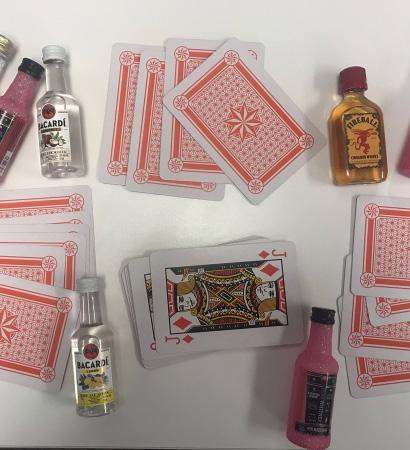 RYANN
RYANN
BEASCHLER STAFF WRITER
College students crowd in a residence hall room, perched on desk chairs or huddled on the floor. They hold cans, bottles or red Solo cups of alcohol.
One member of the group, Kenan Osmanagic, however, holds no beverage, instead, a bag of Reese’s cups. He recalls sitting among the group, surrounding a closed can with cards tucked under its tab, the rest of the deck sitting nearby.
They were playing Kings, a drinking game well-known to card decks at Miami University. A player pulls a card, each one prompts that player to drink, to tell someone else to drink, a certain group to drink, a new rule to be made or a game to be played.
Ace: waterfall. Two: you. Three: me. Four: floor. Five: guys. Six: chicks. And so on.
Once the rules are acted upon, the card-holder carefully places it under the can’s tab, threatening to pop the seal, seep air and prompt the card owner to drink it.
Another person then pulls a card. They yell in unison as the card is revealed. Five, “Guys!”
All of the guys in the group take a drink, except Osmanagic — he simply reaches into his bag to pull out a singular Reese’s peanut butter cup.
Osmanagic, a junior independent studies major, has never been drunk and does not plan on changing that. He replaces the drinking aspect of the game with candy.
Friends helped to uphold Osmanagic’s preference during their first-year, preparing his bag of candy whenever they hosted a residence hall drinking gathering.
“I’m just glad that there were people there that were respectful of that,” Osmanagic said. “I just walked in [and] they’re like, here’s his bag of Twix or whatever so that he can play the game with us.”
Jack, “Never have I ever!”
Osmanagic’s experience with the prospect of getting drunk for the first time is not rare among college students. According to data from The Office of Student Wellness’ required Alcohol Edu course modules, in 2021, 77% of incoming Miami first-years enter Miami as abstainers, nondrinkers or moderate drinkers.
Rebecca Young works to maintain that percentage as director of the Office of Student Wellness.
“When students [enter] college, it [becomes] harder to make those types of choices to either abstain or be a nondrinker or to drink in low-risk ways,” Young said. “So they would move to other categories like high [or] heavy episodic drinking or problematic drinking.”
Young said the highest reported reason that incoming students say they choose not to drink is due to a personal value.
Lucy Satheesan, a junior resident assistant (RA) and a computer science major, said she abstains from drinking because she won’t reach the legal drinking age in her college career.
“The major reason I don’t want to drink is because I’m underage, and I graduate at 20. So I will never get to legally drink on campus,” Satheesan said. “And getting caught while drinking illegally is potentially ruinous because I’m an international student.”
Osmanagic said he doesn’t see the purpose in alcohol.
“I never really was around the culture of, ‘You need to be drunk to have fun’ and all this stuff. So I was just like, ‘Who cares?’” Osmanagic said. “I didn’t need it. I didn’t feel like that was necessary to enjoy my life at all.”
Eight, “Mate!”
Osmanagic attended residence hall gatherings with drinking games like Kings for friendship. After his first year, though, the pressures of going out to bars became more prevalent. His friends were going out multiple times a weekend.
Although he wasn’t interested in drinking, he wanted to experience the large piece of Miami culture that his friends thought was fun.
“I think what really sparked me to really desire to go out with them is that I was their friend, and I wanted to experience that with them,” Osmanagic said. “So I was like, I want to just join you guys in that because I didn’t understand the culture … Maybe if I just went, it would be fun, and I would have a good time.”
His first drinking-adjacent excursion beyond the residence hall was a trip to a Halloween house party sophomore year. He hot glued pressed leaves together to make a cloak, which he paired with a green shirt, and green corduroy pants. Hair clips given to him by a “nearly naked” fairy, completed his mother nature costume. He socialized among red-Solocup-bearing, costumed, drunk college students.
“It was fun. And everyone was like, ‘Oh my gosh, are you a tree?’ And I’d
be like, ‘Sure,’ because I didn’t really care. I just liked the costume,” Osmanagic said. “I enjoyed going there because I didn’t get crazy. I didn’t drink. I didn’t do anything weird. I just sat around and talked to people.”
Satheseen felt similar pressures to go out. Friends convinced her to experience her first bar during RA training.
Three, “Me.”
Satheseen sat, enveloped by the loud chaos and packed crowds of Top Deck Bar. A spilled drink from the group behind her made her shoes stick to the floor.
“You can have successfully dragged me here, but you will not successfully force me to drink that,” she said, referring to the beer tower her friends had ordered, filled with frozen water bottles. “It feels unhygienic like, [did they wash] the bottles before they just immersed them into the beer?”
Satheseen took sticky, people-navigating steps to leave the company of her friends and their beer tower after what she estimates was 30 minutes.
Osmanagic isn’t one for the bar environment either.
“What really baffles me to this day, honestly, it’s the whole club thing. I just don’t really get it. I don’t understand,” Osmanagic said. “There’s this huge line of people and they wait and they pay way too much to get let into this dark room full of loud music that’s busting their eardrums off.”
Osmanagic rode his bike to his first ever visit to Brick Street Bar on a “random Saturday.”
He secured his bike on the rack he uses for the farmer’s market and joined the long Brick line.
In an effort to socialize, Osmanagic remembers talking to others in line, telling them it was his first time at Brick.
“They just told me the same stuff everyone always tells me: that the floors are so gross,” Osmanagic said.
Four, “Floor!”
He paid the $10 cover charge to take his first steps on Brick’s well-trodden, sticky floors for the first time. The bar seemed to grow in front of him.
“This place is massive, dude, you could house an airplane in here,” Osmanagic said.
As he passed some people he knew from his first year and followed his groups of friends, he joined the dance floor. He danced with his arms free and inhibitions inexistent within the constraints of the packed dance floor and the music he didn’t like.
“Dancing is fun. You can’t deny
that. I love to dance,” Osmanagic said.
For students like Satheseen and Osmanagic, Young says the Office of Student Wellness seeks to show them that abstinence and bars can go together.
“The other thing that we want to make sure that students know is that they could go to the bars uptown if they’d like to, and they don’t have to engage in drinking there,” Young said. “They can just enjoy the music, enjoy the camaraderie, dance, and they can do that by having some good skills on how to feel confident about not choosing to drink alcohol.”
Osmanagic still doesn’t entirely understand the bars or why people frequent them.
“Everyone is having such a good time, and I felt weird for being so judgmental of it. And I was like, ‘Why don’t I? Why can’t I just enjoy the music? Why can’t I just enjoy myself?’”
He hypothesizes that this is one of the reasons many people drink.
“If something can only be enjoyable when you’re drunk, is it really enjoyable in the first place?” Osmanagic said. King, “Ruler.”
Osmanagic left Brick unimpressed.
“I don’t really understand why I would do that. In place of, like, anything else, on my Saturday night,” Osmanagic said.
Satheseen sees the other side of the drinking culture as an RA, tasked with creating engaging events for her residents.
Last Green Beer Day (GBD), Satheseen held a game night in her hall. She watched residents leave and come back, all passing up her event. After two hours of waiting, a few residents joined her game night.
“It was potentially the worst decision I’ve made as an RA,” Satheseen said about the event.
The students, she said, had returned from the bars earlier than expected, reporting it wasn’t what it was cut out to be.
Young emphasized the Office of Student Wellness’s focus and success in the area of alternative late night events through Miami Activities and
vation, located on the border between North and South Dakota, received national attention in 2016 when its tribal members protested the Dakota Access Pipeline, which they considered a dangerous threat to the area’s water.
“Not only are Native people still here, but our tribes are still fighting for these basic things like land and sovereignty and safe drinking water and treaty rights,” Nagle said. “The attention that moment captured has built momentum for things that have come since then.”
Rylee Domonkos, a junior software engineering and business analytics major, said she attended the event for her Introduction to the Miami Tribe of Ohio [HST 259] class.
“Tribal sovereignty is a big thing that we’ve been discussing in the class,” Domonkos said. “So it’s interesting to hear a more modern take on it rather than just looking at the late 1800s, early 1900s which is where [the class] is at now.”
rudere@miamioh.edu
Programming (MAP).
“We’re seeing more students choose to either abstain, or to delay their drinking because of these activities. So we invested more money,” Young said. “So there’s about a $200,000 investment in making sure that students have really fun and engaging activities on campus, so that there is another option than maybe going Uptown to some of the bars.”
This GBD, MAP offered Spring-O, spring themed bingo.
Because of her experience last GBD, Satheseen said she avoids planning late night alternative events due to their low turnout.
“They’re hard to get people for,” Satheseen said. “People might either [be] going out and partying or might have other plans or might want to sleep early, or any number of reasons that make it hard for people to show up for that.”
Two, “You!”
Osmanagic still opts to not drink alcoholic beverages when he is called upon to drink in games. He sometimes opts for a red Solo cup filled with water rather than the bag of Reese’s cups or Twix he was accustomed to his first year and is no longer limited to the small residence hall floor plans in his upperclassman apartment days.
He attributes his success to a strong sense of self-identity.
“I think I just grew up with the really strong idea that I don’t need this stuff,” Osmanagic said. “I can make choices on my own, and I should, completely by my own volition, choose what I want to or not to do. And drinking is something I never felt the need to do.”
beaschrs@miamioh.edu
FRIDAY, MARCH 17, 2023 5
REBECCA NAGLE, AWARD-WINNING PODCASTER AND ACTIVIST, SPOKE AT MIAMI UNIVERSITY ON MARCH 8. PHOTO BY REAGAN RUDE
KINGS IS A DRINKING GAME WELL-KNOWN TO CARD DECKS AT MIAMI UNIVERSITY. PHOTO BY ALICE MOMANY
entertainment
the awards tied with “The Banshees of Inisherin” for the second-most nominations at nine, won four Oscars for Best International Feature Film, Best Original Score, Best Production Design and Best Cinematography.
Brendan Fraser was given Best Actor for his performance in “The Whale,” which also won Best Makeup and Hairstyling.
REECE HOLLOWELL
ASST. ENTERTAINMENT EDITOR
The long-winded but largely inoffensive 2023 Academy Awards concluded with “Everything Everywhere All at Once,” the multiversal action-drama from directing pair Daniel Kwan and Daniel Scheinert (the Daniels), winning Best Picture at the ceremony on Sunday, March 12.

“Everything Everywhere” entered with 11 nominations and won seven, the most of the ceremony. Along with Best Picture, the film took home Best Director and Best Original Screenplay for the Daniels, Best Actress for Mi-
chelle Yeoh, Best Supporting Actor for Ke Huy Quan, Best Supporting Actress for Jamie Lee Curtis and Best Film Editing. Quan and Yeoh’s acceptance speeches were highlights of the night, covering their immigrant narratives and time in the industry with grace and pathos. Both had received their first Oscar nominations this year after several decades in Hollywood, as did Curtis. Yeoh was also the first woman of color to win Best Actress since Halle Berry in 2001, with Berry presenting Yeoh her award this year.
German war drama “All Quiet on the Western Front,” which came into
Fraser, also a first-time nominee, gave an emotional acceptance speech that was warmly received by the audience. The win comes after a significant period of time during which the actor was effectively blacklisted from the industry for allegations of sexual assault he made against a member of the Hollywood Foreign Press Association. Scattered throughout the night were performances of the nominees for Best Original Song. The winner, “Naatu Naatu,” from Indian action blockbuster “RRR,” was by far the best of these, with the performers bringing high energy and an impressive mix of singing and dancing.
that had passed away within the last year. Other wins for features included Sarah Polley’s “Women Talking” taking Best Adapted Screenplay, “Guillermo del Toro’s Pinocchio” taking Best Animated Feature Film, “Navalny” taking Best Documentary Feature, “Top Gun: Maverick” taking Best Sound, “Avatar: The Way of Water” taking Best Visual Effects and “Black Panther: Wakanda Forever” taking Best Costume Design, with Ruth Carter becoming the first black woman to win an Oscar twice.
Short film awards went to “The Elephant Whisperers” for Best Documentary Short Subject, “An Irish Goodbye” for Best Live Action Short Film and “The Boy, the Mole, the Fox and the Horse” for Best Animated Short Film.
almost four hours due to an influx of poor attempts at comedy, unnecessary interruptions and a seemingly endless barrage of commercial breaks, such as the premiere of a new trailer for Disney’s upcoming live-action remake of “The Little Mermaid.” Disney is the owner of ABC, the network which typically airs the Academy Awards.
One particularly ill-conceived bit involved Kimmel entering the audience to ask some of the nominees questions “submitted by fans.” These included joking about Colin Farrel’s (natural) Irish accent in “The Banshees of Inisherin” and, most annoyingly, asking Malala Yousafzai, who was an executive producer on one of the short films, if she thought Harry Styles spit on Chris Pine during “Don’t Worry Darling’s” press cycle.
Lenny Kravitz also performed his song “Calling All Angels” for the in-memoriam segment, which remembered members of the industry
Jimmy Kimmel hosted the telecast for the third time. Though not as aggressively obnoxious as the previous year’s hosts, the talk-show staple still found a way to drag out the event with weak jokes and poorly thoughtout bits.
The Academy had reversed the decision it made last year to pre-record some of the awards, which Kimmel joked about in his opening monologue, asking winners to keep their speeches to 45 seconds in order to keep the show to a manageable length.
Despite this, the Oscars still ran
“I only talk about peace” Yousafzai responded, clearly uncomfortable.
Kimmel also made several references to last year’s altercation where Will Smith slapped Chris Rock after the comedian made a joke about Smith’s wife, none of which seemed to land with those in attendance.
The night closed with Kimmel walking off stage and flipping a sign that read “number of Oscars telecasts without incident” to one.
@HollowCentral hollowrr@miamioh.edu
Miley Cyrus plays it too safe on ‘Endless Summer Vacation’
SEAN SCOTT CAMPUS & COMMUNITY EDITOR
In 2021, Miley Cyrus released what may end up being her magnum opus. “Plastic Hearts” was daring and risky, a complete shift from her earlier pop records to full-on rock. With covers ranging from “Heart of Glass” to “Zombies,” and features including Stevie Nicks and Billy Idol, the album paid respects to the stars who pioneered the sounds Cyrus referenced.

It also bombed commercially. If not for that, “Endless Summer Vacation” could have been a much more interesting album than what we got on March 11.
My expectations were high for another rock album that would build on the sounds she experimented with on “Plastic Hearts,” and instead she backed away in favor of something safe because of the commercial failure of her experimentation.
Almost every song on Cyrus’ newest album is a sonic regression from her peak in 2021. “Flowers,” the lead single, is the definition of wide-appeal pop made for the masses — it was the fastest song to hit 500 million streams on Spotify by miles.
There’s a place for mass-appeal music. I love Taylor Swift more than most of my friends, and I respect Harry Styles. My problem here is that Miley Cyrus released this album.
And the irony of it all is that playing it safe doesn’t seem to be paying off beyond the lead single. “Endless
Summer Vacation” debuted to just 30 million streams on Spotify on its first day, an abysmal showing given the hype surrounding the first released song. For reference, “Flowers” single-handedly peaked at 18.4 million streams in a day, the fourth-highest total of all time behind only “All I Want for Christmas is You,” “Easy on Me” and “Last Christmas.”
All that being said, there are some bright spots to be found. “Handstand” is the most unique song on the album, with wacky production and nearly-whispered vocals. It also conjures up some … funky … images with its lyrics, from riders on comets to what I can only assume is something sexual to do with a handstand. I don’t want to think about it too much.
“Handstand” is immediately followed by my favorite song on the album, “River.” I’ve heard a dozen songs just like this, particularly on Dua Lipa’s “Future Nostalgia,” but I love it anyway. It’s upbeat and energetic, and I’m sure it’ll be stuck in my head for weeks.
I’m also a fan of the aggressive “Muddy Feet.” Cyrus sounds like a mix between a rockstar and a country singer here with shouted vocals on the chorus. Sia is featured on the song, though, so I won’t be relistening. I avoid supporting artists who condescend to autistic people with little-to-no remorse.
Cyrus also has a winner in “Rose Colored Lenses,” which gives the album its title in its second verse where Cyrus sings, “Endless summer vacation / Make it last ‘til we die.” The song is laid-back and cool, and its
HOLLOWELL OUR NEW EDITOR-IN-CHIEF SEAN SCOTT WAS DISAPPOINTED BY THE NEW MILEY CYRUS ALBUM
energy perfectly matches the lyrics where Cyrus asks her lover to “stay like this forever.”
Questionable features and scattered highlights aside, the rest of the album is a disappointment.
The worst thing a song can be is offensive, but being boring is a close second. “Flowers” is catchy but hollow, “Island” makes use of my least favorite metaphor in songwriting (something is like an island, how original!), “Wildcard” is forgettable and “Wonder Woman” is a painfully average ballad to close the album on. And the worst part of this whole
album is that it could have worked. Cyrus is giving her all to the vocal performances on each song, but her vocals aren’t suited to the production at all.
“Jaded,” the second song on the album, is clearly meant to be a rock song but is hampered by run-of-themill pop production that would be at home on an album by half the artists working today. “Thousand Miles” is an interesting song featuring Brandi Carlile, but it would have been more at home on Cyrus’ 2017 record “Younger Now.”
Everything else on the album falls
into the trap of mashing Cyrus’ at times too strong vocal performance with weak instrumentation, making her sound out of place on her own songs. If someone I have less respect for as an artist had released this album, maybe I would have felt better about it. For Cyrus, though, this entire record is a step backward.
Rating: 5/10
scottsr2@miamioh.edu
The meeting of two worlds: Documentaries and streaming services
KASEY TURMAN THE MIAMI STUDENT
Every once in a while, a documentary series or film earns the top spot of Netflix’s website. Titles like “Tiger King,” “Harry & Meghan,” “Drive to Survive” and the new “Murdaugh Murders” slither their way into viewers’ everyday conversations. A vast majority of documentaries, though, like “Our World” or “13th,” fly under the radar.

Andy Rice, a documentarian and assistant professor in the department of media, journalism, and film at Miami University, sees the industry searching for the next big hit rather than for important stories. With the rise of streaming services, Rice said documentaries today are being scrutinized for engagement rather than quality or impact.
“[Streaming services] want films that are not just going to be good,” Rice said. “They want them to be competing for audience attention with all the other streaming services out there.”
One example was “Harry & Meghan,” a documentary series released on Netflix in December 2022. The show had many viewers upset because of statements from Prince Harry and Meghan Markle. This did not change the fact that the series became the most-watched documentary series over the first four days after release on the platform.
With streaming services racing for clicks and views, the accountability of filmmakers may be put on the back burner.
“You’re accountable to your audience, your viewers,” Rice said. “You’re also accountable to the person who sponsors whatever it is you’re making. If it’s Netflix or something like that, you need to have a certain level of dramatic storyline before they’re going to be happy with their investment.”
In the race for more views, quality can suffer. “Formula 1: Drive to Survive” has come under scrutiny for inaccuracies in the last two seasons. The series has followed Formula 1 for five consecutive seasons, starting with the 2018 season.
The inaccuracies in the series include taking audio clips from different situations and creating tension in teammate pairings when there shouldn’t be any. This was highlighted by current McLaren racing driver Lando Norris, going through the inaccurate moments in seasons 1-4 on the YouTube channel Quadrant.
The Formula 1 World Championship has gained 4.3 million fans between the first and fourth seasons of “Formula 1: Drive to Survive” according to Nielsen data. The impact has been directly linked to the show, but the steady increase does not show a major concern for the inaccuracies in the series.
“This is not a documentary,” said Totto Wolf, the team principal of the Mercedes AMG Petronas F1 team in season five of “Formula 1: Drive to Survive.” “It’s more close to Top Gun than a documentary.”
Even before streaming services, documentaries had been put under scrutiny. The HBO miniseries “The
Jinx: The Life and Deaths of Robert Durst” aired a sound bite of Rober Durst confessing to murdering Susan Boreman in 2000. It was later revealed that the sound bite, which helped garner two Emmy wins, was pieced together from multiple conversations. This is not to say that all documentaries on streaming are bad or inaccurate. Netflix in particular creates a space for documentaries to reach large audiences and create change.
“Think about Ava DuVernay’s film ‘13th,’” Rice said. “It’s an exploration of the 13th amendment and its rela-
tion to the prison industrial complex. Because it was on Netflix and put on their splash page for a while, millions of people saw that film, [and it] changed the way they thought about criminalizing black people.”
Documentaries on streaming services have had an impact on the public because of their voice and reach. Series like “Framing Britney Spears” and “Leaving Neverland” have forever shifted the public’s view of influential figures.
“Framing Britney Spears,” was created through a collaboration between The New York Times and

Hulu. The combination of hard-hitting facts and a desire for interaction proved influential by receiving two Emmy nominations, including one for outstanding documentary.
“You can have a niche audience and it’s still a million people to watch something,” Rice said. “It’s an astonishing number of people to see a documentary film. It’s just a space that’s really amenable to a little bit more experimentation. But I think it’s changing a bit because they’re looking for ‘Tiger Kings’ now.”
turmankd@miamioh.edu
‘Everything Everywhere’ wins everything everywhere at the 2023 Academy Awards FRIDAY, MARCH 17, 2023 6
Let it be known that I went to bat for “Plastic Hearts.”
GRAPHIC BY REECE
“ENDLESS SUMMER VACATION.”
PHOTO BY RAPH_ PH, CC BY 2.0, WIKIMEDIA COMMONS
GRAPHIC BY REECE HOLLOWELL
Rian Johnson has cracked the case on creating intriguing mysteries
LUKE MACY ASST. CAMPUS & COMMUNITY EDITOR
Rian Johnson’s done it. In his newest show, “Poker Face,” the writer/director has revived the murderof-the-week genre reminiscent of shows like “Columbo.”
“Poker Face” follows Charlie Cale, played by Natasha Lyonne, who has a gift of being able to detect when someone’s lying. Although this gift would make her the perfect detective, she works as a waitress at a casino instead, barely scrounging enough money to live in a trailer in the desert, with only a Barracuda to her name.
In the show’s pilot, the head of the casino’s son, played by Adrien Brody, recruits her for a scheme that backfires. The plot sends Cale across the country, fleeing from the casino’s head of security, played by Benjamin Bratt.
“Poker Face” isn’t just a mystery show; it’s also a road trip. Each episode brings Cale to new locations, where she finds new people and new mysteries, keeping the show al-
ways-fresh.
The wild settings allow for some great episodes in the series. One episode finds Cale working with a stop-motion special effects artist, modeled after legendary “Star Wars” veteran Phil Tippett, who also did the effects for that episode. Another requires Cale to team up with a racist dog after she causes a barbeque expert’s death when she lends him a copy of “Okja,” leading to him turning vegan.
The show also succeeds with its large cast of characters, and “Poker Face” doesn’t hold back with its castings for these roles. Just choosing some of the bigger names, “Poker Face” features actors like Hong Chau, Lil Rel Howery, Simon Helberg, Tim Meadows, Tim Blake Nelson, Ron Perlman, Nick Nolte, Stephanie Hsu and Joseph Gordon-Levitt.
Johnson is no stranger to mysteries. He’s seen great success with recent hits like the “Knives Out” films, both of which I adored. However, if you’re expecting “Poker Face” to be the exact same, you might be disappointed.
Movies like “Knives Out” follow a “whodunnit” structure, where the killer is unknown from the start. “Poker Face,” however, takes a non-linear approach, called a “howcatchem” or “inverted detective story,” where each episode shows the murder at the beginning, leaving Cale to figure out how to catch the murderer.
Don’t let this deter you, though. Being given the starting and ending points leaves you to connect the dots yourself before Cale. The show’s humor is an added bonus, too.
“Poker Face” isn’t just the work of Johnson. Although his personality is seen all throughout the show, other writers and directors helped with the show, giving each episode its own unique feel.
Still, this is probably Johnson’s best work, and I fully mean that as a compliment to his already-great collection of films and shows.
“Poker Face” began streaming on Peacock Jan. 26, with its 10th episode hitting the service March 9. Peacock’s choice to pick up this bizarre yet incredible show is a major win for the service, which has largely been one of
the underdogs of the streaming wars.
This, along with other great January inclusions to the service such as “Paul T. Goldman” and “Tár,” are just what the service needs to further establish itself. “Poker Face” is a must-watch for fans of murder-mysteries, fans of comedy and fans of good televi-
sion. And don’t worry about getting hooked; the series has already been renewed for season two.
Rating: 9/10
@lukejmacy
macylj@miamioh.edu
The evolution of listening to music in college
ness overnight.”
EMILY SIDERITS THE MIAMI STUDENT
In the ’80s, consumers mainly listened to music through cassette tapes, vinyl records and radio.
Todd Stuart, director of arts management and entrepreneurship for the College of Creative Arts, recalls music being a large part of his life during his college years in the late ’80s. He remembers going to play pinball every Friday night at a bar, playing vinyl records in the jukebox.
“Music certainly was a driver in sort of understanding or being part of the culture when I was a student,” Stuart said. “Music was always playing — we’re talking about music, we’re listening to music, we’re going to concerts — so it’s just part of sort of everyday life.”
When Napster, a digital file sharing application, was introduced in the ’90s, the music industry digitized.

“All of a sudden you went from some digital and some analog to really it went sort of all digital,” Stuart said. “Record stores went out of busi-
This drastic shift in the way we listen to music also changed how college students behave. Instead of going out of our way to regularly listen to music, students carry their songs with them.
“Once you get your iPhone with all your music on it, you have thousands of songs with you all the time,” Stuart said.
The digitization of music brings both positives and negatives. For one, we may not experience the best version of a song through our phones.
Stuart said analog music has a wider tonal range because converting music to digital compresses the sound.
Still, Stuart said the modern ways of listening to music open up doors within the industry. Artists can connect with their audiences in ways they weren’t able to before.
“The big difference between then and today is that many artists control their streaming, a lot of streaming platforms, and I can go and search so many different artists,” Stuart said. “And the amount of music that’s out there, I mean, I have students who have music on Spotify.”
While a universal sound for college students may not exist anymore, students can still be a part of a community through technology.
“Today, I think musicians can build their own community with people who are their listeners, whereas back in the ’80s and even ’90s, we didn’t know who your listeners were, you have no control of that,” Stuart said. “Now, artists have control. Let’s say they’re gonna drop an album, you’re on their email list and you get their album a lot sooner.”
Although music is a unifying tool, streaming platforms make listening to music an increasingly individual experience. While Stuart would gather with friends in a bar to listen to music from a jukebox, students can listen to music anywhere, often alone.
Maddie Bugai, a junior creative and professional writing major, notes how music has impacted her life as a student.
“Music definitely enhanced [my college experience] ... even just studying or having music playing around the campus buildings has helped me focus,” Bugai said.
Jallow
Awa Jallow, a sophomore double majoring in public health and data analytics, says that music is a part of her daily life. Unlike in the past, Jallow can bring her music with her everywhere thanks to her phone.
RIAN JOHNSON MAKES HIS FIRST HOWCATCHEM WITH “POKER FACE.” PHOTO BY DICK THOMAS JOHNSON FROM TOKYO, JAPAN, CC BY 2.0, VIA WIKIMEDIA COMMONS GRAPHIC BY LUKE MACY JOSE ANTONIO VARGAS VISITED MIAMI UNIVERSITY FOR THE SECOND TIME TO SHARE HIS EXPERIENCE AS AN UNDOCUMENTED IMMIGRANT IN THE U.S. PHOTO BY JAKE RUFFER VARGAS SHARED AN IMAGE OF HIS GREEN CARD, WHICH HE DIDN’T KNOW WAS ILLEGITIMATE UNTIL HE WAS 16. PHOTO BY JAKE RUFFER FRIDAY, MARCH 17, 2023 7

TAYLOR STUMBAUGH
THE MIAMI STUDENT
Journalist,Emmy-nominated
filmmaker and Tony-nominated producer Jose Antonio Vargas visited Miami University on Monday, March 6, to talk about his life as an undocumented immigrant and how to define “American” one narrative at a time.
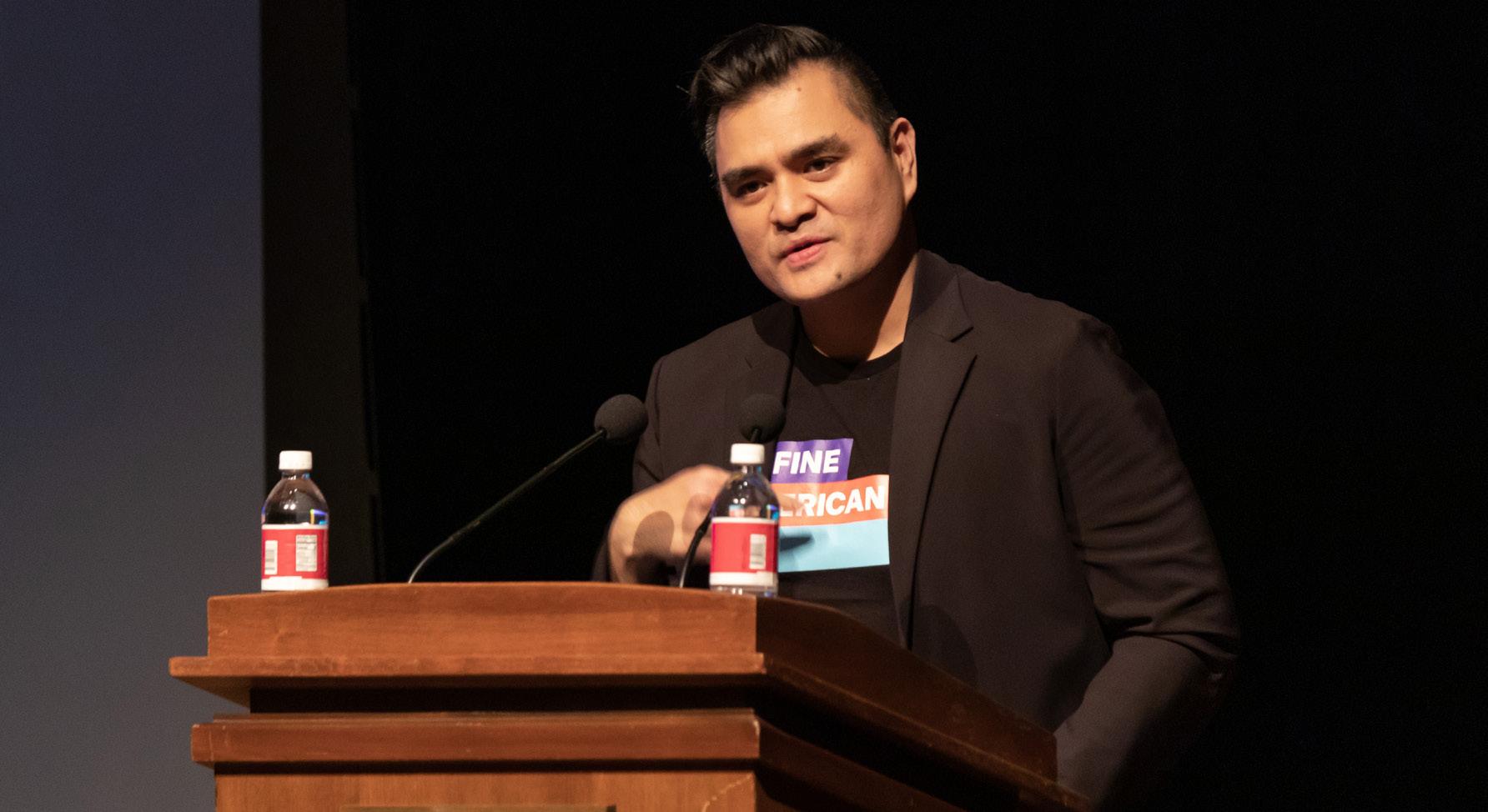
45 million immigrants live in the U.S., with half a million in Ohio, Vargas said. Immigrants from India, China, the Philippines, Mexico and Canada make up 5% of the state’s population, with 90,000 undocumented immigrants.
Once Vargas got to America he was given a green card.
“I was really confused by this because it said ‘resident alien’ and I thought it was a video game,” Vargas said.
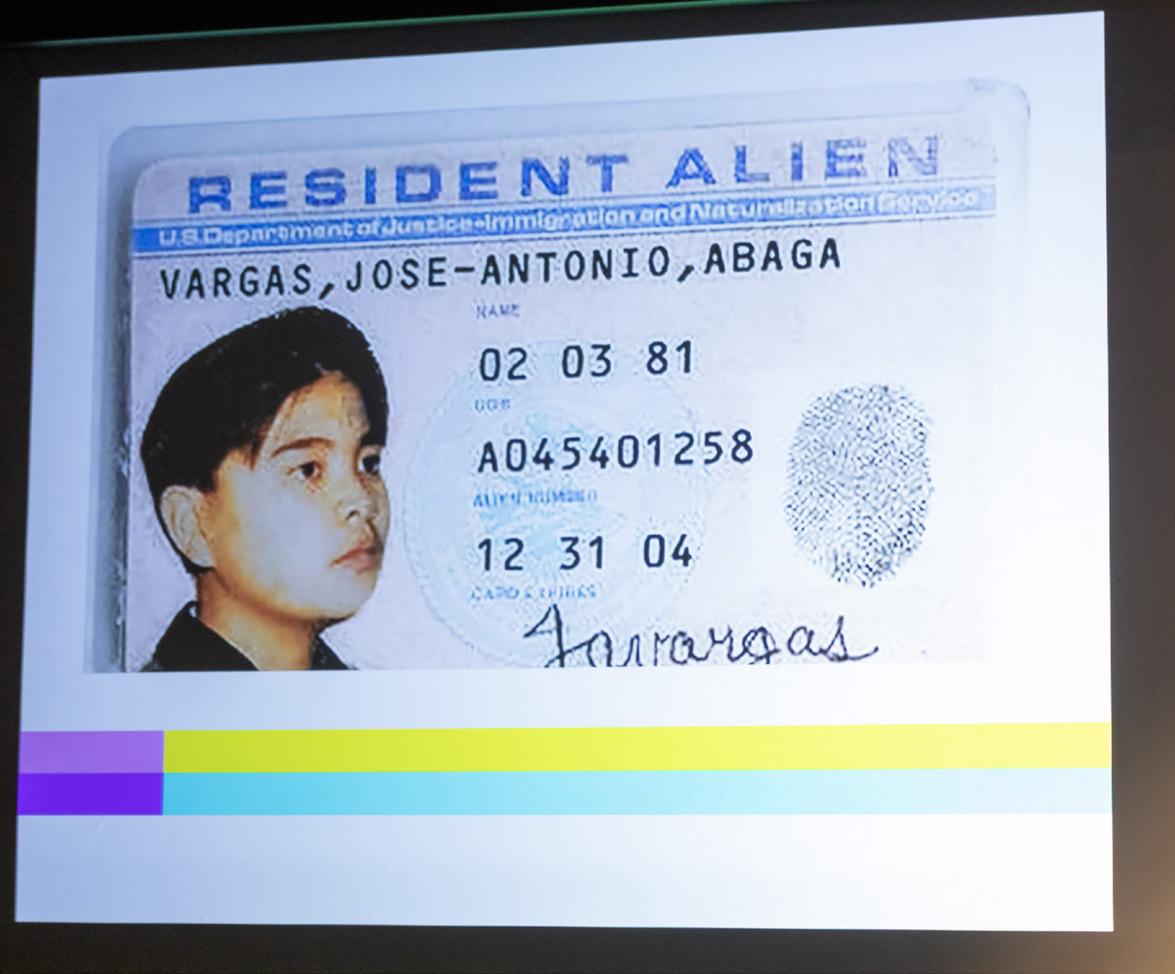
More so than the green card, he was confused about race. He didn’t realize he was Asian until he got to America.
He found out he was an undocumented immigrant from his grandfather. Vargas said the people at the DMV told him his green card was
fake.
“You’re not supposed to be here,” his grandfather said. “What are you doing showing that to people?”
In high school, Vargas was confused about his status and had no way to connect with others like him. However, his salvation came in three forms: his high school principal and superintendent, his teacher Mrs. Dewar and Toni Morrison.
Vargas’ high school principal and superintendent were the first people he told about being an undocumented immigrant. They helped him find a scholarship to go to college that didn’t require legal immigration papers. His mentors when he was 16 asked why he didn’t apply to colleges because he was so engaged in school.
“I didn’t want to be home because then I would have to deal with being illegal at home,” Vargas said.
Mrs. Dewar was the person he asked all of his “annoying questions” to, and she recommended that he become a journalist. Vargas said he had no idea what that even was at the time.
“If my name can’t be on a green card that’s legal, it can at least be on a
piece of paper,” Vargas said. His third salvation was the author Toni Morrison. Her book, “The Bluest Eye,” changed his life because it got him thinking about the questions she was asking.
Vargas said that after reading an interview from Morrison about authority and her protagonist’s surrender to it, he decided he could not become a victim. At some point he convinced himself that an illegal alien and a victim were one and the same. Fourteen years after discovering he was here illegally, he came out as an undocumented immigrant.
Yet, nothing happened. He even contacted the editor at Time Magazine and asked to write a story about why he hadn’t been deported. When he called the New York City Immigration and Customs Enforcement (ICE) office, they offered no comment.
Vargas then wrote about 33 other undocumented immigrants from all over the world who came to America and their historic photo was the cover of Time Magazine. “Mine is just one story. We need more stories to change the anti-im-
migrant narrative,” Vargas said.
Despite writing about immigration issues for years, Vargas has been unable to become a legal citizen. When politicians from both sides ask him about it, he responds with a question of his own. If a very privileged person like Vargas can’t get his papers, then how is someone without his resources going to?
He then continued to talk about immigrants portrayed on television and how they are commonly shown as criminals and underrepresented in general.
He took the information he’s gathered on this topic and went to the Netflix producers and asked if they wanted to make a documentary.
They succeeded; it’s called “Documented.”
He has also written the books, “Dear America: Notes of an Undocumented Citizen” and “White Is Not a Country.”
Drew Barringer, a junior Sports Leadership and Management major, said he feels bad that the amount of immigrants in America from Asia surprised him but it’s kind of just the world we live in right now.
“[This is] a really timely issue that I want to know more about, like immigration in America, because I’ve never had to go through anything like that,” Barringer said.
Josh Myers, a sophomore marketing major, said something that will stick with him was when Vargas said, “This country is addicted to cheap labor.”
“[It’s] such a flooring and very real sense to kind of describe some of the inhuman activities that are happening in America,” Myers said.
When asked how she thinks Vargas did in his speech, Ava Fuschino, a junior media and communications major, said she thought he did a very good job at bringing light to topics that she never would have thought about or considered.
“I think he talked about things in a mature manner,” Fuschino said. “He was very interesting and engaging at the same time.”
stumbata@miamioh.edu
“It helps me destress if I’m at the gym or if I’m just walking around,” said. “Sometimes I use it to just tune people out. [Without music] I feel like I would be forced to be more attentive and aware of my surroundings.” siderie@miamioh.edu
Jose Antonio Vargas: The harsh life of undocumented immigrants in America
Humor Staff ASG President / Vice President Endorsement
TEDDY JOHNSON, CONNOR OVIATT, LILY WAHL, PATRICK SULLIVAN, MICHAEL PATTEE
THE MIAMI STUDENT
Miami University’s Associated Student Government president and vice president elections concluded and The Miami Student Editorial staff endorsed candidates have won. However, the Humor Team would like to recognize the other potential candidates to this race as well (even though it’s over now). Here is a look at who each of our writers would like to see running ASG.
Shrek and Donkey endorsed by Teddy Johnson
Running on the platform, “This is OUR swamp” these candidates hope to build community through swamp renovations within Miami.
“Everyone deserves to have a swamp they feel comfortable in. No one should feel ostracized in this swamp. Our first goal WHEN, not if, elected will be to create swamp sections in each residence hall so students can have their own swamp to relax and listen to ‘All Star’ by Smash Mouth on repeat until they are unstressed,” Shrek said.
Shrek and Donkey are no strangers to being ostracized. Their original campaign in Far Far Away ended in disaster because no one thought an ass could be a vice president.
“Most politicians are assholes anyway, but I’m actually an ass even though I am not an asshole. I just want everyone to be welcomed into a swamp like Shrek welcomed me into his swamp,” Donkey said.
Even though their platform emphasizes everyone sharing a swamp, they are not communists. Instead they want to implement a liberal constitutional swamparchy.
“Essentially, the swamparchy consists of Donkey and I leading from the head swamp, which will be under construction as soon as we overthrow the Humanities Center. After that, swamp construction across campus will commence,” the big green ogre said.
Vote for Shrek and Donkey if you want a new swamp!
Shaggy and Scooby-Doo
endorsed by Connor Oviatt
Shaggy and Scooby hope to make Miami history, as Shaggy would be the first minor elected to student body president, while Scooby would be the first non-human to hold any leadership position on campus. Their platform includes improving on-campus dining and ridding the campus of Helen Peabody.
Shaggy and Scooby have faced many demons in their lives, literally.
One such demon included Western Dining Commons. The duo promises to drastically improve dining options on campus. The two are men of principle and once led a hunger strike against campus dining halls. In lieu of subjecting themselves to the horrors of Miami dining, the candidates subsist on a diet of Scooby Snacks. After walking into Western Dining Commons for the first time, all Scooby could manage to say was “Ruh-roh, Raggy!”
As we all wish we could, Shaggy and Scooby eat cookies for every meal. In fact, Shaggy completed a reverse freshman-15, and is skinnier than ever. Of course, this diet doesn’t result in the best health, which inspired the candidates’ desire for change.
Finally, our brave candidates promise to rid Miami of the scourge that is the Ghost of Helen Peabody. The pair have defeated numerous monsters and ghouls as members of Mystery Incorporated. After experiencing the incredibly terrifying haunted house known as Peabody Hall, Shaggy and Scooby decided that Helen Peabody must disappear once and for all.
Critics argue that Shaggy and Scooby will not be able to defeat Peabody without the rest of Mystery Incorporated. President Greg Crawford, who researches ghouls and monsters in his free time, called Peabody “the scariest monster I have met … aside from my mother-in-law,” and said Shaggy and Scooby are “systemic monster fighters.”
Enemies of Shaggy and Scooby
have criticized the pair’s connection to the disgraced Velma Dinkley. However, Shaggy and Scooby insist that they did not approve of the HBO Max “comedy” and prefer to read The Miami Student Humor Section.
If you want to see improved dining conditions and the end of Helen Peabody, vote for Shaggy and Scooby!
Taylor Swift and Selena Gomez endorsed by Lily Wahl
Taylor Swift and Selena Gomez are longtime friends, meeting through the Jonas Brothers in 2008. Together, they are running for student body president and vice president on a platform encompassing infrastructure and student life.
Swift hopes to improve university infrastructure, focusing on residence hall living conditions. Her credentials are strong, given her history of constructing the greatest bridges of all time. I mean, have you heard “Death by a Thousand Cuts”? “Back to December”? “champagne problems”?
Another infrastructure-related goal of Swift’s is to create a better system for students to get lost objects back, by encouraging them to release ten-minute long call-out songs to exes who stole their scarves.
“It was a Gucci scarf, so I could have gotten the police involved, but in my experience, writing the longest song to top the Billboard Hot 100 is much more efficient,” Swift told The Miami Student.
Gomez proposes an idea for improving student life — an anti-bullying campaign, with the slogan “Kill ‘Em With Kindness.” She promises that the campaign will not be taken literally, despite a Twitter frenzy over the possibility of a “no body, no crime” occurring, citing her recent feud with Hailey Bieber.
Swift also promises to use what she has learned from the ticketing process for “The Eras Tour” to improve student events, referencing visits from Jennette McCurdy and Hank Green to Miami.
The Student asked if Swift had any concerns about her past scandals interfering with her work as student body president.
“I’m just gonna shake, shake, shake, shake, shake, shake it off,” Swift said in response.

Harambe for president and VP
endorsed by Patrick Sullivan
Harambe is, simply put, a record breaker, and he doesn’t plan to stop now. Harambe is running for student body president and vice president: the first ever candidate to deem himself able to run both positions. From his time in the yard, also known as the Cincinnati Zoo, he learned he cannot trust anyone but himself.
His number one priority is the safety of children. The king of the yard plans to create new infrastructure such as high fences and water moats to keep students out of places where they shouldn’t be.
Harambe also plans on having training discussions with the Oxford Police Department about safety on and around campus. By reinforcing the Good Samaritan Policy, he hopes that people, or gorillas, will not be unfairly prosecuted for trying to help some kid in need.
Some of you simple-minded folks might be wondering how he can run a leadership position when he is just a gorilla.
“He’s not even the gorilla that knew American Sign Language,” haters argue. Little do you know, Harambe is the only candidate running for student body president that has ever gotten votes to be the U.S. president. That’s right folks. Our favorite candidate, Harambe, was deemed worthy of the presidency by some brave, future-thinking souls in 2016. Sources disagree on how many votes he got, but some say it was up to 15,000.
Now, some of you even simpler minds might make the very silly claim that he cannot be student body president or vice president because he died. For that, I say go watch “Jurassic Park.” How dare you use ChatGPT to do your homework and assume that today’s technology cannot revive a gorilla from the grave.
If you care about redemption stories and the safety of students all around you, then you should vote for the gorilla, the myth, the legend: Ha-
St. Patrick’s Day as a Patrick
PATRICK SULLIVAN, HUMOR EDITOR
March 17, also known as St. Patrick’s Day, is my Fourth of July.
For the entire week leading up to St. Patrick’s Day, I wear my lucky shamrock underwear. I’ve never washed them because I can’t lose the lucky charm. It’s worth the week-long rash I have following St. Patrick’s Day. I wake up at 3 a.m. and eat an entire raw potato. I do this purely to prove that the Irish Potato Famine of the 1840s doesn’t scare me. As soon as I finish the potato, I high-five a ginger and spit on a Brit to assert dominance.
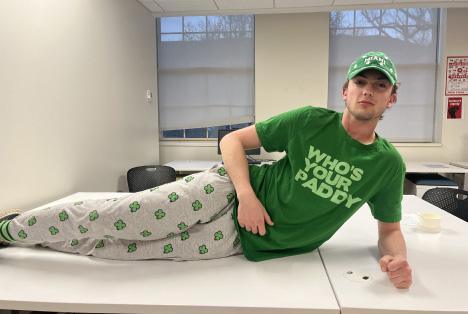
Before leaving the house, I bow seven times to my Irish flag, chug a Guiness and skip all the way Uptown looking for rainbows and leprechauns.
After I finish my bottle of Jameson Irish Whiskey, a small redhead child appears, leading me to mistake him as a leprechaun. I snatch him up while his mom’s back is turned and
skip away from the Oxford Police with my leprechaun who won’t stop crying.
I try to console him with a raw potato, but he throws it at me, despite everyone knowing potatoes are a leprechaun’s favorite food, as he yells that he is not a leprechaun. Little does he know, however, this isn’t my first leprechaun hunt. I know how mischievous they can be, so when he yells for his “mommy” I don’t fall for it.
I explain to the crying leprechaun that as soon as he leads me to his gold I will let him free. I am, of course, referring to a VIP Brick pass.
He tells me that he “doesn’t even know who Will Weisman is.”
After he refuses to lead me to the gold, we go back to my house where I can keep an eye on him until he changes his mind. When I was out buying some Lucky Charms to feed my new leprechaun, my dumb nonIrish roommate got bamboozled by the trickster and the little guy contacted the police.
The Oxford Police Department then raids my houses, giving me flash-
backs to the Irish Civil War that I know nothing about. I’m arrested on accounts of kidnapping and child endangerment.
But, because I am wearing my unwashed, lucky underwear, the cop that arrests me is Officer O’Burke. He sympathizes with my desire for gold and agrees to let me go if I split the gold with him. You and I both know I’m not splitting anything, but he doesn’t need to know that.
At this point in the day, the sun starts to set, and my hopes for finding a rainbow are diminishing. I decide that I’ll just try leprechaun hunting again next year. I put on another shirt with a shamrock on it in order to head to the bars.
The shamrock originally served as a religious symbol that St. Patrick used to spread Christianity. Like any
good Irishman, I am proud to spill green beer all over it at Brick Street.
After an exhausting day of potato farming, beer drinking, Brit spitting and leprechaun hunting, I am exhausted. I call my parents, say good-
Green Beer Dump
rambe. Captain Jack Sparrow and Elizabeth Swann endorsed by Michael Pattee Captain Jack Sparrow and Elizabeth Swann have had quite adventurous lives living out on the sea, avoiding death and drinking rum. However, they are both ready to wave goodbye to that lifestyle — except for the drinking rum part.
Jack first fell in love with Miami after visiting Uptown. The words “Why’s the rum all gone?” never once crossed his mouth during his visit to Top Deck. In fact, it was on this visit that Jack got the inspiration for his campaign slogan “All for Rum, and Rum for All.”
Elizabeth Swann didn’t have much to say about the campaign. She did, however, explain that her husband, Will Turner, would not be returning for nearly a decade. So, family obligations shouldn’t be an issue.
Many critics point to Captain Sparrow’s drinking habits and Elizabeth’s upper-class upbringing as flaws; however, proponents argue that these actually make Jack and Elizabeth incredibly representative of the student body.
The main platform policies surround increased access to alcohol and improving campus safety, specifically against being taken hostage on another campus.
Polling already shows these two exponentially gaining support among those in sororities and fraternities. Additionally, there have been rumors circulating that there has been significant campaign funding promised from Skipper’s Pub and Top Deck.
So don’t let this be the year remembered for almost electing Captain Jack Sparrow, and don’t let the curse of the Black Pearl stop you from voting. Just remember, All for Rum, and Rum for All!
john1595@miamioh.edu oviattcc@miamioh.edu wahllm@miamioh.edu sulli293@miamioh.edu patteemj@miamioh.edu
night to all 17 of my siblings, and go to sleep dreaming of rainbows, gingers and gold. Only 364 more days until I get to do this all over again.
sulli293@miamioh.edu
OVIATT, MICHAEL PATTEE, PATRICK SULLIVAN, THE MIAMI STUDENT
TEDDY JOHNSON,
OPD set to place snipers on roofs of bars to pelt unsuspecting, drunk students with water balloons
Tax-payers push to lower drinking age to 18 after finding out the State of Ohio spends $100,000 on police resources for Green Beer Day
Upperclass students rejoice as they will finally be able to enjoy a day at the bars without first-years
Fraternity launches new philanthropy project serving as a safe house for students being pursued by cops
Man controlling weather frustrated to learn that Miami students will still go Uptown despite high temperature being five degrees
Water fountains at Harrison Hall continue to serve up non-alcoholic beverages to students’ disappointment
Nerdy student who sits at the front of the class gets quality networking time with professors, asks “What is Green Beer Day?”
OPINION: The only thing funnier than the Humor Section is the fact that College Republicans and College Democrats have to share an office in Armstrong
Miami University plans on stationing ROTC members at the outskirts of campus to keep underclass students from leaving to drink Uptown
Humor Editors hold new Editor-in-Chief and Managing Editor hostage, won’t release them until paid New law passed makes skipping class for Green Beer Day punishable by meeting Helen Peabody face-to-face
OPD consults supply chain students after not receiving sufficient breathalyzers prior to Green Beer Day
Student with green hair arrested, police say they “didn’t expect things to turn hairy so quickly”
Sixteen students claim that they saw “Bigfoot but green” and that all the buildings turned green and state that they were “definitely not on ‘shrooms”
Martin Dining Commons announces offerings of green toast on Mar. 16, students claim to have been eating it all year
humor
FRIDAY, MARCH 17, 2023 8
CONNOR
CO-HUMOR EDITOR PATRICK SULLIVAN LOVES ST. PATRICK’S DAY. PHOTO BY TEDDY JOHNSON
The expressive art of tattoos
JULIA QUIGLEY THE MIAMI STUDENT
My first tattoo was done out of impulse.
Don’t get me wrong – I had wanted to get one for years, but I always pushed off the opportunity until I went to Uptown Tattoo with one of my friends my first year at Miami University. After seeing the result of their first tattoo, I scheduled my appointment for two days later with an idea I had in mind for a long time: a rose on my wrist.
It’s basic, yes, but it had meaning to me and it felt like the right time, so it was a good start.

I loved the way it turned out. Tattoos, even small ones, are a huge confidence booster. It felt like I was finally starting to express my dark side, like – yeah, I’m the girl with a rose on her wrist.
I have yet to decide what I want my next tattoo to be, but tattoos have remained a fascination to my spirit. To fulfill my curiosity about the tattoo culture, I went to Vertigo Uptown and interviewed the owner and my friend, Steve Cupp.

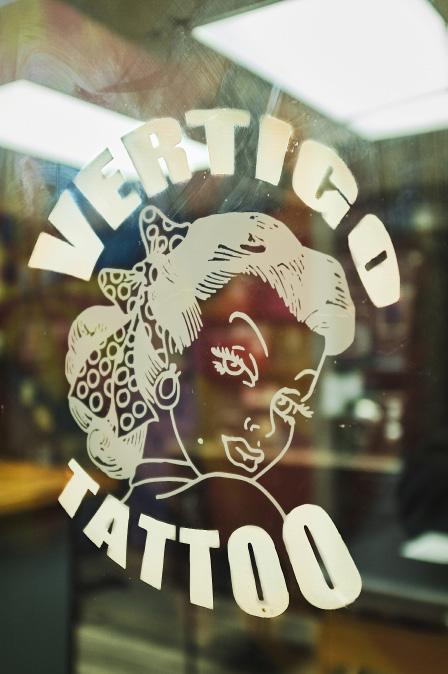


Cupp has been tattooing for 26 years. While we spoke, he made clear his stance on which tattoos he’ll do and which ones he won’t.
“My policy for tattooing is this: if I’m going to be upset and embarrassed by the tattoo in a year, I’m not going to do it,” Cupp said. “Like anything related to hate — confederate flags and swastikas — we can’t get tricked into doing something related to it. We don’t wanna be the source of embarrassment for this town.”
He continued speaking while working on his client.
“I guess I’m just so entrenched in the tattoo culture,” Cupp said. “I have friends that are tattoo artists, and we all hang out.”
I observed the illustrations on the walls, including the bathroom, which was covered floor to ceiling in drawings of The Joker. I had never actually been inside the store before, so there was much to visually process as we con-
versed.
“So do you have any tattoos?” Cupp asked me. I replied that I have a rose on my wrist.
“You’re going to go to hell when you die,” Cupp joked.
If you or someone you know is planning on getting a tattoo for the first time, here are seven pieces of Cupp’s advice:
1. Do your homework. Don’t get tattooed in somebody’s kitchen.
2. Don’t drink and get tattoos.
3. Don’t get your throat tatted.
4. Be respectful (don’t be late to your appointment).
5. Don’t get the sides of your fingers tattooed. They age terribly.
6. Do some research into the tattoo, where you want it and look up how it looks when it’s healed. Never look up the word “tattoo” when searching for inspiration.
7. The stigma is real. If a potential employer sees your forearm tattoo, you might not get the job. Then again, that’s less common than it used to be. Some get tattoos for the meaning, while others get them for the look.
Brittany Wolf, sophomore psychology major, has three tattoos, one of them being a matching bear above her ankle she got with her best friend. Wolf shared her opinion on aesthetic tattoos, or tattoos just for style purposes.
“I mean, people can do what they want but for me, there has to be some kind of meaning or significance to either a person or some kind of thing that means a lot to me,” Wolf said. “So, whether it’s my nieces’, which are my butterflies, or my best friend’s, which is a bear.”
I asked her if she plans on getting more tattoos.
“I do, it’s just that they’re expensive and I really want to plan them out and really love the idea before getting them, because it is permanent,” Wolf said.
quigleje@miamioh.edu
From old Hollywood to grunge, grunge to coquette – Lana Del Rey has done it all

moon” (2015), boho during her “Lust For Life” (2017) era, stripped back for “Norman Fucking Rockwell!” (2019), ’50s housewife and pearl-clad for “Chemtrails Over The Country Club” (2021) and in a yellow sundress for her latest album, “Blue Banisters” (2021).
But throughout every era, Del Rey has had a few consistent staple pieces for her looks.
These include white dresses, Priscilla Presley-esque eyeliner and, of course, soft, feminine florals. These are all things that have made Lana Del Rey the face of the “coquette” aesthetic, the hyper-feminine girlygirl style that’s taken the internet by storm.
Del Rey has especially embraced this aesthetic for the promo of “Did You Know That There’s A Tunnel Under Ocean Blvd,”which is her newest album, set to release March 24.
dressed in a white lace Dior dress, a veil and Swarovski jewelry styled by Mel Ottenberg.
Del Rey is the queen of wedding dresses, as she’s donned the same aesthetic for her “Ultraviolence” music video as well as in a photoshoot for Flaunt Magazine in 2017.
Ottenberg also has Del Rey in a flowy, puffy-sleeved gown, a white turtleneck and a black getup paired with a leather jacket for the photoshoot, which throws back to her “Ultraviolence” era.
Her makeup for the shoot is the definition of coquette – blue eyeshadow, her classic eyeliner and a nude, glossy lip.
“Born
collaborator A$AP
sophomore album, is grunge-inspired and touches on heavier subjects. The photoshoot for the album (shot by Neil Krug) shows Del Rey adorned in leather and jean-clad, which are staples of the ’80s/’90s grunge culture.
Del Rey does this with every album. She was beachy for “Honey-
On her website, pearl necklaces and the iconic brass lighter are sold, as well as exclusive album covers that show Del Rey with bows in her hair and wearing colorful sweaters, both of which are traditionally soft and feminine fashion pieces.
On Feb. 14 on her ultra-exclusive Instagram account, @honeymoon, Del Rey posted her recent photoshoot for Interview Magazine, where she is
People who identify with the coquette aesthetic on TikTok mimic Lana Del Rey’s eyeliner for their makeup looks, which is so distinct to her look. No other musicians this day and age resonate with old aesthetics as much as Lana Del Rey does, and her makeup is an obvious reflection of that.
It’s unclear whether more promotions and peeks at her new aesthetic will come out, especially as the album’s release date is creeping up. But the vibe for it is unmistakably Lana, and I’m so here for it.
leeam8@miamioh.edu
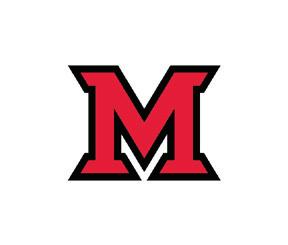

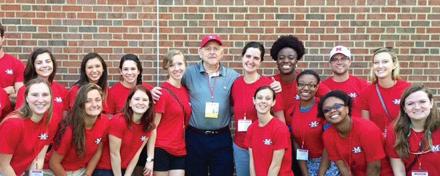
style FRIDAY, MARCH 17, 2023 9 Are you a: • writer • photographer • designer • or illustrator? Visit miamistudent.net to Join the TMS Team!
LOCATED UPTOWN, VERTIGO TATTOO SERVES THE OXFORD COMMUNITY. PHOTO BY KENNETH DECROSTA. ALLISON LEE STAFF WRITER
her debut album “Born To Die” in 2012, all the way to the release of her latest single “A&W” last month, Lana Del
has constantly changed her aesthetic to match the vibe of whatever music
releases.
From
Rey
she
To
a style widely known as “Americana,” with music videos portraying her as style icons like Marilyn Monroe and
nedy, alongside
Rocky
F. Kennedy.
Die” had
Jackie Ken
as John
“Ultraviolence” (2014), Del Rey’s
CUPP HAS BEEN A TATTOO ARTIST FOR 26 YEARS.
CUPP WORKS ON A TATTOO FOR A CLIENT.
Apply today! The alumni association is looking for awesome Miami students to work with us June 7-11 during Alumni Weekend. Thousands of alumni head back to Oxford for a weekend of Miami fun, but we can’t pull it off without YOU! Earn some extra summer cash, make connections with alumni of all ages AND drive a golf cart around campus all weekend. Apply by May 22. We can’t wait to hear from you! Learn more and apply at
PHOTO BY KENNETH DECROSTA
PHOTO BY KENNETH DECROSTA STEVE CUPP IS THE OWNER AND ARTIST AT VERTIGO TATTOO AND BODY PIERCING. PHOTO BY KENNETH DECROSTA
GRAPHIC BY MACEY CHAMBERLIN
Savage’s World Junior Championship experience helps him lead RedHawks hockey program
JEFFREY MIDDLETON THE MIAMI STUDENT
The 2022-23 hockey season has wrapped up for the Miami University RedHawks. For sophomore forward Red Savage, he not only got to experience the college atmosphere but also the atmosphere on an international stage.
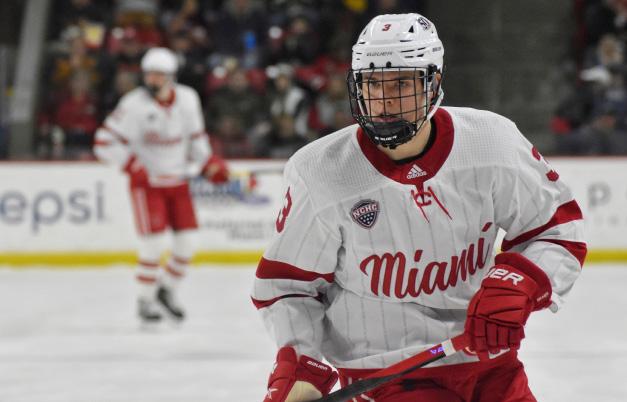
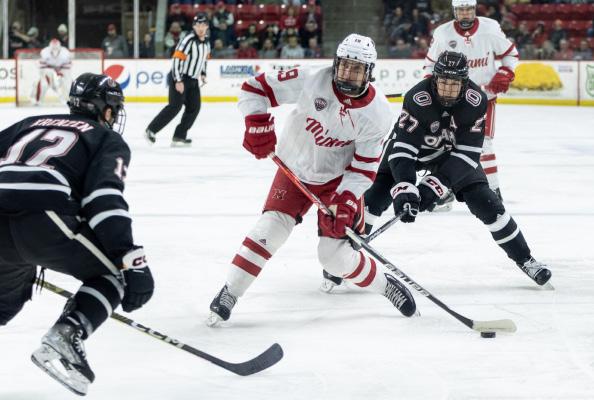
Savage is one of two NHL-drafted players on Miami’s roster (the other is goaltender Logan Neaton, property of the Winnipeg Jets), and he also represented the RedHawks over Christmas and the new year, participating in the 2023 World Junior Championships in Halifax and Moncton, Canada, with Team USA.
Savage has been a part of the USA Hockey program since he started playing for the U.S. National Team Development Program in 2019. He was a returning player to the under-20 Team USA World Junior roster at the tournament in 2023.
“I knew that I would have a good chance of making it because I was there the year before, so I had a lot of confidence, which was really key for me,” Savage said.
Savage played with and against some of the best young players in the
world. He was successful on an individual level while doing so, scoring three goals and three assists for a total of six points in seven games.
Savage was a key contributor to Team USA’s bottom-six forward group and its bronze medal win, and he even recorded an assist on the overtime winner in the bronze medal game against Team Sweden.
The biggest hurdle for Savage was going into the tournament and understanding the role he would play across the tournament games against a “stacked” team like Canada or surprising teams like the Czech Republic and Slovakia.
“Going into those big tournaments, every single guy on that team is the best player from their hometown or their home state,” Savage said. “They’re the best player on the team they’re currently on. It’s all about managing your role and managing the people around you so that everyone can come together and play the best hockey they possibly can as a team.”
Savage talked further about playing his role to the best of his ability and not worrying about how much ice time he was getting as one of the older players and leaders of the group.
“A lot of people know they’re the best, and they want to have all the playing time, but I just went in with the mindset that there’s a good chance I’m not going to be in the top six of the forwards or be on the power play, so just try and do my role as best as possible and make the best out of the position I was playing,” Savage said.
Being a returner and a former captain of the under-18 U.S. hockey team only a couple of seasons ago, Savage was one of the assistant captains for the bronze-medal-winning team.
With that responsibility on the international stage comes helping to lead the team back at Miami as well. Savage said he tries to instill the same level of confidence in Miami’s team that the top players possess.
“After playing with [Team USA] and playing with a lot of the best players in the world, you see how those guys operate; you see that they’re not afraid to make mistakes,” Savage said. “You play a hell of a lot better when you think you’re going to beat the person you’re going up against. I think trying to instill as much confidence in the group of guys here is something I tried to bring back.”
Miami Athletic Director David Sayler named to College Football Playoff Selection Committee
Savage also spoke about a few differences between the tournament team and the team at Miami, one o which was the age of the players around him.
“I was one of the oldest guys on the team, and here at Miami, I’m the youngest guy on the team,” Savage said. “I just try to lead as much as I possibly can here.”
Although the 2022-23 regular season for the RedHawks was largely
disappointing, having a player with the experience that Savage does will help the future of the program. Not only did Savage make himself known on the international stage, but he helped bring attention to the program at Miami, and these experiences will help him as he grows with the team.
middleje@miamioh.edu
WILL KEHRES STAFF WRITER

Miami University Director of Athletics David Sayler will be joining the College Football Playoff (CFP) Selection Committee, with his three-year term starting later this spring. Sayler is entering this new role alongside two fellow new committee members, Chris Ault from the University of Nevada and Jennifer Cohen from the University of Washington.

Following the introduction of the College Football Playoff in 2014, the CFP Selection Committee has become an integral part of the college football landscape. The committee is responsible for ranking the top 25 teams in the nation, assigning teams to the New Year’s Six bowl games and choosing which teams will compete in the four-team College Football Playoff each season.
Sayler said there’s no defined pathway for becoming a committee member. He found his way into the position after attending a mock exercise for the CFP in 2021.
“It was a crash course in how they do this,” Sayler said. “One of the current members of the committee, Gary Barta, was my coach for the session and walked me through how they do it normally, versus how we were doing it. It was a good chance for me to understand how the process worked from there.”
A year after attending the mock exercise, Sayler explained that Jon Steinbrecher, the commissioner of the Mid-American Conference (MAC), informed all of the conference’s athletic directors that a spot on the committee would be opening up for a MAC representative. The athletic directors all voted, and they chose Sayler. As a member of the selection committee, Sayler said he’ll be responsible for watching all of the games for one or two conferences and for being knowledgeable about all of the teams in those conferences. Fortunately, there are tools available that make this task less time consuming than people might expect.
“They’ve informed us that there is technology available to watch games a lot quicker than most of us do just on our own,” Sayler said.
“No commercials, no huddles and you can get through a game in about 30 to 40 minutes.”
In addition to observations from various committee members and traditional statistics, the selection committee also uses a computer algorithm to compare different teams while making ranking decisions.
“When I went to this exercise in 2021, it really showed me a lot about how the computer algorithm works,” Sayler said. “This showed me how detailed the individual team sheets are for every program and all the different metrics that they look at. It was really helpful for me to understand more about how the computer works and the kinds of things that certainly can move the needle in terms of discussion about one team versus another.”
Sayler’s first official meeting with the selection committee will be in Houston later this month. After that, the committee holds a meeting in Florida to kick off the start of the season before gathering in Dallas to complete the CFP rankings each week from Week 9 until the end of the season.
According to Sayler, these new responsibilities will not have much of an impact on his work at Miami.
“I’m fortunate to have a really good staff of people that will be able to do what we need to here in the office while I am traveling, but I’ll certainly stay connected to everybody while I’m traveling and whatnot,” Sayler said. “I don’t anticipate it having any direct effect on my duties here at Miami, which is a good thing.”
With the new football season inching closer, Sayler is thrilled about getting started in his new role.
“It’s certainly been really nice to hear from all the people around the country that have reached out to say congratulations,” Sayler said. “A really exciting future for us to be able to be a part of this and I look forward to it.”
kehreswe@miamioh.edu
Miami hockey (8-24-4, 3-18-3 NCHC)
TEDDY JOHNSON CO-HUMOR EDITOR
Miami University first-year defenseman and Stockholm, Sweden, native Axel Kumlin chose to play at Miami over other prominent hockey schools and professional hockey teams in Sweden.
Kumlin started playing around the age of four when his dad brought him to a local rink in northern Stockholm to play with some friends. He played for multiple youth clubs in the Stockholm area before a Gothenburg high school recruited him to play. Then, at 15 years old, Kumlin lived by himself in a Gothenburg apartment while playing for his high school and practicing his game.
When the time came for Kumlin to move on to a higher level of hockey, he faced a dilemma of whether to stay in Sweden to play professionally or to come to the U.S. and play.
“I had a shoulder surgery, and I was in between, ‘Do I want to play pro in Sweden or do I want to come over here and try to play here or what do I want to do?’” Kumlin said.
Eventually, his advisor helped him to find a home in Dubuque, Iowa, to play for the Dubuque Fighting Saints of the United States Hockey League (USHL).
“My advisor in Sweden had a good connection with the general manager in Dubuque because he is from Sweden too,” the 6-foot, 195-pound defenseman said.
Dubuque plays in the highest tier of junior hockey in the U.S. Countless USHL players go on to play hockey for NCAA Division 1 teams, and many end up playing in the NHL.
In his 58-game campaign with the Fighting Saints in 2021-2022, Kumlin tallied five goals and seven assists, all while amassing a plus/ minus of +24.
One of Kumlin’s Swedish teammates on the RedHawks, William Hallén, played with him for Dubuque and in Sweden before coming to Miami.
Due to the USHL’s reputation as a top league, many college teams come out to games and scout potential players, which is how Kumlin got in contact with Miami.
The Swedish defenseman received offers from other prominent hockey schools in the
Big Ten, Hockey East and even the National Collegiate Hockey Conference. He even debated going back to Sweden, but ultimately decided on playing college hockey in the U.S.
“The college option is only going to be there once, and if I don’t take it, it’s gonna be gone forever,” Kumlin said.
Even with the multitude of offers Kumlin received, he chose Miami. The amount of playing time he would be receiving here played a huge role in his decision to play for the RedHawks. Kumlin played 32 games for Miami this season, a mark matched by only one other first-year on the team.
“I talked to the coaches, Coach Bergeron and Coach Schutte, and they both wanted me to play a lot as a freshman.” Kumlin said. “It’s not that common as a freshman in the NCHC to play those types of minutes … It was too good of an offer to turn down.”
Furthermore, Kumlin loved the campus and knew that if his Swedish teammates liked it, he probably would too.
“I knew two Swedish guys on the team, Hampus [Rydqvist] and Ludvig [Persson], and they said they love this place.” Kumlin said. “We come from the same culture, so if they like it, I’m probably gonna like it too.”
He spoke highly of the Goggin Ice Center facilities, which contributed to his decision to play for the RedHawks.
“[The arena is the] perfect amount [size] for a college school.” Kumlin said. “The locker room and lounge area are top 10 in the country.”
Kumlin said that the team plays in lots of big arenas around the NCHC that are mostly empty, even though lots of fans are there. Because Goggin is smaller, the arena feels more packed and creates a fun environment to play in.
The Swedish blue-liner aspires to eventually play pro, but for now he’s taking things year by year.
“I’m just trying to play as best as I can every game and not look too far ahead,” Kumlin said.
Kumlin put up three goals and eight assists in his first season with the RedHawks.
john1595@miamioh.edu
National Collegiate Hockey Conference standings
FRIDAY, MARCH 17, 2023 sports 10
RED
SIX POINTS IN SEVEN GAMES AT THE 2023 WORLD JUNIOR CHAMPIONSHIPS PHOTO BY JAKE RUFFER
SAVAGE FINISHED WITH
DAVID SAYLER BEGINS HIS THREE YEAR TENURE ON THE COLLEGE FOOTBALL PLAYOFF COMITTEE LATER THIS SPRING PHOTO BY JAKE RUFFER
Axel Kumlin: ‘I’m just trying to play as best as I can every game and not look too far ahead’
AXEL KUMLIN WAS ONE OF MIAMI UNIVERSITY’S TOP DEFENSEMEN IN HIS FIRST SEASON PHOTO CONTRIBUTED BY JOSEPH ZAK
stats leaders Player Games Goals Assists #29 Matt Barbolini 34 10 15 #8 PJ Fletcher 36 5 10 #22 Joe Casetti 34 10 5 #13 Max Dukovac 31 1 14 #16 Hampus Rydqvist 36 3 11 #32 Ludvig Persson, goalie (8 wins, .891 save percentage, 3.67 goals against average) Denver Western Michigan Omaha St. Cloud Duluth North Dakota Colorado Miami Conference 19-5-0 15-8-1 13-9-2 12-9-3 10-14-0 10-10-4 6-15-3 3-18-3 Overall 30-8-0 23-14-1 19-15-3 22-12-3 16-20-1 18-14-6 12-21-3 8-24-4
Miami alum Buddy Schultz is much bigger than his unbreakable strikeout record
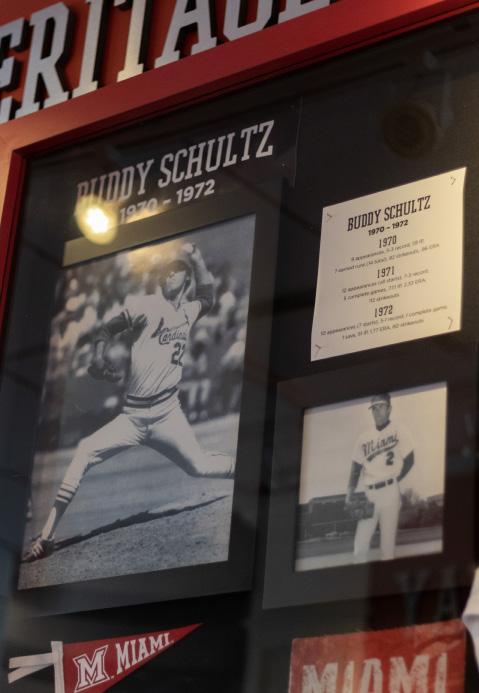 JACK SCHMELZINGER SPORTS EDITOR
JACK SCHMELZINGER SPORTS EDITOR
With the college baseball season officially in full swing, it’s the perfect time to remember Miami University alumnus Buddy Schultz, who holds one of the most incredible records in NCAA baseball history. I’d challenge anyone to find one less likely to be broken. What he’s accomplished since his playing career ended is even better.

Schultz, from East Cleveland, Ohio, spent three seasons playing baseball at Miami. On April 3, 1971, he struck out 26 batters in a nine-inning game. For context, a baseball game has 27 outs. The batter he didn’t strike out? He bunted. Schultz fielded the bunt and threw to first. He made all 27 outs in that game.
What he’s done since may be even more impressive.
The good samaritan
Schultz estimates that he’s raised more than $30 million to help kids
play baseball since his playing career ended.
In 2010, Schultz was inducted into the Greater Cleveland Sports Hall of Fame. Around the time of his induction, he got a call from the Parks and Recreation Director of the City of East Cleveland, who was calling on behalf of the Mayor, Gary Norton. Schultz and the Mayor met at a field, and the mayor asked for Schultz’s help.
“Gary Norton said ‘we haven’t played baseball in the City of East Cleveland for 24 years,’” Schultz said.
“I said ‘you’re kidding.’”
Schultz raised $100,000 in three months. He and his people bought hats, shirts, jerseys, pants, socks, shoes and a glove for 127 kids and fixed up the fields.
“Around opening day, I got sent a copy of this email,” Schultz said. “It was from a mother, and this mother says … ‘I wanted you to know that because of you, my son received his first baseball glove ever. When they handed him the glove, he turned to me, and he held up both hands. Because he didn’t know what hand the glove went on.’”
The $100,000 he raised put 127 kids on the baseball field. Imagine the impact $30 million dollars made.
“At that point, $30 million became worth it for that one kid,” Schultz said. “It’s not about the volume. It’s about ‘wow, I made an impact on a kid.’ That’s really what motivates me to do more.”
Schultz’s generosity and passion for helping kids play isn’t borne by a feeling of obligation.
“I’m always appreciative for the talent God gave me,” Schultz said. “He gave me the ability to use it, and it’s given me everything in my life. By helping kids now, it’s like maybe I can give them a little bit of the op-
portunity I had.” The record
On that fateful day in 1971, it was the fifth inning before Schultz realized what he was in the middle of doing.
“The first thing I remember was I sat down after five innings,” Schultz said. “And a guy named Pearl Barney, who lived on my floor, came up to me and said ‘Hey Buddy, do you realize you struck out everybody so far?’ And I was like ‘Really?’”
By the middle of the sixth inning, Schultz had struck out the first 16 batters.
“And the next guy hits a fly ball to right field,” Schultz said. “And Denny Smith [Miami’s right fielder] never moves. The ball bounces about five feet from him. We sit down after the sixth inning and I say ‘Denny! Is there any special reason you didn’t catch that ball?’ And he says ‘To be honest, you were striking everybody out, and I wasn’t paying any attention.’” Schultz struck out the side in the next couple of innings, and then in the ninth, a couple of guys got on. Miami was up 6-0, but legendary former head coach Bud Middaugh still wasn’t happy.
“Middaugh came out and said ‘I don’t care how many strikeouts you’ve got, if the next guy gets on, I’m taking you out of the game,’” Schultz said. “I’m thinking to myself, ‘I’ve struck out 24. We’re winning 6-0. What’s your problem?’ But it motivated me.”
And he finished the game with 26 strikeouts, a record that will never be broken.
Things were different back then.
The NCAA didn’t recognize Schultz’s record until about 25 years ago, because it didn’t know about it.
“I actually had to prove it to the NCAA,” Schultz said. “I had to send them some articles that were written about it. They had some guy with 24 as the record. I had 26. I was like ‘what are you talking about?’”
If you’re reading this, it’s a record that won’t be broken in your lifetime, unless maybe robots start playing
baseball. For context, pitchers today almost never throw more than 100 pitches in a game. There are only 27 outs in a baseball game, so you can see how impressive 26 strikeouts is.
“That’s the last thing I’m worried about,” Schultz said. “Somebody breaking 26. I threw about 180 pitches that day.”
The rest
Schultz’s playing career at Miami ended in 1972 when he was drafted by the Chicago Cubs in the sixth round of the MLB June Amateur Draft. By that time, he had amassed 240 strikeouts and a career earned run average (ERA) of 1.77 at Miami. He signed with the Cubs for $6,000, and after his first season in pro ball used that money to finish his Miami degree. Schultz had to wait until 2010 to be inducted into the Miami Athletics Hall of Fame because the university didn’t realize he had graduated.
“I got a call in 2008 from Denny Smith [the right fielder] who was a player at Miami,” Schultz said. “He was telling me the names of all these baseball players who were in the Miami Athletics Hall of Fame. I said ‘Denny, how come I’m not in this damn Hall of Fame? I’m better than all these guys.’”
Schultz and his massive network of contacts quickly got that issue sorted out.
He’s made a huge impact fundraising for the Miami Athletic Department too. When the Jay Hayden Baseball Center was being constructed, a donor who had pledged more than $1 million to pay for the turf field pulled out at the last minute. Schultz spearheaded an initiative to raise the money and did it. More than $1 million in less than three months from 12 different donors.
Around that time, when Bud Middaugh was elected to the Miami Cradle of Coaches association, one of the
donors in attendance requested a seat at Schultz’s table.
“The Miami people were like ‘oh, you can’t ask him for money,’” Schultz said. “‘He’s already done this over here.’ So he sat down, and afterwards, I went to [former Miami Deputy athletic director Jude Killy] and said, ‘well he’s gonna give us $100,000 towards the turf.”
Schultz had a good big league career. From 1975-1979, he pitched 240 innings with a 3.68 ERA. In 1977 he had a 2.32 ERA and went 6-1 with the St. Louis Cardinals. He had a good big league career. Not 26 strikeouts good.
But $30 million? Countless kids put in baseball gear and on the baseball field? Given a chance to play a game that has given so much to so many? I’d say that’s 26 strikeouts good, at least.
“I believe at some point, after I’m dead and gone, I’m going to stand before God,” Schultz said. “And he’s going to say ‘what did you do with that 95 mile-per-hour fastball I gave you?’ My reply is going to be ‘I helped a lot of kids.’ I hope he likes that. Because I really think that I have.”
schmelj2@miamioh.edu
Miami sees marginal success in winter sports
Next, the RedHawks picked up a decisive win at home over Bowling Green State University, and then torched Ohio University, who ended up as the MAC five-seed, to extend their win-streak to three. They beat lowly Western Michigan University on the road in the next game to extend it to four. The RedHawks were on a roll after starting the season 2-11. They went into the final game of the season at the University of Buffalo in good shape. Win and they were in. But they lost. Still, the rest of the MAC scoreboard shook out in their favor — Eastern Michigan University, Central Michigan University and Bowling Green all lost on the final day too — and Miami grabbed an improbable bid to the playoffs.
JACK SCHMELZINGER SPORTS EDITOR
Miami University wrapped up its women’s and men’s basketball seasons and its hockey season last weekend. Nobody won a playoff game or finished first in the conference, but no teams went winless either. Here’s a short roundup of each of those seasons.
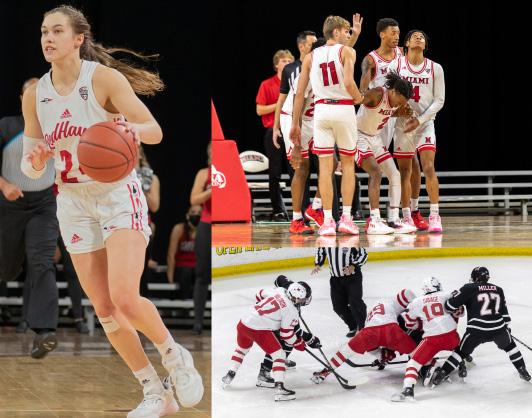
Men’s basketball (1220, 6-12 MAC)
Miami’s men’s basketball team reeled off a pretty impressive win streak to take control of its destiny
by the final day of the season. Firstyear Head Coach Travis Steele’s team wasn’t always easy to watch this season, but it won four games in a row, including two on the road, when it really counted and somehow made it to the Mid-American Conference (MAC) tournament. The streak started with an improbable comeback win at Northern Illinois University that included a 14-0 run to close out regulation. Senior forward Anderson Mirambeaux sank his fourth three-pointer of the season as time ran out to send the game to overtime, and Miami ended up winning 66-65.
Miami women’s basketball (12-19, 7-11 MAC) final stats leaders
Player (points per game (ppg), rebounds per game (rpg), assists per game (apg) field goal percentage (fg%), 3-point percentage (3p%))
The RedHawks lost 75-91 to The University of Toledo in their MAC tournament game, but there’s no shame in losing to a better team. Toledo, one of the best offensive teams in the nation, had won 16-in-a-row going into that game.
The future is intriguing for these RedHawks. Star guard Mekhi Lairy is out of eligibility, so they’ll have to replace his 17.3 points per game. Defensive specialist guard Bryson Tatum and scoring wing Kamari Williams have both entered the transfer portal. Other than that, the RedHawks will return their main contributors.
The RedHawks are also bringing in an impressive recruiting class. It’s going to be a young but talented team in 2023-2024. The RedHawks might
surprise some people next year, but make no mistake: they’re on the right track.
Women’s basketball (12-19, 7-11 MAC) Miami women’s basketball still hasn’t made a MAC tournament during DeUnna Hendrix’s four seasons at the helm, but damn they were close. The RedHawks entered their final game of the season controlling their own destiny. If they had beaten Ball State (25-8, 14-4 MAC) at home on the final day of the regular season, they would have been headed to Cleveland and the MAC tournament as the six-seed. Instead they lost 6877 to one of the best teams in the MAC and had to watch their conference dance from home.
The future is bright though for the RedHawks. Three-time All-MAC guard Peyton Scott is returning for her fifth season, and the other two leading scorers from this year’s team, Ivy Wolfe and Madi Cluse, will be entering their junior seasons. If Miami can build a complete game against those three prolific scorers, the RedHawks could be pretty darn good in 2023-2024. Hockey (8-24-4, 3-13-2 National Collegiate Hockey Conference (NCHC))
Like it has every season since 2015-16, Miami hockey finished in the bottom two of the NCHC. This year it finished last, three wins worse than Colorado College, their usual basement mate who finished seventh.
The RedHawks went to Magness Arena last weekend to play Denver, the reigning national champions in the NCHC playoffs and got swept, 2-6 on Friday and 2-7 on Saturday. There’s not much to say about this team that I haven’t already said in countless articles over the last few years, but last season’s recruiting class was fourth-year Head Coach Chris Bergeron’s best at Miami so far, and with those players entering their sophomore years, there is hope.
If Bergeron can make some noise in the transfer portal this season, he has a pretty decent core to build around. If Miami could snag a couple of top end forwards, a good defensive center, and maybe a couple of right handed defensemen, it could be in good shape come 2023-2024.
This team had some shining moments this season. It beat No. 5 St. Cloud State University 5-0 at home back in December. It played close with or beat every NCHC team this year except for Denver. That’s no small feat in college hockey’s best conference. They’ll need to get a lot more consistent though, and this is still the same team that got outscored 2-32 in its first eight games of 2023 (yes, you read that right).
Overall, it was a largely unsuccessful winter sports season for Miami Athletics, but each team gave reason for at least a little bit of hope this summer.
schmelj2@miamioh.edu
Mid-American Conference women’s basketball standings
Miami men’s basketball (12-20, 6-12 MAC) stats leaders
Player (points per game (ppg), rebounds per game (rpg), assists per game (apg) field percentage (fg%),
percentage (3p%))
* Toledo won the MAC women’s tournament championship, 75-74 over Buffalo
Mid-American Conference men’s basketball standings
* Kent State won the MAC men’s tournament championship, 93-78 over Toledo
FRIDAY, MARCH 17, 2023 11
BUDDY SCHULTZ ESTIMATES THAT HE HAS RAISED MORE THAN $30 MILLION TO HELP KIDS PLAY BASEBALL PHOTO BY JAKE RUFFER MIAMI ATHLETICS HAD A LARGELY UNSUCCESSFUL WINTER SEASON PHOTOS BY JESSICA
NAHAN
JAKE RUFFER
THE BALL FROM BUDDY SCHULTZ’S 26TH STRIKEOUT RESIDES INSIDE THE JAY HAYDEN BASEBALL CENTER PHOTO BY JAKE RUFFER
MO
AND
Ivy Wolf (17.0 ppg, 3.2 rpg, 3.8 apg, 39.8 fg%, 37.8 3p%) Peyton Scott (15.4 ppg, 5.4 rpg, 2.6 apg, 42.8 fg%, 36.7 3p%) Maddi Cluse (14.9 ppg, 8.1 rpg, 3.1 apg, 42.3 fg%, 32.2 3p%) Amani Freeman (8.4 ppg, 5.1 rpg, 0.7 apg, 59.4 fg%, 0.0 3p%) Sierra Morrow (7.4 ppg, 4.1 rpg, 0.8 apg, 44.5 fg%, 31.6 3p%)
3-point
Mekhi Lairy (17.3 ppg, 3.3 rpg, 3.9 apg, 46.5 fg%, 36.9 3p%, 92.2 ft%) Morgan Safford (15.4 ppg, 5.9 rpg, 2.4 apg, 47.3 fg%, 34.7 3p%) Anderson Mirambeaux (14.3 ppg, 5.7 rpg, 2.6 apg, 53.7 fg%, 25.0 3p%) Ryan Mabrey (8.4 ppg, 1.9 rpg, 1.1 apg, 37.5 fg%, 32.5 3p%) Kamari Williams (6.4 ppg, 3.1 rpg, 0.54 apg, 39.7 fg%, 32.0 3p%) *Toldeo BGSU Ball State Kent State Akron Northern Illinois Eastern Michigan Buffalo Western Michigan Miami Central Michigan Ohio Conference 16-2 14-4 14-4 12-6 8-10 8-10 7-11 7-11 7-11 7-11 4-14 4-14
Toldeo *Kent State Akron Ball State Ohio Buffalo Northern Illinois Miami BGSU Central Michigan Eastern Michigan Western Michigan Conference 16-2 15-3 13-5 11-7 10-8 9-9 9-9 6-12 5-13 5-13 5-13 4-14 Overall 28-4 27-6 25-8 21-10 17-13 16-14 15-15 12-16 12-17 12-19 6-23 6-23 Overall 27-8 28-6 22-11 20-12 19-14 15-17 13-19 12-20 11-20 10-21 8-23 8-23
To my dad & to my journey
for laptops and physical page layouts for InDesign files, the same energy and passion that poured into the pages of KAOS have poured into the pages and staff of The Miami Student.
I consider myself the luckiest girl in the world to be the daughter of my dad, and to have shared this moment of my life with him, in this way, has been deeply meaningful. I owe and dedicate this experience to him.
My dad, having retold his rebellious and exciting days with KAOS, inspired me to go into TMS’s newsroom my first year and try to get my name in the paper.
And now, if I told that version of myself where I am now, I would be shocked. I distinctly remember sitting in on my first Editor-in-Chief election with The Student, and the thought briefly crossed my mind that, maybe one day, that could be me. I also remember dismissing the thought rapidly.
Now, I’m so proud. I’m sad. I’m full of passion. I’m ready to take the next step in my life because of the lessons I’ve learned here, the people I’ve met on staff and the role I got to play in this newspaper’s history.
I’ve grown as a person, a leader, a worker and a citizen as Editor-in-Chief. I’ve gotten to know so many sharp, genuinely good people throughout my years on staff. Together, we’ve laughed, listened, stressed, worked, wrote and designed A LOT. And we did it all so that community members could be informed, some could be held accountable and everyone could be heard.

Thank you to the TMS staff. I couldn’t have done anything I did without you all.
And a special, sincere thank you to Abby Bammerlin, who in the past year has weathered many storms with me and has been a steadfast partner, friend and Managing Editor.
As I pass on this bright burning torch, I get to leave knowing that in the past year, The Miami Student has made a lasting impact on the Miami and Oxford communities. It’s truly been a privilege to serve both communities for four years as a journalist, especially alongside such talent.
It’s important to me to note that this senior class of student journalists is the one that most heavily reported on the impacts of COVID-19 here in
I don’t say goodbye
fident, fearless gal, but I’m not really.
My secret? I’m a sympathetic crier.
A single hint of tears and my eyes are already welling up. So, when it comes to goodbyes, I’m not really a fan. I avoid them like the plague. On my last day of high school, I left early, too scared to be pulled into an emotional goodbye hug. I was even the last one to turn in this senior goodbye column.
What can I say? Goodbyes suck.
The Miami Student has been such a big part of my life at Miami University. I’d argue that it was my life here. My first day on campus I contacted an editor looking to connect with the News section. I hit the ground running writing pieces on the campus farm, city council meetings, high school Nerf wars and more.
ABBY BAMMERLIN MANAGING EDITOR
I have a secret. I don’t tell people because I think it’s a bit embarrassing. I like to paint myself as this con-

But when the pandemic hit, it was devastating to all first-years. We had just gotten used to being on campus and making friends when we were sent back to our childhood rooms with a state of emergency forcing us to stay inside.
I wanted to transfer out of Miami and shut out the whole world. But for
some reason instead, I turned to the only organization still functioning. The Student. It gave me purpose in a time where the world seemed like it had been turned upside down. It’s the only reason I stayed at Miami.
What was supposed to be just a few stories used to keep my mind off things turned into 10. Then 20. Then 50. Now I’m up to 112.
When we eventually came back to campus, I met more people on the staff. And after some weekly wine nights, late-night McDonald’s runs and a few parties with weird vibes, I met some lifelong friends here.
And during that time this paper has taught so much more than I thought was possible from a tiny campus publication. And the best part was everyone around me has been my teachers.
From Madeline Phaby, a former editor for The Student, I learned self-empowerment (she really is a badass). From Tim Carlin, my first editor, I learned everything I know about writing. It’s a gift I won’t ever be able to repay (I still have his voice in my head when I write my ledes).
From Hannah Horsington, our
video editor, I learned how powerful honesty can be. It seems simple, but when Hannah does it, it moves you in unexpected ways. From Ames Radwan, our Opinion editor, I learned how to stay positive, even when the world seems hell-bent on plotting against you.
From our advisor Fred Reeder, I learned how to lead empathetically. And, of course, where, to, put, commas. I’ve had so many more teachers, but this final one was the most unexpected.
At the end of my junior year I ran to lead the whole paper: Editor-in-Chief. I lost, but what I gained was way more than any title could give me. The editor-in- chief that was elected, Cosette Gunter-Stratton, has been the single best part of my final year at The Student. Her leadership, kindness and strength have taught me so much. I’ve been so lucky to have been able to work with her.
So when the time came to say goodbye to this organization that has given me so much, I hesitated. Maybe I could just skate by and tell people I forgot to write it. Maybe in that way I
Oxford and on campus. We kept reporting and publishing, though we were just 20-year-olds stuck in childhood bedrooms and disconnected from this place we had only just gotten to call home.
But, really, I couldn’t think of a better group of students to do so. The senior student journalists in this news organization are strong, and they’ve trained strong successors.
The Miami Student journalists care for the communities they serve, and they believe in lifting up the voices of others — even when they are faced with criticism, rumors, unprofessional comments and behavior and more.
Journalism plays an essential role in this community, and the community is lucky to have individuals that recognize that too.
I love journalism, thanks to my dad. It’s been a privilege to share that with others here in Oxford.
Thank you for being a constant presence and a home, TMS. Thank you for the memories.
@cosettegunter guntercr@miamioh.edu
wouldn’t have to let go.
But as a wise, wise person (Winnie-the-Pooh) once said, “How lucky I am to have something that makes saying goodbye so hard.”
I’ve avoided a lot of goodbyes and a lot of tears in my life. But as I sit here now a sniffling mess, I’ve never been so glad I stuck around to the end. Goodbye TMS. Thank you for everything.
@abbybammerlin
bammeraj@miamioh.edu
One senior’s ramblings on the key to overcoming self-doubt to thrive in college
Deeter took the time to coax me into the masses and encourage me to believe in my abilities. When Ben graduated and left the audio section to me and Maggie Peña, I felt lost.
I certainly wasn’t qualified to be an editor as a second-semester firstyear, but I dove in headfirst and did the best I could with a flailing section and a global pandemic coming out of left field.
Despite feeling underqualified and overwhelmed, I’ve spent most of my time at Miami as the Audio Editor of The Student. Because it was more often than not a section of one, I had to rest on my laurels.
I knew how to edit, I knew how to tell a story and, despite my own selfdoubt, I was there for a reason.
on myself. Sure, other people might criticize you, but the truth is that the voice in your head is the one you have to grapple with first. No one can force you to see your value.
When I receive edits or have a tough meeting, how I adapt is so much more important than the criticism itself. People don’t waste time editing or critiquing something that isn’t salvageable, so when you receive feedback or criticism, it’s because the value you add is recognized.
Learning to reframe criticism and understand my value as an editor, as a friend and as a student has been an integral part of my journey to recognizing my self-worth.
moments.”
If someone would have told me then that I would be wrapping up my time at The Student as an editor, with a wonderful group of friends and memories to last a lifetime, I would have laughed in their face. I had so much growing to do, and I didn’t have a clue how awesome I was.
For anyone and everyone reading this, don’t wait to push yourself. Dive right in. Commit to things that scare you. I’ll be the first to admit that it sucks sometimes, but the only way out is through.
what I was doing or if I belonged.
I wasn’t even sure if I was a good writer. People like Ceili Doyle and Ben
My self-doubt and anxiety has been crippling at times. The Student was just one manifestation of all the ways I thought I would fail. These insecurities have held me back from reaching my potential, and The Student has been the cornerstone of helping me out of that funk. You don’t get a seat at the table unless you deserve it, and my seat at the table has never been in question. I just didn’t know how to sit in it for the longest time. As I’ve learned to confront what I bring to the table, I’ve had to rely
As I reach the end of my tenure as the Audio Editor for The Student, I can’t help but wish I had grappled with my insecurities sooner. Perhaps I would have made more friends, and perhaps I would have had more bylines, but hindsight is 20/20.
When I look at the amalgamation of my time at Miami and at The Student, I feel immense gratitude for the people that have allowed me to grow through my insecurities and become the person I am today.
My first byline came out Sept. 17, 2019, and I still have that hard copy of the paper. “First-years find their footing: new students share memorable
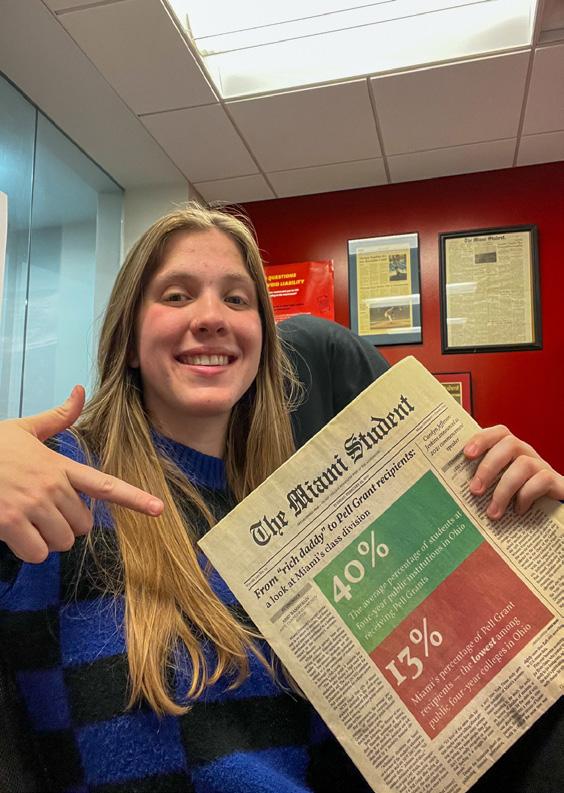
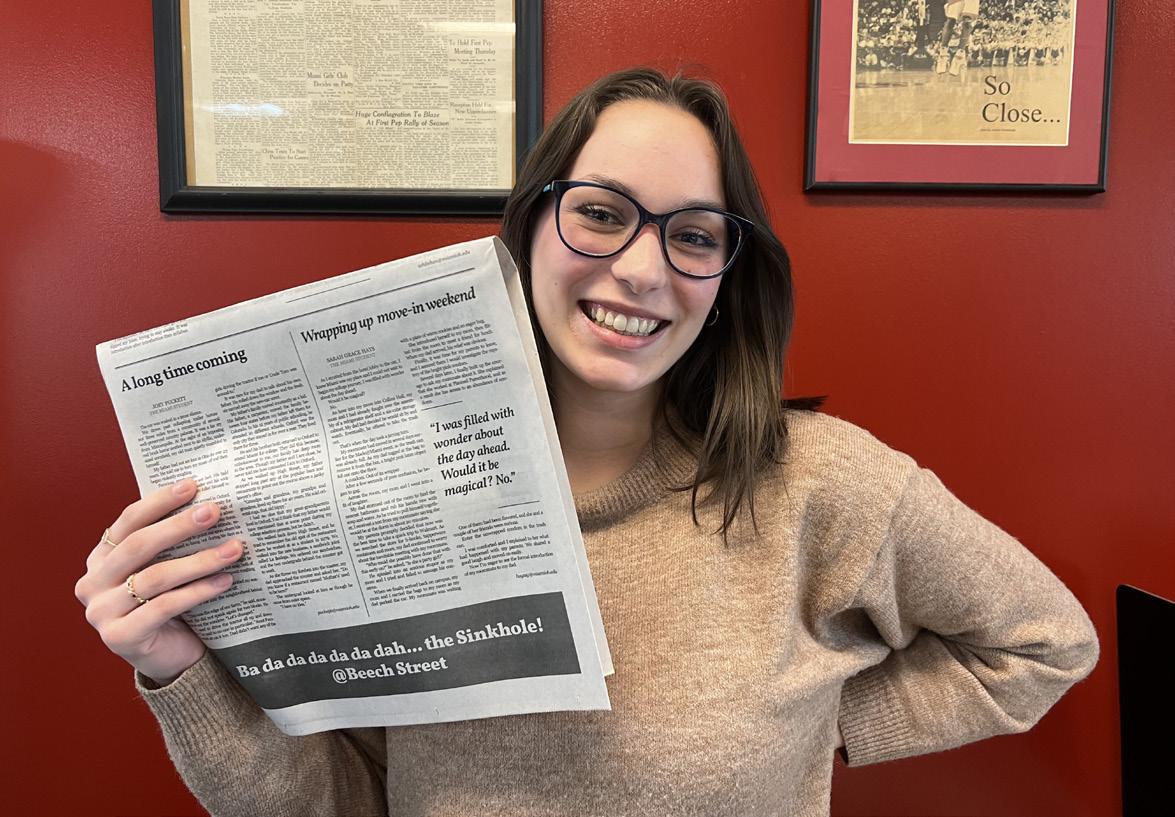
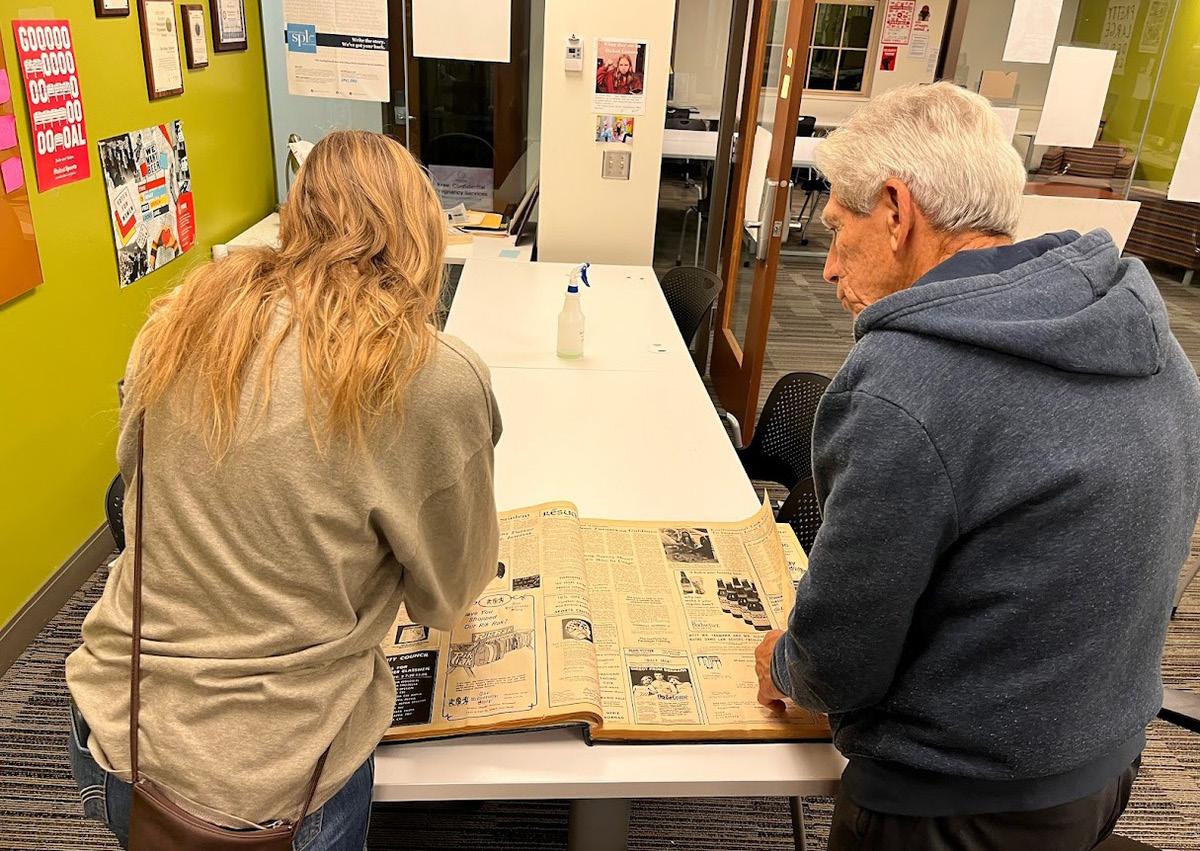
You’re awesome, I’m awesome and wasting energy on self-doubt is a disservice to your time in college. Now is the time to make mistakes, to take risks and learn who you are.
To everyone at The Student, I love and appreciate everything you have given me and this university. I would not be who I am without you.
hayssg@miamioh.edu
FRIDAY, MARCH 17, 2023 Opinion 12
GUNTERSTRATTON EDITOR-IN-CHIEF In a Sept. 25, 1970, issue of Miami University Middletown’s student newspaper KAOS, you can find the first time my dad, Mike Stratton, was listed as Editor of the publication. Now, 53 years later, I sit and write my last addition to The Miami Student newspaper as the Editor-in-Chief, and you can find the same last name adorning the page that did all those years ago.
we’ve traded typewriters
COSETTE
Though
THIS WEEK IN OPINION, WE SAY GOOD-BYE TO OUR RETIRING SENIOR EDITORS AND WRITERS AS OUR 2023-2024 STAFF STEP INTO THEIR NEW ROLES. GRAPHIC
SOREN MELBYE
BY
SARAH GRACE HAYS AUDIO EDITOR
or even having too much to say, but from the fear that what I have to say isn’t good enough. It’s a feeling with which I am intimately familiar. The idea that my words aren’t valuable enough, or that my thoughts aren’t meaningful to anyone other than myself. This feeling has plagued my time in college and my time at The Miami Student, but it is also the reason I have grown so much. As a freshman, when I first got involved with The Student, I was faking it. I didn’t know
As I sit down to write this, my fingers hover over the keyboard for longer than they should. My hesitation doesn’t stem from not having anything to say,
AUDIO EDITOR SARAH GRACE HAYS WITH HER FIRST STORY IN THE PRINT EDITION OF THE MIAMI STUDENT. PHOTO BY SEAN SCOTT OUTGOING EDITOR-IN-CHIEF COSETTE SHARES HER EDITORSHIP
HER DAD, FORMER EDITOR
MIAMI
MANAGING EDITOR ABBY BAMMERLIN STARTED WORKING FOR THE MIAMI STUDENT HER FIRST DAY ON CAMPUS. AND NOW THAT SHE’S TRANSITIONING OUT OF LEADERSHIP, SHE COULDN’T BE MORE GRATEFUL. PHOTO BY ABBY BAMMERLIN
EXPERIENCE WITH
OF
MIDDLETOWN’S
PAPER KAOS. PHOTO PROVIDED BY COSETTE GUNTER-STRATTON
The one who always had too much to say … and still does
erhouse team and fantastic mentors to me; however, they (along with the rest of the editing team) ripped this first article of mine apart.
My first article had a total of 306 edits. For context, my most recent article had 3.
Words were changed, sentences torn apart and stitched back together, entire sections were removed and new ones added. Worst of all, at the very end, a dreaded comment from Tim: “Ames we can work on this at budget.”
ing my life.
Suddenly, my confidence was back. It wasn’t that I was a bad writer — it was just that I had too many opinions to write for any other section! I dove headfirst into writing for Opinion and worked my way up through assistant editorship to my current position of Opinion Editor.
I also dabbled in other sections, including Campus & Community again, once I regained this confidence in myself.
lin about literally anything — she’s the best listening ear I know. I can bring any TMS problem I have ever had to Cosette Gunter-Stratton and she will always come up with a solution. I can throw last-minute changes at Soren Melbye and Macey Chamberlin and know they can roll with the punches. I can call Teddy Johnson my little brother, even though we’re not related in the slightest.
AMES RADWAN OPINION & FOOD EDITOR
My first word was “doggy.”
It may have been my first, but it certainly wasn’t my last; once I started talking, it became near-impossible to get me to shut up. I often got in trouble for my “smart mouth” in elementary school, sass oozing through my every pore whenever I felt the slightest disdain for my teachers’ ways of instruction. I may still hold the record for most referrals in a single day there.
(If any of my elementary school teachers happen to be reading this, let me just say: Oops. Sorry you had to deal with that.)
Truth be told, I just had a hard time keeping my opinions to myself. I have big thoughts, and what’s the point of having them if not to share them?
You might think I’ve learned to keep my opinions to myself since elementary school.
You would be wrong.
I’m 22 now, and I’m still just as loud, open and blabber-mouthed as I was at the age of six. My thoughts, proclivities and dislikes make their
way into every sentence I speak — and every sentence I write.
When I joined The Miami Student as a first-year in the fall of 2019, I didn’t think that would be a problem.
I didn’t realize that journalists work extra hard to keep their personal opinions out of their stories — unless they’re in the Opinion section, which I wasn’t. Despite now being the Opinion editor, I actually got my start in Campus & Community.
My first article was about the Diversity & Inclusion Forum on Sept. 18, 2019. Though it may look like a completely unbiased and impartial article now, my first draft was full of outrage and disbelief. How could all of these issues still exist on Miami’s campus? It was 2019, for Pete’s sake!
It’s been three and a half years since that forum, and yet some of the stories I heard that day still stick with me — because I feel that strongly about pretty much everything. My love for strong feelings, however, was not shared by assistant news editors Tim Carlin and Briah Lumpkins.
Tim and Briah would go on to become The Student’s Editor-in-Chief and Managing Editor, respectively, for my junior year. They were a pow-
I showed up to the budget meeting to fight some of the edits, like the editors removing the Oxford comma from my article (even today, I’m still frustrated that we don’t use the Oxford comma in AP style). I left the budget meeting with one feeling in mind: that I was too opinionated to ever write for a newspaper again. My own personal thoughts had, once again, shown too much, not in my speech this time but in my writing. I had always considered myself to be a great writer, and after that meeting, my hopes were dashed.
I quit The Student.
It’s fine to quit things — I ended up doing more of that during college, having overcommitted myself. But, at the time, I felt so ashamed. Here was my smart mouth, once again, ruining things for me.
My knight in shining paper came in the form of Kate Rigazio.
A senior and the Opinion editor during my first year, Kate invited me to an Opinion section meeting. Maybe she’d heard about my overly-opinionated style of writing — I have no idea — but, either way, I showed. I shared my ideas. I ended up writing an Opinion piece.
A few weeks later, I got my first validation in an email from Kate about my article: “It was well writ
ten.” Four short words ended up chang-
This will be my 62nd article for The Miami Student. At this time, I’ve written for every section except for Sports. (That will change soon, Jack, I promise.)
I’ve covered everything from first impressions to gun violence, grief to all-day breakfast, the Friendship Tree to Bell Tower, potato rankings to being from Florida and lots and lots of coverage on Valentine’s Day. And that’s just a few of them.
If you had told me, when I was quitting The Student in October 2019, that I would not only return to the paper but also end up becoming an editor of two sections and a prolific writer, I would have laughed in your face.
But words fail me for the first time in my life as I try to describe how glad I am that I returned.
My TMS family is unlike any other found-family I’ve ever had. We share a sense of togetherness that can only be borne out of a common passion. We work together as a team, not because we need to, but because we want to. We are friends and family, in the purest sense.
I can ask in our Slack chat for a picture of a specific tree on campus and, 10 minutes later, it will be in my inbox, courtesy of Luke Macy. I can invite the entire TMS staff to my 22nd birthday party, where Taylor Swiftthemed costumes were mandatory, and have them show up all in costume — Reece Hollowell slaying in a “The Man”-themed suit and Hannah Horsington in a handmade “Junior Jewels” shirt, to name a few.
I can complain to Abby Bammer-
When I need a last-minute Food article, I can always turn to Maggie Peña. When it’s a newsroom chat between classes, I go to Meta Hoge. If it’s a board game partner or presidential running mate, Reagan Rude. If it’s an Opinion graphic, Hannah Potts — or a good game of Hangman, Sean Scott.
If it’s the best assistant editor/ gossip partner/tattoo enthusiast/ bagel arguer I could have ever asked for, I need to look no further than Devin Ankeney, my partner in crime, lamp-fixing and Opinion at The Student for the last year.
There are dozens of other people who’ve impacted my time here at The Student in ways I can never thank them enough for. If you’re someone I’ve interviewed, talked to, laughed with, written about or anything else related to the newspaper — all I can say is thank you, and I can’t say it enough. Thank you, thank you, thank you.
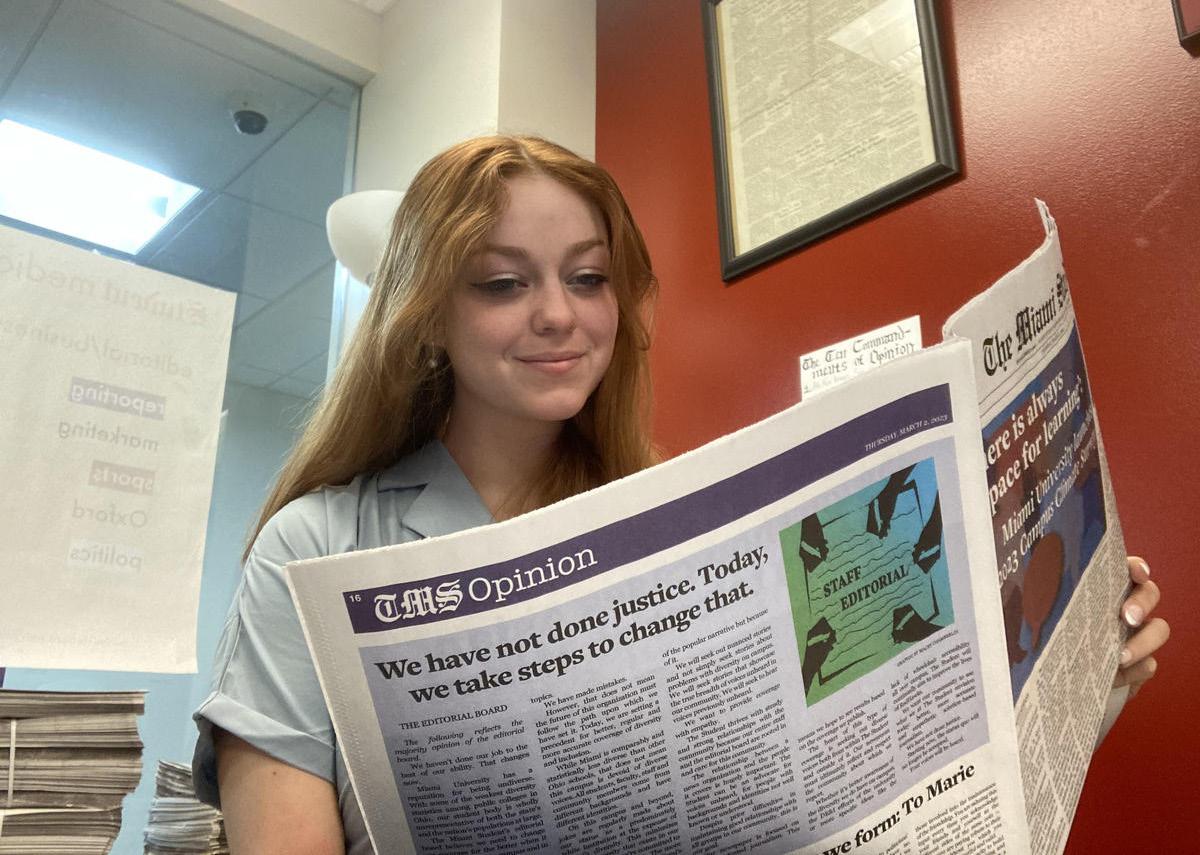
To all of my future loudmouthed, outspoken Opinion writers who have ever been told they have a smart mouth or they talk too much: no, you don’t. You are just fine the way you are.
I found the right outlet — and the right people, too, with it. Your outlet is out there. Your adventure is out there. You just have to go out and find it.
radwanat@miamioh.edu
I’m not a journalism major — but I’ll miss pretending to be one
— that all gets replaced by “alumnus” and “former writer” as I dive into the world beyond school. So, I figured I’d start this with a story.
Chicago and watching a historic victory for the RedHawks over Northwestern — but others are simpler — an outing to the Hueston Woods beach, a game night at the newsroom.
“Michael Vestey, urban
regional planning major, Senior Staff Writer at the Miami Student”
On Sept. 15, 2019, in the fall of my first year, I reached out to then-Sports Editor Chris Vinel — a simple email, to schedule a meeting about beginning to write about sports for the paper. Exactly a month later, having interviewed two future NFL players and being rebuffed by a Congressman, my first article ran at the top of the front page. For the last four years, every column and article that I’ve written here — whether about college football, the political topic du jour or my beloved FC Cincinnati — has been with that memory in the back of my mind. I’ve made plenty more memories since then, as well. Some of them are flashy, sure — interviewing some of the most important people in college football, visiting the impressive Ryan Field in
I’m not a journalist. During my time writing for The Student, I’ve been asked, usually by friends and family, about any desire I had to launch a professional career here. And the answer, sometimes to my own surprise, has always been “no.”
Writing as a hobby, as a way to express something I’m interested in to however many people are willing to listen without any real stakes, is really what I’ve appreciated in my time writing for The Student. Being able to develop my own creative voice and have the room to express it in columns throughout my time here has been a truly amazing experience.
(And that’s one of the best sales pitches I can make from my time here.)
Really, I’m simply grateful. Hav-
ing a mentor in Chris who showed me the ropes, taking me along to his visits to football practices and giving me feedback on pitches and drafts, was absolutely invaluable in keeping me writing, and one of my few regrets from my time at Miami is not doing the same for someone else.
I can’t redo the past, but what I can do is look forward to the future.
If you’re a first-year or sophomore or even a high school senior reading this, you’re probably already interested in the paper, or even writing for it. All I can really say is: keep writing. Find something you want to talk about and there will be a person at this paper who will help you talk about it.
You never know — you might make some new friends along the way.
vesteymj@miamioh.edu
@VesteyTMS
Finding confidence and direction
my advisor asked if anyone would be interested in attending a workshop our publisher was holding at Miami. I thought “Why not?” and went with a friend. After the workshop was over, we were given a tour of campus. I instantly fell in love with it and decided pretty quickly that I had my heart set on going to Miami.
Picking a college to attend was never hard for me, but deciding on a major was.
I initially considered journalism because I enjoyed the work I did for the yearbook and thought that it would be something I’d really like, but I was hesitant to pick it because I was insecure about my writing skills.
In the fall of 2019, I came into Miami undecided and spent all of my first year trying to pick between a couple of different options. I felt like I was just floating through, hoping that somewhere along the way I would magically decide on what I wanted to do with my life. Time flew by, and all of a sudden sophomore year began and I still
didn’t have a major. I knew it was time to make up my mind, so I finally decided on journalism. I felt a little better once I picked a major, but I was still very unconfident in myself and what path I wanted to go down.
Looking back, I now know I just needed a little nudge in the right direction. During the spring 2021 semester, I took JRN 201 with Patti Newberry, who gave me the push I didn’t know I needed by suggesting that I join The Miami Student.
I’m so glad I did.
Through writing for both The Student and my classes, I’ve been constantly getting feedback on my work and learning what aspects I need to work on.
I know I could continue to improve, but I’ve come a long way since my first journalism courses in fall 2020.
Because of this, I was finally able to shake some of the doubt I had in my writing ability.
Beyond writing, I’ve been lucky enough to meet and build friendships
with some pretty cool people.
I’ll miss having classes with familiar faces.
I’ll miss spending time in the newsroom in between classes and never getting any homework done because I was having too much fun goofing off with other staffers.
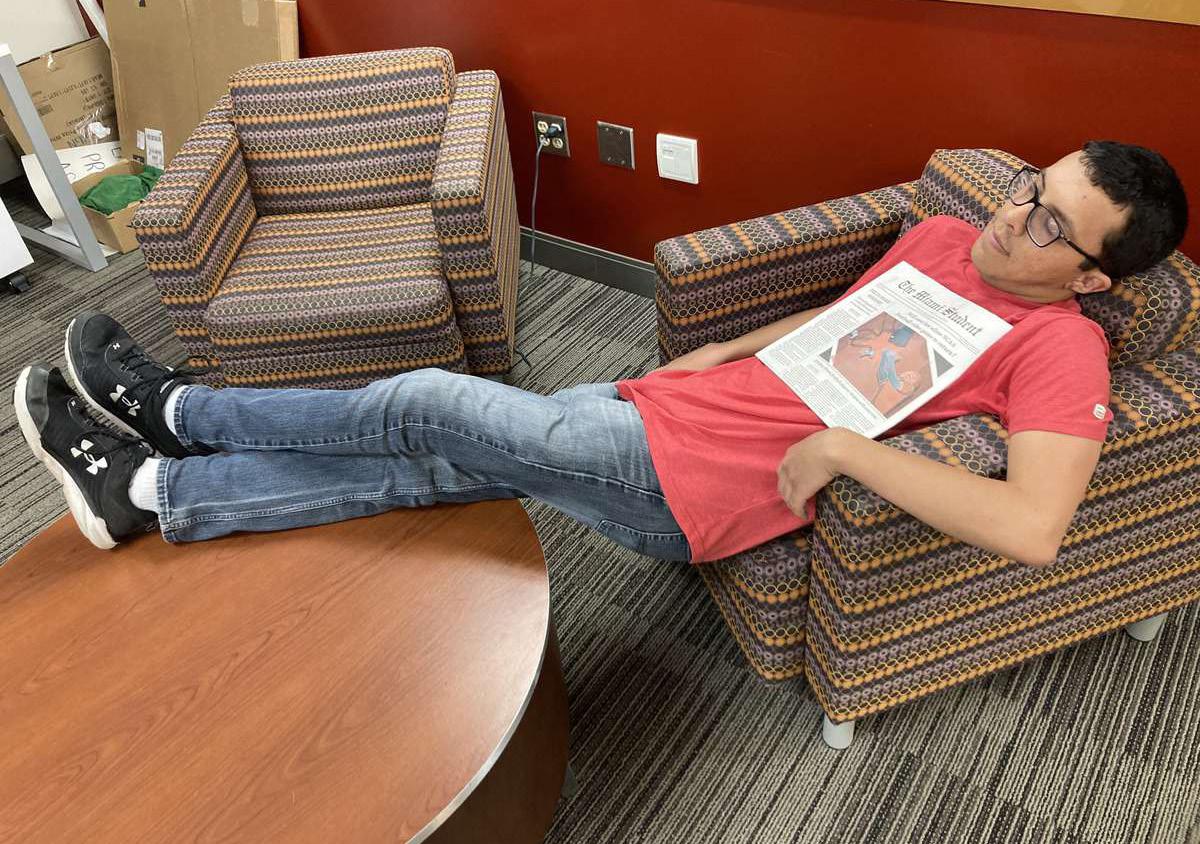
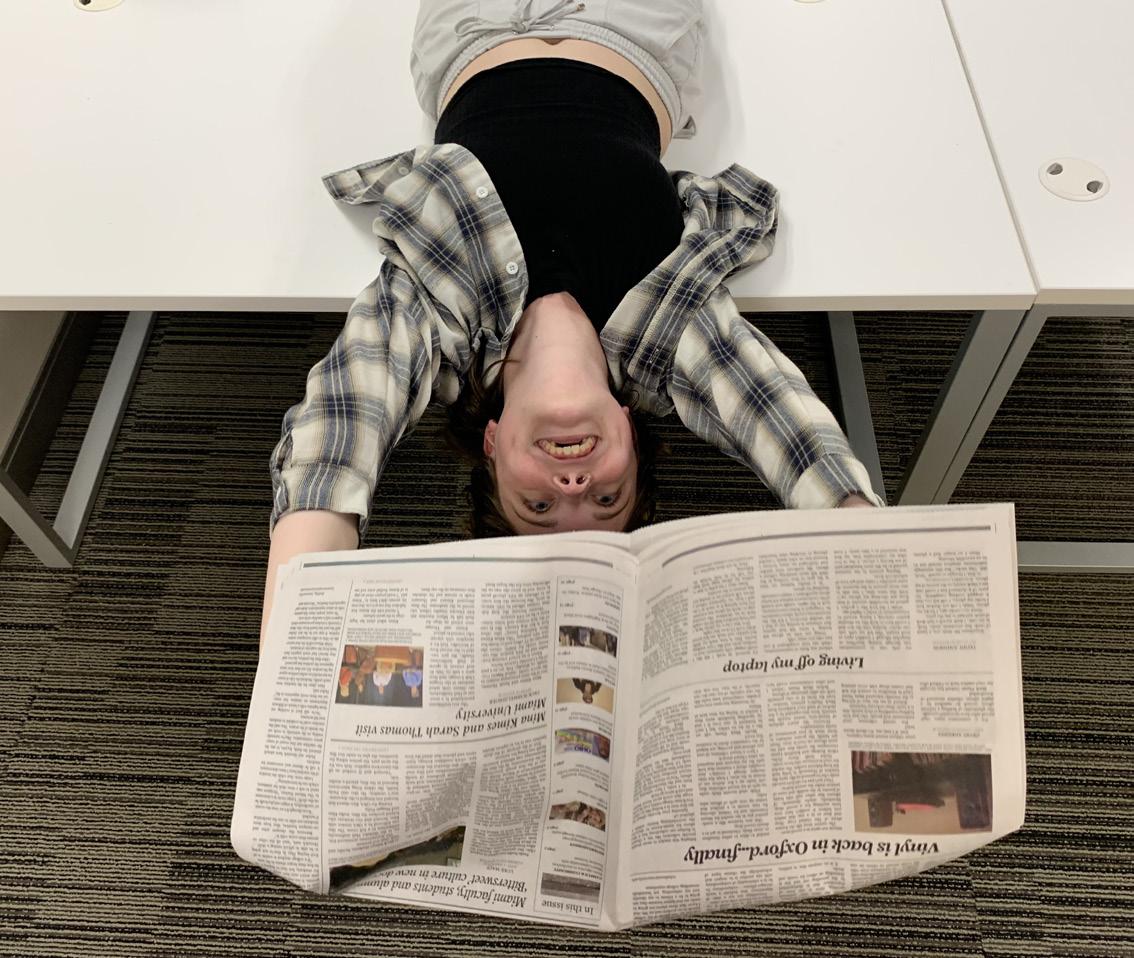
I’ll miss the things that happened at social events that made me laugh so hard I cried, like Sean Scott’s graphics for his presentation on “Dune” for our most recent PowerPoint night.
There are so many more reasons why I’m glad I joined The Student, and it would be impossible to list them all here.
So thank you, TMS, for taking someone who lacked confidence and direction and giving her another community, as well as helping to make her feel like she made the right decision in picking journalism as a major.
I’m so grateful for you and I’ll miss you dearly.
-
FRIDAY, MARCH 17, 2023 13
MICHAEL VESTEY SENIOR STAFF WRITE I didn’t really know how I wanted to start this. And as I start writing this out, I’m not sure how it’ll go.
goodbye is rarely easy, especially when it’s to something so meaningful that it becomes a part of your identity.
Saying
and
META HOGE SENIOR STAFF WRITER Despite growing up about two hours away from Miami University, I’d never heard of it until my sophomore year of high school. I was in my first year on the yearbook staff, and
@meta__hoge hogemh@miamioh.edu
SENIOR STAFF WRITER META HOGE IS KNOWN TO “HANG” AROUND THE NEWSROOM IN HER FREE TIME. PHOTO BY REECE HOLLOWELL AND AMES RADWAN
MICHAEL VESTEY TAKES A WELL-NEEDED NAP WITH HIS COMFORT ISSUE (THE ONE WITH HIS FIIRAST EVER STORY ON THE FRONT). PHOTO BY AMES RADWAN
OPINION AND FOOD EDITOR AMES RADWAN SERVED THEIR EDITORIAL TENURE WITH LOUDMOUTHED PRIDE. PHOTO BY AMES RADWAN
LEXI WHITEHEAD, SENIOR CAMPUS & COMMUNITY EDITOR
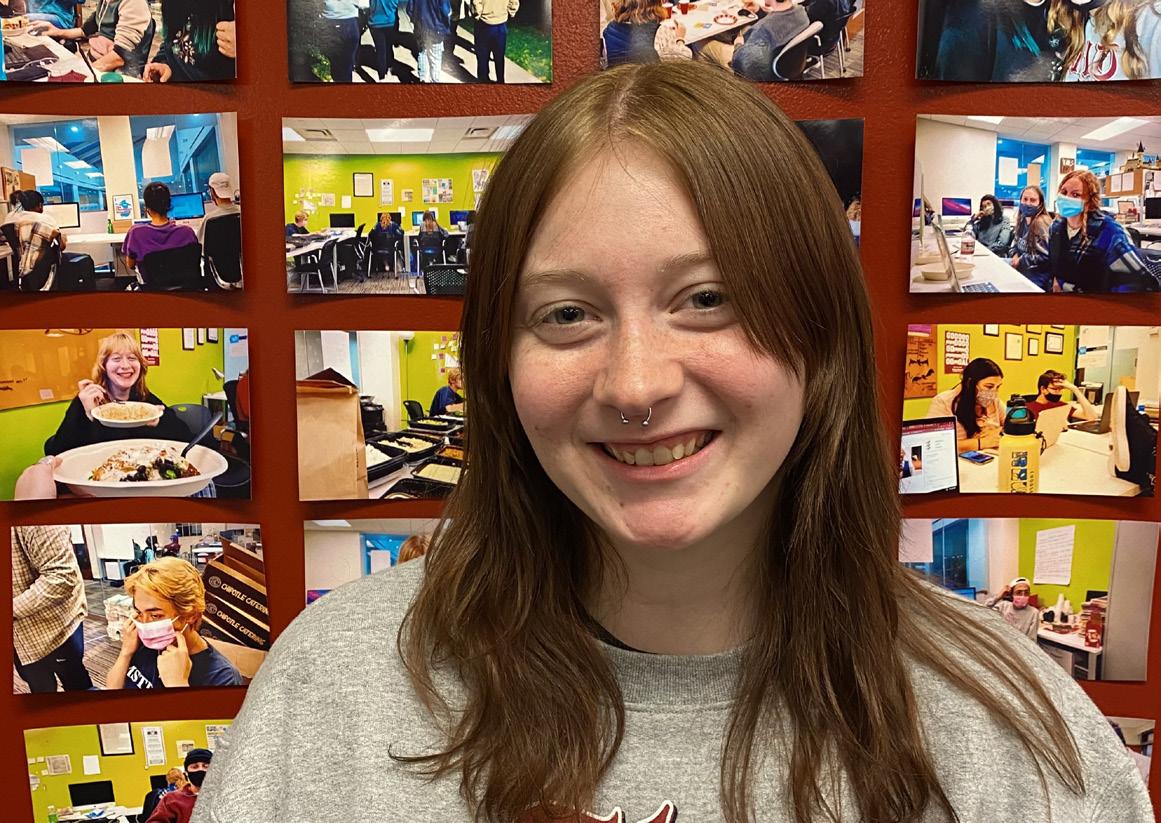
When I first came to Miami Uni
versity, I knew I wanted to do one thing: join The Miami Student. But I could have never known how important the newspaper would be to my college experience, how many meaningful relationships it would bring me or how hard it would be to say goodbye.
While I have learned many invaluable lessons about journalism from
Closing a chapter
were both journalism majors, writing scholars, residents of Thomson Hall and aspiring TMS writers. If we didn’t become friends, we would’ve had to put up with each other anyway.
During that first year, you were always the person by my side at TMS social events, saying things like “I’ll go if you go” and deliberating over the right outfits to wear. Three years later, we’re the ones planning those events and encouraging the timid freshmen that we once were to come hang out with us.
Thank you for sticking by my side from day one until the last. I came to campus scared about how I was going to make friends and you showed up and made it easy.
take over as Editor-in-Chief. Thank you to whomever decided to bring us up together because I got a new friend and someone to learn with at the same time.
You’ve been the mom friend calling the pizza place when they forgot our cheesy bread because no one else wanted to, making sure we had food at all our productions and hosting “spag nights.” But, you’re also always down for anything I ask, and I won’t forget our numerous impromptu adventures, even if they didn’t always pan out.
you, but I look forward to seeing what you do next.
To everyone else on staff, past and present, thank you for making TMS a place where I felt welcome and comfortable to learn and grow. Thank you for supporting me as a writer, and thank you for letting me be a part of something bigger than myself.
My love for this newspaper and for you all has only grown over the years.
-
my time at The Student, they will never compare to the lifelong friendships I’ve made on staff. I’ve joked before that I don’t have any friends outside of the newspaper, but it’s not really a joke.
So, I wanted to take this time to say thank you to the people who made the stress of college and running a newspaper a little more bearable.
To Hannah Horsington, my first friend on campus, I’ll never forget the time you walked into my dorm room on the day I moved in because I knew we would be fast friends. We
To Maggie Peña, my partner in crime, thank you for always looking out for me and always participating in my shenanigans. I’m so grateful to have not one, but two friends stick by my side for all four years of college.
We wrote our first breaking news story together and got to interview Sean Astin. But nothing is more special to me than having you around on a normal day, me sitting on your dorm room floor sophomore year, going on walks to vent junior year and carpooling to meetings this year.
To Cosette Gunter-Stratton, who inspires me every day, I admire all the hard work you’ve put into this newspaper, from becoming assistant culture editors together to watching you
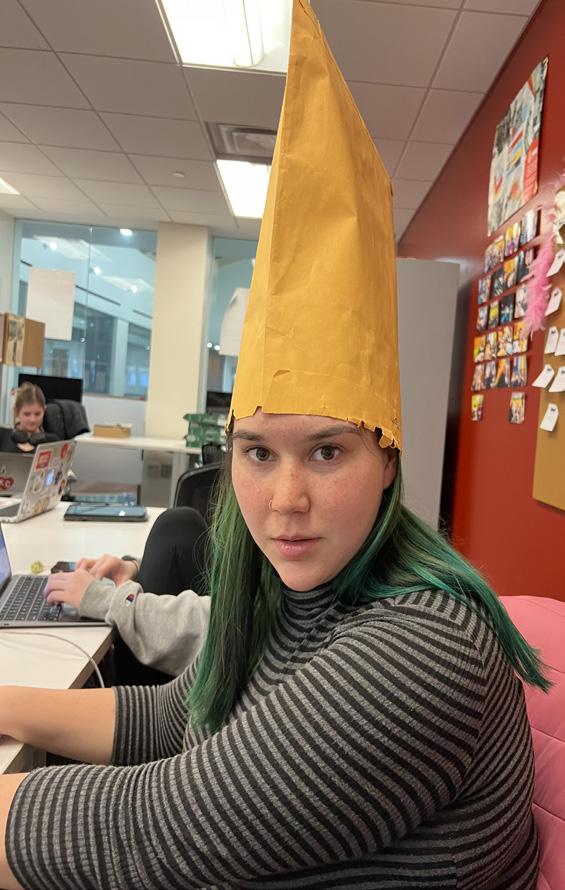
To Sean Scott, the new Editor-in-Chief of The Student, I remember seeing your byline in the newspaper during the first semester of my sophomore year and thinking, “Who is this kid?” You were and are an amazing writer, and I was honestly a bit intimidated. We became friends later that year, and soon enough we were running the Campus & Community section together.
You were the best co-editor I could ask for, always on top of the things I wasn’t and never taking things too seriously. More than anything, thank you for letting Hannah, Maggie, Cosette and I adopt you into our friend group.
I’m so proud of you, because even though I was amazed by your first few bylines, I’ve gotten to watch you continue to break the scale and I know you’ll keep doing just that. I’ll miss
On Sunday, after our editor-in-chief elections, several of the staff piled into my living room for an Oscars watch party hosted by Maggie. I never had much interest in watching the Oscars, but I didn’t want to miss a chance to be with everyone I have grown so close to these few years.
We ate pizza and laughed and talked over the commercials and categories we cared less about, and I thought how hard it was to think about it all coming to an end soon.
It’s like reading a really good book, one so good you never want to flip the last page. You want to savor it as long as you can but, as you go on, the number of pages diminishes until there’s none left. And you simply have to face the reality, close the book and move on to another one.
I don’t know what’s in store for me next, but I can only hope it’s as good as what these past four years have offered me.
@nwlexi
whitehan@miamioh.edu
An open letter to the TMS newsroom
new to campus and professional journalism, scared to dive right in, but about to do it anyway.
And I’m so, so grateful I did.
Between classes, you’re my goto, whether I’m doing last-minute homework, watching Netflix and eating a spicy chicken sandwich from Pulley’s or even taking a quick nap on the table. Having a space that I know won’t be crowded or loud has done so much for me on busy class days.
HANNAH HORSINGTON
VIDEO EDITOR

Dear The Miami Student Newsroom,
To some, you’re just another random office in Armstrong. To me, you’re the place I’ve called home for the past four years (well, more like three … thanks for nothing, COVID-19).
The first time I stepped foot in-
side and saw those bright green walls, rows of computers and stacks of papers, I was intimidated. Very intimidated. I remember thinking, “Wow, this room is so professional, and everyone in it is so put together.
I’m not sure I’ll ever be as good as them.”
And then I saw the big Lego Hogwarts sitting in the center of the room, and I knew I would fit in.
So there I was, a first-year, brand-
On Sundays, you’re the place I get to recap with all my friends about Saturday night shenanigans. In fact, you’re the place I made most of my friends. During my first year, you’re the place where I found other first-years who had interests similar to mine. As time went on, I made friends with people older than me, people who were always there to give me guidance in all aspects of life, from a career in journalism to dropping out of sorority recruitment.
And then, slowly, I became the upperclassman, and I found myself making friends with people new to The Student. Suddenly, I was the one providing guidance and think-
ing back fondly to when life wasn’t all about graduation and job applications and leaving all of my friends.
And, one day, I realized that maybe those people I was so intimidated by years ago didn’t have it all together all the time. Do any of us, really?
As I’ve gone from a scared firstyear to a confident senior (yet one who’s still trying to figure life out), you’ve been the constant thread that has kept me grounded. No matter what, you, TMS Newsroom, were always there.
In fact, you’ve allowed me to share things with my friends when I needed it most.
We joke that I like to “trauma dump” to other staffers in the newsroom. But everyone needs a space to unload the thoughts that are weighing on them or to talk through difficult situations, and you’re that place for me.
Throughout college:
My childhood best friend eloped

My divorced-for-13-years parents got back together
A global pandemic shut down the world And so, so much more. But every
time, you were there for me, Newsroom. I’d sit among your lime green (now red!) walls, spill everything to my friends, maybe yell or cry a little and, in the end, I’d feel so much better.
So thank you, TMS Newsroom, for giving me a place to share the ups and downs of my life. Thank you for giving me a place to cram for an exam at the last minute or set a timer to sleep for exactly four minutes before class. Thank you for giving me my best friends, and a place to cry about how sad I am to leave them.
Thank you for giving me a place to share all the craziness that inevitably follows me, from a massive sinkhole opening up in my hometown to stories about my god-awful middle school sex-ed teacher. I was voted “most likely to tell the wildest hometown stories,” and you gave me a place to tell them, Newsroom. Thank you for giving me a place to be me.
Love you forever, ASC 3018.
Hannah horsinhp@miamioh.edu @hannahorsington
Headline: The thing I was always worst at
I vowed to never write for the publication again and to quit journalism altogether (yes, I was dramatic and yes, I am still just as dramatic).
Four years later, I’m leaving the newsroom an Entertainment Editor-at-large with 52 bylines for written stories under my belt.
More important than that, I’m leaving the newsroom a different person.
A more confident person.
My first year at Miami University, I cried to my journalism professor and the advisor to The Student at the time, James Tobin. As I sat in a hallway in Williams Hall, I told him I was a horrible writer, that I would never be able to make it in the professional world of journalism — that I would never compare to my amazing peers.
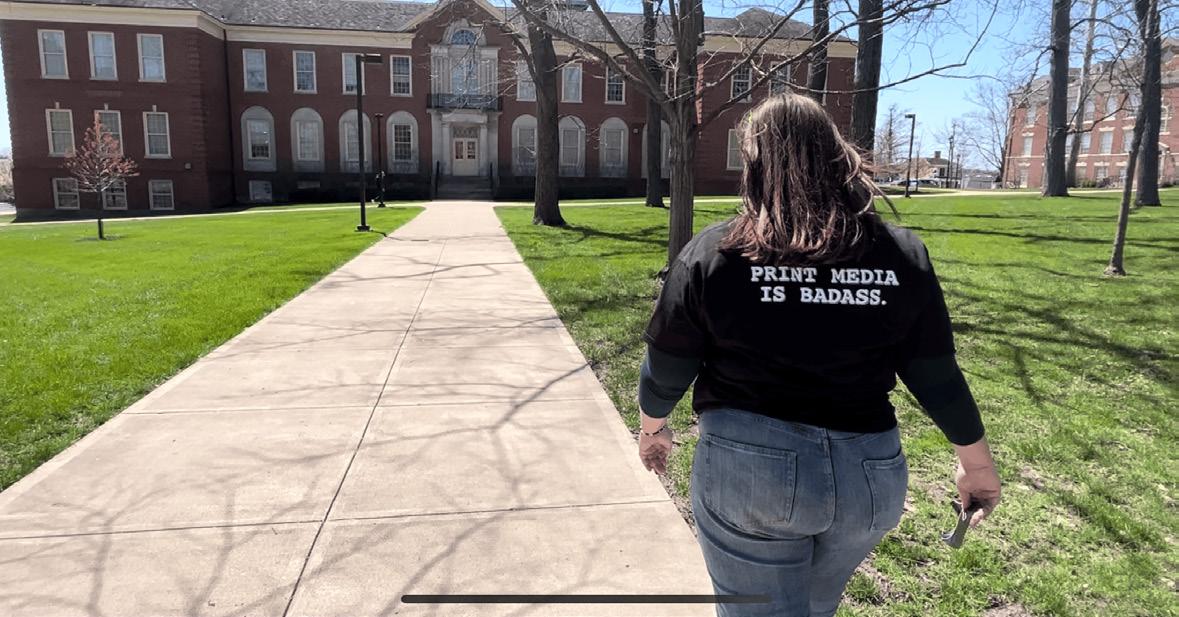 PEÑA
PEÑA
My first story for The Miami Student looked like a Christmas tree lit up with red, green and blue strikethroughs from various editors. By the end of the story, it was as if I’d never even touched it.
I don’t remember exactly what he said that day, but essentially he told me to not give up, that I had a gift for writing and for telling stories and that I was one of the more gifted students he had worked with. And boy, am I glad he told me that.
That conversation, which I’m sure he barely remembers, changed my life. I stuck with journalism, and I returned to The Student with a renewed passion for writing.
I started my editorial journey as a co-multimedia editor. I was one of the youngest editors ever, getting the position de-facto after the previous edi-
tor, Ben Deeter, graduated. I enjoyed my time in that role, and I learned a lot about myself as a leader. But two years, 18 podcasts and a pandemic later, I wanted to move on. Desperately.
So, I quit.
I didn’t quit the paper, but I laid to rest my time as an editor of podcasts in favor of becoming an editor for written sections. My favorite section to write for was Entertainment and, after working under some of the best editors I’ve ever had, Will Gorman and David Kwiatkowski, I had honed my craft of movie reviews and cultural criticism pieces. I became an assistant entertainment editor, and the rest is history.
I have written several entertainment pieces and edited countless of them. I love that there is a place to discuss and criticize the thing I love most — media.
I’ve gotten to run the section with one of my best friends, Sean Scott, The Student’s newest Editor-in-Chief (you’re gonna do great, bestie). And who could forget my friend Reece Hollowell, the most verbose and talented writer I know (keep up the great work with the graphics, too #neverforgetTheWifeGuys).
After my departure from Multimedia, I also became an assistant Campus and Community editor. I got to know some of the best people I’ve met at Miami. Reagan Rude always
has a quip or a sarcastic comment at the ready, which keeps the energy alive in the newsroom. Alice Momany is one of the sweetest people I know, and I’ll miss having her as an editor (she always leaves the nicest comments). And Luke. Oh, Luke. Every time you come into my sight, I want to fight you. And yet, I can’t help but acknowledge how talented a writer you are and how cool a person you are. You’re one of the most fun people to hang out with, and I will genuinely miss talking to you about movies and my incomplete in FST 301 (but don’t worry, I will still want to fight you for the foreseeable future).
And where do I even begin with my best friends, Lexi Whitehead, Cosette Gunter-Stratton and Hannah Horsington? You all have been my rocks these four years. YOU all have helped me grow the most.
Lexi — I love you. I love how you’re always there to listen to me when I have a problem. I love how you are always there to help me choose an outfit. I love that we can say we’re going to sit in our living room to do homework, and then end up gossiping and getting nothing done. I’ll never forgive you for barking at me … but I will miss you infinitely after we graduate.
Cosette — I love you. I love our talks in the car whenever I need a ride and you volunteer. I love that you have become an honorary roommate
of mine, Lexi’s and Hannah’s. I have loved seeing you grow in your role as Editor-in-Chief, and I will forever be grateful I had you as a fearless leader for my final year at the paper.
Hannah — I love you. I love how organized you are, how you’re the mom friend of the group. I love how you feel comfortable telling all of us about your worries, and I love that you are a listening ear for me. I have loved seeing you grow in your passion for broadcasting.
I love you all, and I hope we’ll always talk every day like we do now.
Through all of that — the editorial changes, the myriad of edits, the relationships that have come and gone — I’ve grown.
I’ve grown in my leadership skills. I’ve grown in my confidence. I’ve grown in more ways than I can say.
I guess all I can say is thank you, The Miami Student. You’ve been the best college experience I could have asked for. penaml@miamioh.edu
FRIDAY, MARCH 17, 2023 Opinion 14
MAGGIE
ENTERTAINMENT EDITOR
I
A lot.
cried.
FOR LEXI WHITEHEAD, THE MIAMI STUDENT HAS BEEN A PLACE TO GROW AS A JOURNALIST, AS WELL AS A PLACE SHE COULD BE HERSELF AROUND ALL HER BEST FRIENDS. PHOTO BY HANNAH HORSINGTON THIS WEEK IN OPINION, WE SAY GOOD-BYE TO OUR RETIRING SENIOR EDITORS AND WRITERS AS OUR 2023-2024 STAFF STEP INTO THEIR NEW ROLES. GRAPHIC BY SOREN MELBYE VIDEO EDITOR HANNAH HORSINGTON JOINS THE VIRAL TIKTOK SENSATION, A “WHAT ARE YOU LISTENING TO?” VIDEO. PHOTO BY BESTIE MAGGIE PEÑA OUTGOING ENTERTAINMENT EDITOR MAGGIE PEÑA WILL MISS ALL THE FRIENDS SHE HAS MADE AT THE MIAMI STUDENT AND ALL THE FUN TIMES THEY HAVE HAD TOGETHER (INCLUDING THIS MANILA ENVELOPE HAT). PHOTO BY SEAN SCOTT
Senior Wills
Abby Bammerlin, Managing Editor
To Luke Macy: I leave you my position but, more importantly, I leave you my chair, so enjoy the power. Finally, I leave you all my pineapple gummy bears. Consume responsibly.
To Sean Scott: I leave you my will to live. You’ll definitely need it for the new gig!
To Macey Chamberlin: I leave Slack DMs to use during the next class you have with a TMSer. I also leave you the master key to the TMS Drive, so please stop calling me.
To Devin Ankeney: I leave you our fan. Don’t let it ever get stolen again!
To Jack Schmelzinger: I leave you all my sports knowledge; it’s not a lot.
To Jake Ruffer: I leave you Luke Macy. Sorry about this one, it sounds like he’s going to be making you do a lot more work.
To Reece Hollowell: I leave you the responsibility to create every graphic for every story.
To Teddy Johnson and Patrick Sullivan: I leave you an AP Stylebook and the resilience to fight your new editors. Good luck!
To Fred Reeder: I leave you a newsroom full of the most capable and knowledgeable student journalists I know. And a bottle of Scotch for when they’re not.
Ames Radwan, Opinion & Food Editor
To Devin Ankeney: I leave the Opinion section. I have had the pleasure of watching you grow and flourish as a person, as a writer and as an assistant editor over the past year, and I have no doubt that this growth will continue to trend upwards during your tenure as editor. I also leave you the responsibility of fighting Fred Reeder about Opinion articles, my boundless energy and the promise that if you ever take down the Ten Commandments of Opinion, I will haunt you until the day you die. Go get ‘em, bruh. <3
To Kaitlin McDowell: I leave the Food section. May your fresh pair of eyes, love for journalism and full stomach guide the section and your own college journey to new heights.
To Jack Schmelzinger: Go Bolts!
To Soren Melbye: I leave my deepest apologies for always saddling you with last-minute changes to the Opinion spread. But I can’t promise that’ll change under new management.
To Reece Hollowell: I leave my Taylor Swift addiction and burger baseball. #slay
To Macey Chamberlin: I leave the title of coolest ginger on staff. You technically already held this, but, you know. Now it’s official.
To Teddy Johnson: I leave the responsibility of causing as much chaos during production night as humanly possible. Love ya, Teds.
Cosette Gunter-Stratton, Editor-in-Chief
To Sean Scott: I leave Patti Newsberry, as is tradition. You and Luke have to put a little heart with your names on it in the back.
To Devin: I leave charge of decorating decisions in the newsroom. I trust you.
To Luke & Alice: I leave custody of Teddy.
To Macey: I leave the title of Queen of the Newsroom. I never had this title but I still want you to have it.
To Jack & Jake: I leave the title of best duo. Abby and I are graduating out of this role.
To Reece: I leave being the loudest person in the room at any time. I also can be loud and I appreciate this about you.
Hannah Horsington, Video Editor
To somebody. Anybody. Please: I leave the video section.
To Alice Momany: I leave the position of co-social chair. TMS formal WILL happen one day!
To next year’s multimedia team, whoever you may be — I leave the TMS TikTok (follow us @themiamistudent). Bonus points if there are more videos of staffers slapping each other with newspapers or throwing shit at Teddy.
To Megan McConnell: I leave custody of Jack Schmelzinger’s coat that’s been at our house since Christmas, since he can’t be trusted to come get it. Jack, we definitely didn’t leave anything in the pockets. <3
Lexi Whitehead, Senior Campus & Community Editor
To Alice Momany and Reagan Rude: I leave the Campus & Community section. I was there when the section was born, so take care of it for me. I also leave the tradition of the C&C walk and all the games we’ve made up.
To Macey Chamberlin: I leave the co-social chair position. Continue to throw banger social events.
To Sean Scott: I leave having the best taste on the production playlist.
Maggie Peña, Entertainment Editor
To Sean Scott: I leave you the corner seat of the newsroom (not that it was mine to give, but I want to ensure you keep it). I also leave you Reece; please keep him in check (I worry about the graphics he will create … just kidding, Reece is an incredibly capable editor and I trust him infinitely. Also pee pee poo poo).
To Reece Hollowell: I leave you the Entertainment Section. Please take care of her, we’ve worked hard to make her what she is. Also, I leave you the power to continue creating beautiful, immaculate, incredible graphics. (Also, pee pee poo poo).
To Luke Macy: I leave you nothing. (I am kidding, I leave you my incredible sense of humor and the power to bully Sean. Also, pee pee poo poo).
Meta Hoge, Senior Staff Writer
To Kasey Turman: I leave the ASG beat. Thanks <3
To Sean Scott: I leave a pack of Mountain Dew. I know you don’t like it, but I think you’ll need the caffeine for being EIC. I also leave the ASG beat to keep re-assigning. To Reece Hollowell: I leave the ability to find someone else to brutally insult. Sincerely, Meerkat-Looking Ass
To Reagan Rude: I leave a singular ping-pong ball. I hope you continue to slay at pong. You missed 100% of the shots you didn’t take and 100% of shots you did take.
Michael Vestey, Senior Staff Writer
To Jack Schmelzinger: I leave my assumed duty to pitch and write about the least-Miami-related column ideas possible while still making them relevant enough to publish.
To Reece Hollowell: I leave my few Scrabble and Secret Hitler qualities so you can keep dominating game nights for the times to come (as well as my remaining chaotic energy to truly raise more hell).
To everyone and anyone: I leave my (attempted, at least) good and wholesome vibes to help drown out the pains you’ll take on from fighting admin and your evil boss editors.
Sarah Grace Hays, Audio Editor
To Reece Hollowell: I leave the Audio Section. One day, you will have the support of a full staff. I’m sure of it.
FRIDAY, MARCH 17, 2023 15
A day in the life of Maggie Murphy
JESSICA MONAHAN
ASST. PHOTOGRAPHY EDITOR

Maggie Murphy, the Miami University softball team’s standout sophomore infielder, breaks down her day into three parts: class, lifting and practice.



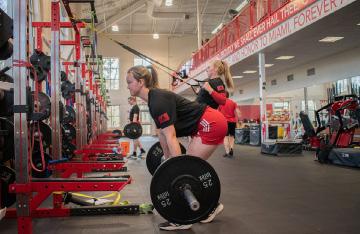

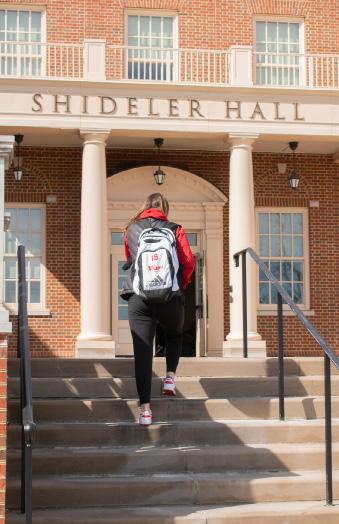

The data analytics major starts her Thursday with two classes, the second of which is GLG 111, The Dynamic Earth, located in Shideler Hall.
After class she makes off to Miami’s Walter L. Gross Jr. Family Student Athlete Development
Center with a handful of teammates and a strength coach. The ladies continually rotate through their exercises and ask their coach for pointers on how to get the most out of their exercises. Lifting sessions typically don’t take as long during the season, so there’s a break before practice at the field later in the afternoon.
Down at the softball field, Murphy attends batting practice, where she takes turns with a teammate between batting and loading the pitching machine. During batting practice, team-
mates help each other out creating a comforting environment where constructive tips are welcomed.
Then Murphy’s group heads outside to put their cleats on and grab sunglasses to practice catching and throwing with a partner.
Murphy’s favorite part of her day is “hanging out with my teammates whether it is at practice or just in the dorm.” The teammate atmosphere is friendly and full of laughs throughout both practice sessions.
monahaja@miamioh.edu
FRIDAY, MARCH 17, 2023 photo story 16
DURING LIFTING PRACTICE, ATHLETES USE SPECIFIED WORKOUT PLANS BASED ON THEIR NEEDS AND INJURIES. EVEN THE DIFFERENT WEIGHTS OF THE WORKOUTS ARE SPECIFIED BY A TRAINER FOR EACH INDIVIDUAL PLAYER. MURPHY LOCKS ON TO A MACHINE PITCH AT BATTING PRACTICE. SHE HAS A .273 BATTING AVERAGE THROUGH 44 AT-BATS THIS SEASON. MURPHY AND SEVERAL TEAMMATES GATHER IN MIAMI’S STUDENT ATHLETE DEVELOPMENT CENTER FOR THE NEXT HOUR AS THEY HAMMER OUT AN IN-SEASON TRAINING CIRCUIT. SEVERAL PLAYERS BRING IT INTO A HUDDLE TO ROUND OUT THEIR WORKOUT. THE TEAM INTERACTS A LOT DURING LIFTING SESSIONS, SHOWING SUPPORT WITH ENCOURAGING WORDS. MURPHY CLIMBS THE STAIRS TO SHIDELER HALL FOR HER 11:40 A.M. LECTURE, HER SECOND CLASS OF THE DAY. LIFTING SESSIONS CONSIST OF ROTATIONS WHERE ONE OF THE FULL BODY EXERCISES INVOLVES SIDE-STEPS WITH RESISTANCE BANDS. AS AN INFIELDER, PRACTICING CATCHING AND THROWING IS ESSENTIAL.


















 RYANN
RYANN



















 JACK SCHMELZINGER SPORTS EDITOR
JACK SCHMELZINGER SPORTS EDITOR











 PEÑA
PEÑA






